Angkor Wat is an ancient temple complex in Cambodia that was built in the first half of the 12th century during the reign of Suryavarman II. Dedicated to Vishnu, it was originally designed as the king's state temple and capital city but later moved to Hindu and Theravada Buddhist use. The site was declared a UNESCO World Heritage site in 1992 and is still preserved today due to its moat providing protection from jungle encroachment.
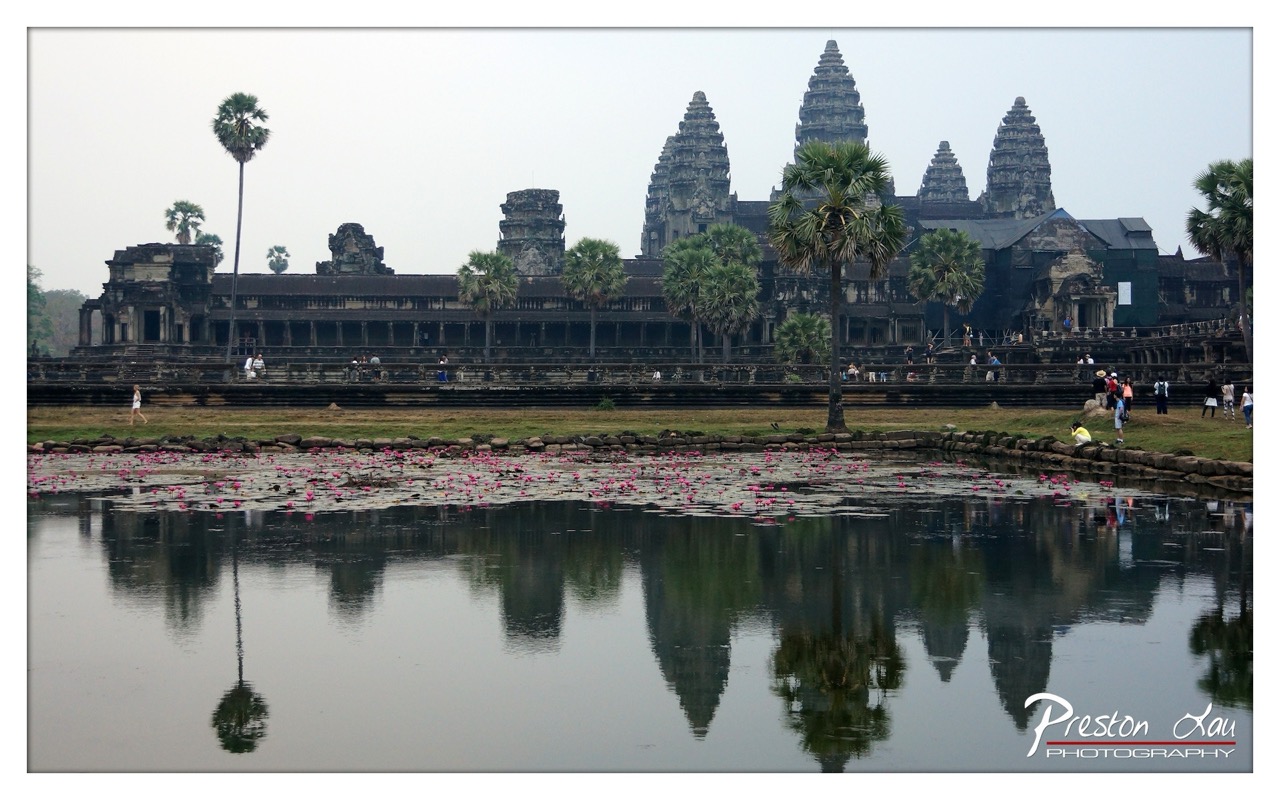

1. Overall Rating (0–10) — 7.0
This photograph captures the timeless grandeur of Angkor Wat with a serene, almost meditative stillness, where ancient stone towers rise above a reflective pool dotted with pink lotus blossoms. The composition balances the monumental architecture with natural elements, creating a sense of harmony and timelessness. While the overcast sky mutes the vibrancy of the scene, the reflection in the water adds depth and poise, making the image feel both reverent and contemplative.
2. Composition (0–10) — 7.5
The image is well-balanced, with the temple complex centered and framed by palm trees, while the water in the foreground provides symmetry and depth. The inclusion of the lotus pond and distant visitors adds scale and life without distracting from the main subject.
3. Lighting (0–10) — 5.5
The diffuse, overcast light softens the scene, minimizing harsh shadows and allowing for even exposure across the temple and water. However, the lack of strong directional light reduces contrast and diminishes the texture of the stone, giving the image a somewhat flat quality.
4. Color & Tone (0–10) — 6.0
The muted tones of the gray sky and stone are softened by the water’s dark reflection, while the scattered pink lotus flowers provide a subtle but effective pop of color. The overall palette leans toward monochromatic, which enhances the tranquil mood but limits visual dynamism.
5. Creativity (0–10) — 7.0
The photographer skillfully uses the reflection to double the impact of the temple’s silhouette, creating a layered, almost dreamlike effect. The integration of nature—palm trees, lotus flowers, and water—adds a poetic quality, transforming a traditional landscape into something more evocative and personal.
6. Technical Quality (0–10) — 8.0
The image is sharp and well-focused, with clear details in both the temple and the water’s surface. The exposure is balanced, and the reflection is crisp, indicating strong technical execution and attention to detail.
7. Emotional Impact (0–10) — 7.5
There is a quiet reverence in the image, evoking a sense of awe and tranquility. The stillness of the water, the ancient architecture, and the soft light combine to create a contemplative mood, inviting the viewer to pause and reflect on history and nature in harmony.
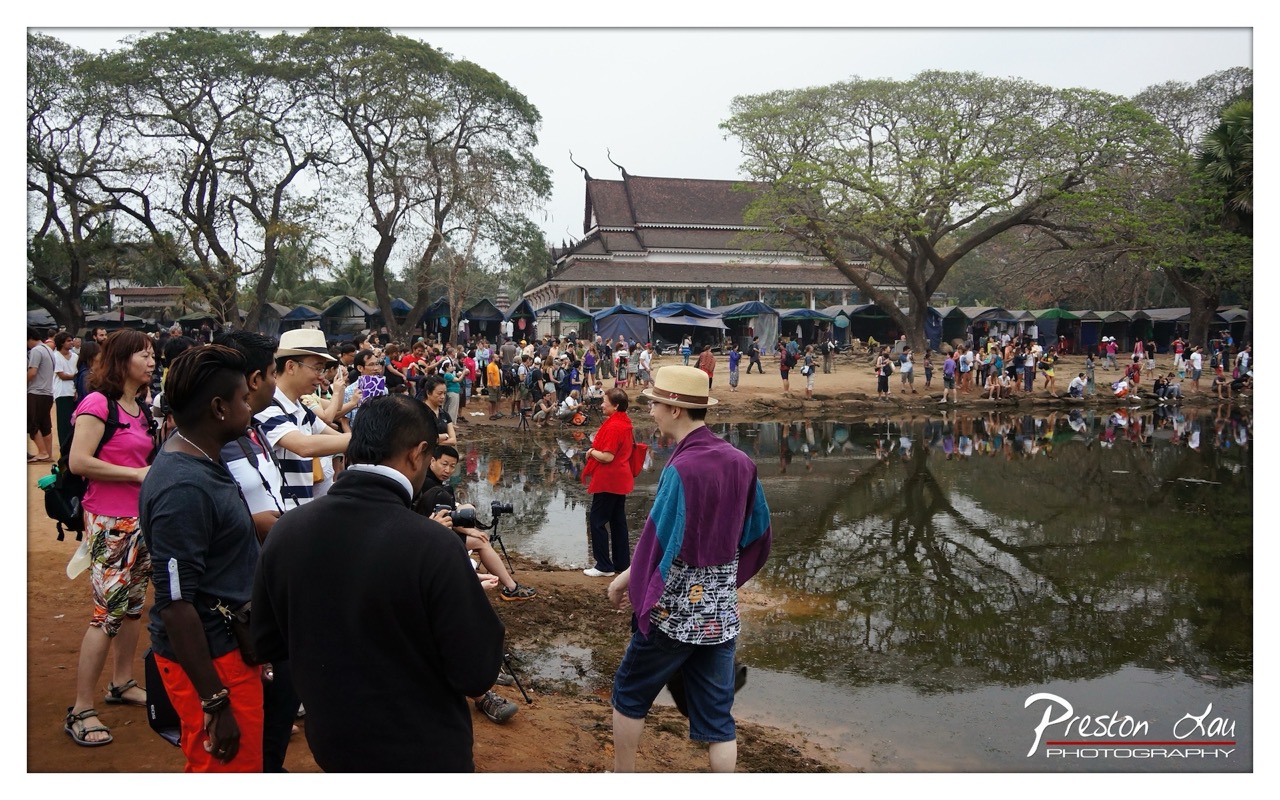

1. Overall Rating (0–10) — 6.0
This photograph captures the bustling energy of a cultural site, where tourists and locals converge along a reflective waterway. The wide composition effectively conveys the scale of the gathering, while the traditional architecture and lush trees anchor the scene in its location. However, the image’s strength lies in its documentation rather than its aesthetic refinement—its composition feels slightly scattered, and the muted lighting dampens the visual drama, leaving the moment feeling more like a snapshot than a fully realized portrait.
2. Composition (0–10) — 5.5
The frame includes too much background activity, creating visual clutter. The central figure in the straw hat provides a focal point, but the crowd’s dispersal across the foreground and midground weakens the sense of narrative cohesion.
3. Lighting (0–10) — 5.0
Diffused daylight under an overcast sky flattens the scene, reducing depth and contrast. While the light is even and avoids harsh shadows, it also diminishes the richness of textures and colors.
4. Color & Tone (0–10) — 5.5
The palette is dominated by earthy browns, muted greens, and soft grays, with occasional pops of color from clothing. The lack of vibrancy tempers the image’s visual appeal, though the reflections in the water add a subtle tonal balance.
5. Creativity (0–10) — 6.0
The photographer captures a candid moment of cultural exchange, offering a glimpse into daily life at a sacred site. While the idea is compelling, the execution lacks a strong visual hook or stylistic intent.
6. Technical Quality (0–10) — 7.0
The image is sharp and well-focused, with clean details in both the foreground and background. The exposure is balanced, and the watermark is professionally placed.
7. Emotional Impact (0–10) — 5.0
The photograph conveys a sense of place and movement, but the emotional resonance is muted. The viewer is an observer rather than an participant, and the lack of a clear focal emotion keeps the image from feeling deeply engaging.
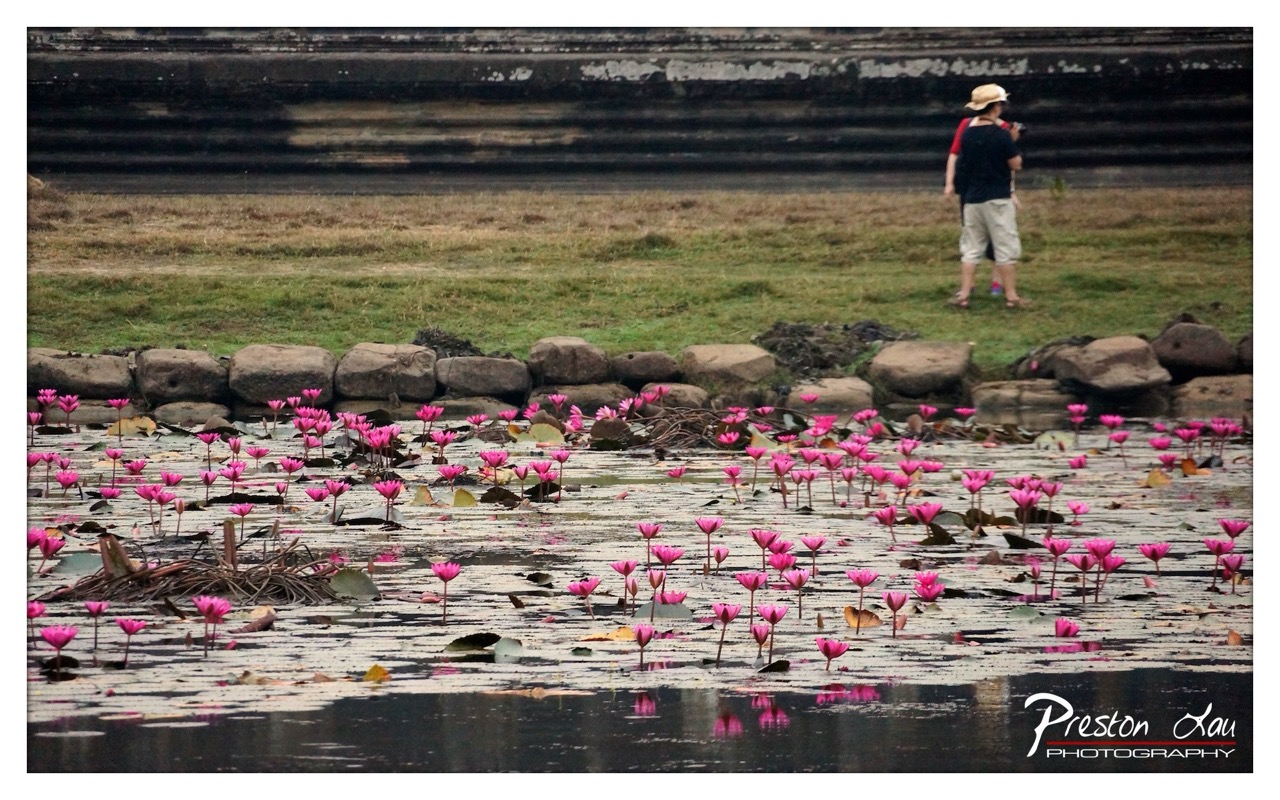

1. Overall Rating (0–10) — 7.0
This photograph captures a serene yet layered moment where ancient stone meets vibrant life, with the pink lotus flowers serving as a striking contrast to the weathered temple ruins in the background. The composition balances natural beauty and human presence, creating a sense of quiet contemplation. While the image is visually compelling, its emotional resonance is slightly muted by the overcast lighting and the distant figure, which feels more observational than integrated.
2. Composition (0–10) — 7.5
The strong horizontal lines of the temple wall and the stone embankment create a balanced, structured frame, while the scattered lotus flowers add organic rhythm to the foreground. The figure in the mid-ground provides scale and narrative, though their placement slightly disrupts the visual harmony.
3. Lighting (0–10) — 6.0
Diffused, overcast light softens the scene and reduces harsh shadows, lending a somber mood. While it ensures even exposure across the frame, the lack of directional sunlight diminishes the depth and drama that could have heightened the image's atmosphere.
4. Color & Tone (0–10) — 7.5
The vibrant magenta of the lotus flowers stands out against the muted greens, grays, and browns, creating a striking focal point. The cool, subdued tones of the background enhance the contrast, while the reflections in the water add subtle depth and cohesion.
5. Creativity (0–10) — 7.0
The juxtaposition of nature and ancient architecture, combined with the inclusion of a solitary traveler, suggests a narrative of exploration and timelessness. The choice to include the photographer's signature in the corner adds a personal touch, grounding the image in a specific moment and place.
6. Technical Quality (0–10) — 8.0
The image is sharp and well-focused, particularly in the foreground, with clean detail in the lotus petals and stone textures. The depth of field is appropriate, keeping the main subjects clear while allowing the background to recede naturally.
7. Emotional Impact (0–10) — 6.5
The scene evokes a sense of stillness and reverence, with the quiet figure and blooming lotuses suggesting a moment of reflection. While the mood is contemplative, the lack of strong emotional cues from the subject or lighting keeps the connection to the viewer slightly distant.
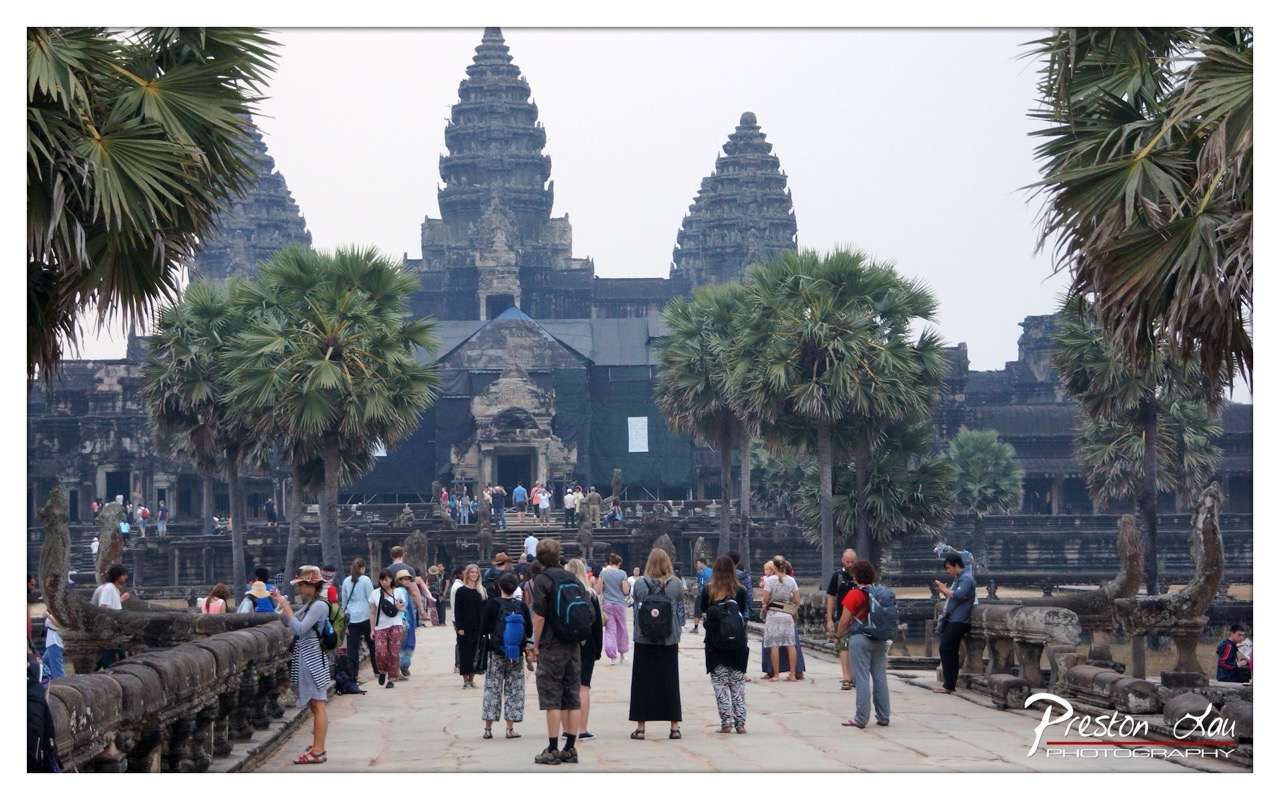

1. Overall Rating (0–10) — 7.0
This photograph captures the grandeur of Angkor Wat under a soft, overcast sky, with tourists adding a sense of scale and life to the ancient site. The composition balances the monumental architecture with the organic presence of palm trees, creating a layered narrative between history and the present. While the muted lighting tempers the image’s visual drama, it also lends a contemplative mood that complements the sacred atmosphere of the temple.
2. Composition (0–10) — 7.5
The central pathway draws the eye toward the temple’s towers, creating a strong sense of depth. The framing by palm trees on both sides adds symmetry and natural bordering, enhancing visual harmony. The placement of tourists along the walkway grounds the scene in reality without overwhelming the architectural focus.
3. Lighting (0–10) — 6.0
The diffused light from the overcast sky softens shadows and reduces contrast, creating a flat, even exposure that suits the subdued mood but diminishes the texture and detail of the stone carvings. While it avoids harsh highlights, it also robs the image of dynamic tonal range.
4. Color & Tone (0–10) — 6.5
The palette is dominated by muted greens and grays, reflecting the overcast conditions and aged stone. While the tones are cohesive, they lack vibrancy, resulting in a somewhat washed-out appearance. The green of the palm fronds provides a subtle contrast to the gray stone, adding visual interest.
5. Creativity (0–10) — 7.0
The image successfully merges the historical and the contemporary, using the presence of tourists to emphasize the temple’s enduring relevance. The framing through the palm trees adds a natural, almost reverent quality, suggesting a journey into the past. It is an observant, respectful portrayal rather than a dramatic interpretation.
6. Technical Quality (0–10) — 8.0
The image is sharp and well-focused, with clear detail in both the foreground and background. The depth of field is sufficient to keep the main temple and the people in focus, and the exposure is balanced despite the challenging lighting conditions.
7. Emotional Impact (0–10) — 7.0
There is a quiet reverence in the image, evoked by the vastness of the temple and the contemplative pace of the visitors. The overcast sky and muted tones contribute to a reflective, almost solemn mood, inviting the viewer to imagine the history and spiritual significance of the site.
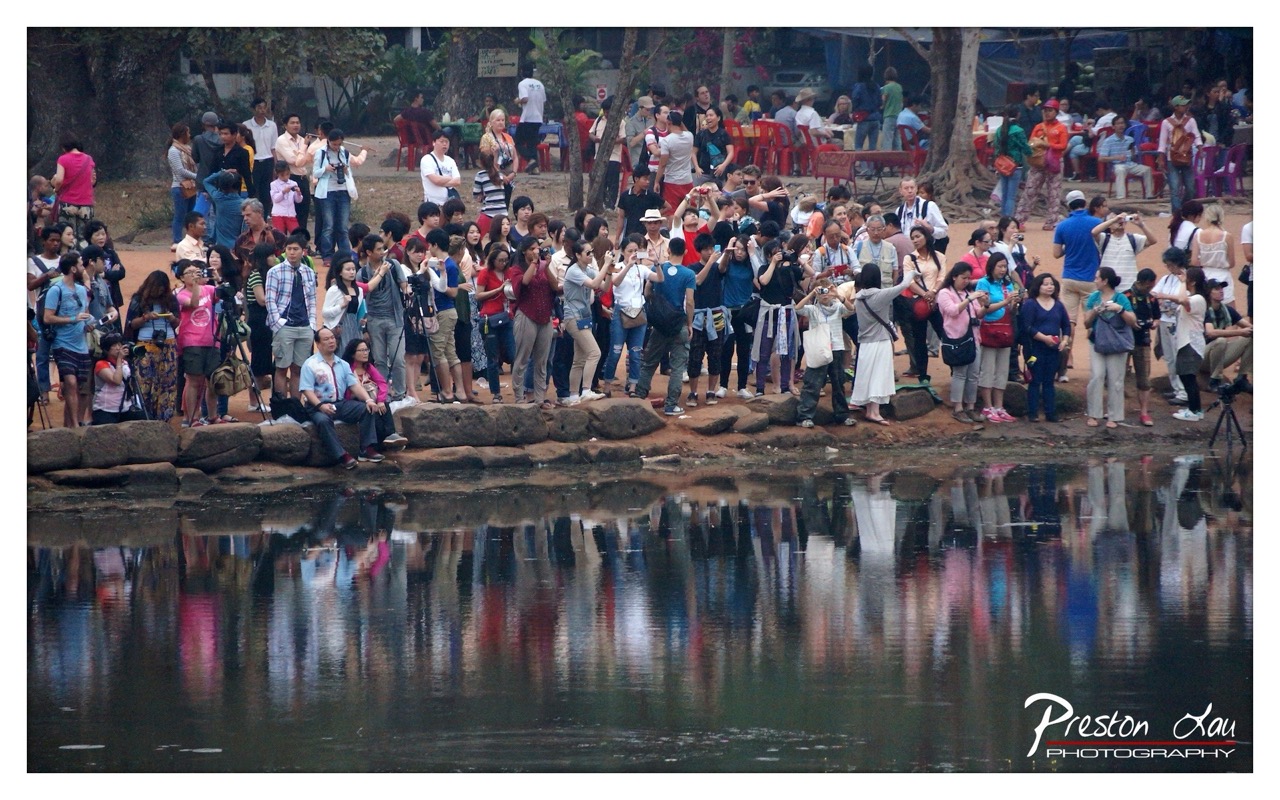

1. Overall Rating (0–10) — 7.0
This photograph captures a vibrant, bustling moment at a popular tourist site, where a diverse crowd gathers along a waterside to witness or document an event. The composition effectively uses the water’s reflection to double the visual energy, creating a sense of symmetry and depth. While the scene is rich in human activity and cultural context, the image’s emotional resonance is slightly diminished by a lack of focus on individual narratives, making it feel more like a snapshot than a refined portrait of the moment.
2. Composition (0–10) — 7.5
The framing balances the crowd along the top half of the image with their reflections in the water below, creating a strong vertical symmetry. The placement of the stone edge acts as a natural leading line, guiding the eye across the scene. However, the sheer density of people creates visual clutter, and the absence of a clear focal point slightly weakens the overall composition.
3. Lighting (0–10) — 6.5
The lighting appears to be natural and diffused, likely from an overcast sky or late afternoon sun, which softens shadows and evenly illuminates the scene. While this avoids harsh contrasts, it also lends a somewhat flat quality to the image, reducing the dramatic impact of the crowd and their colorful attire.
4. Color & Tone (0–10) — 7.0
The palette is rich with a variety of colors from the tourists’ clothing, which contrasts nicely with the dark, muted tones of the water and stone. The reflections add a subtle shimmer, enhancing the visual texture. The overall tone is natural and slightly cool, which complements the outdoor, candid atmosphere.
5. Creativity (0–10) — 7.5
The photographer demonstrates creativity through the use of reflection as a compositional device, doubling the scene and adding visual interest. The choice to include both the crowd and their mirrored image creates a layered narrative that speaks to the intersection of observation and spectacle. The image feels both documentary and artistic, capturing a fleeting moment with a sense of intention.
6. Technical Quality (0–10) — 8.0
The image is sharp and clear, with good detail throughout the frame. The focus is consistent across the crowd and the water, and the exposure is well-managed, preserving detail in both highlights and shadows. The watermark is subtly placed, not distracting from the main subject.
7. Emotional Impact (0–10) — 6.5
The photograph conveys a sense of shared experience and collective curiosity, as the crowd is united in a common purpose. While the emotional depth is present in the energy of the gathering, the sheer number of subjects and the lack of individual focus prevent a deeper connection with any single person or story. The viewer is invited to observe rather than to feel.
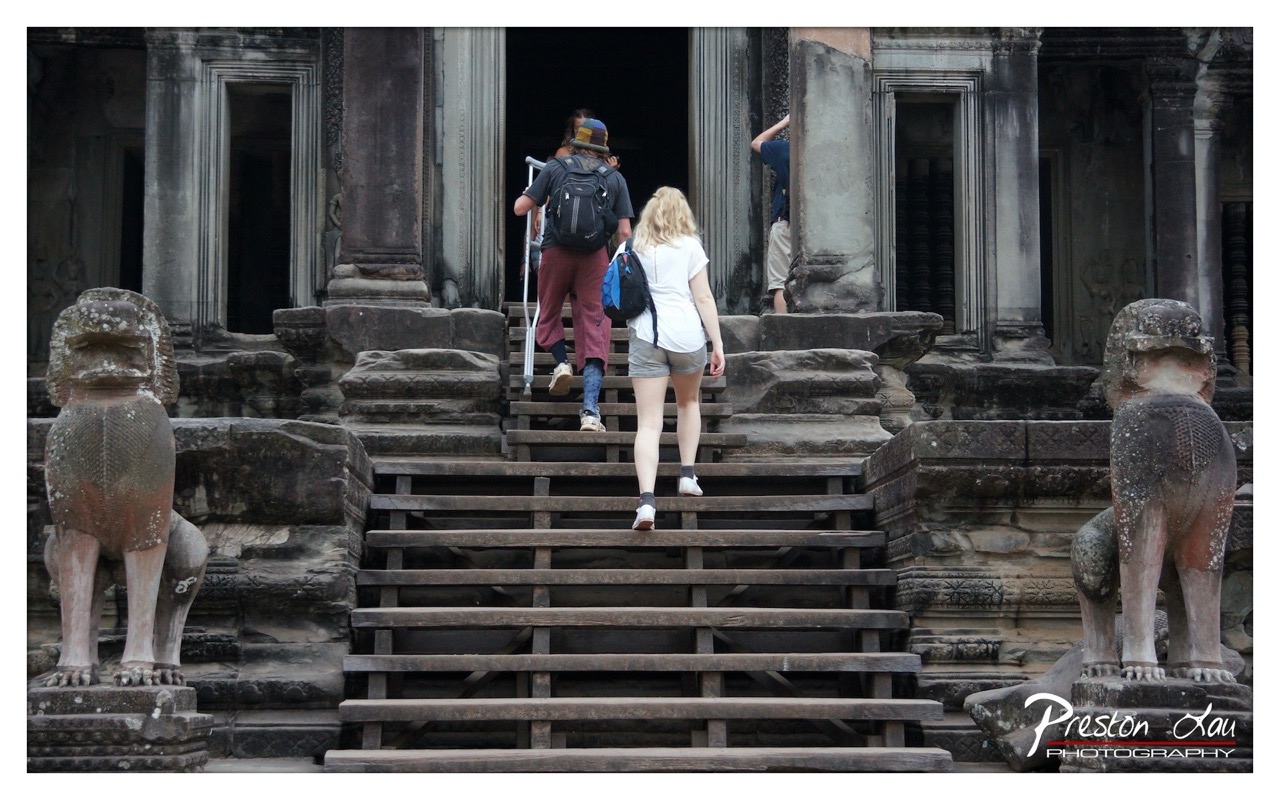

1. Overall Rating (0–10) — 7.0
This photograph captures a compelling juxtaposition of ancient grandeur and modern human curiosity, as tourists ascend the weathered steps of a temple. The composition draws the eye upward along the central staircase, emphasizing the passage of time and the enduring allure of cultural heritage. While the image is rich in narrative and context, the lighting and color balance feel slightly flat, softening the dramatic texture of the stone and diminishing the emotional weight of the moment.
2. Composition (0–10) — 7.5
The symmetrical framing, with stone guardians flanking the stairs and the central pathway leading toward the temple entrance, creates a strong sense of depth and balance. The positioning of the tourists adds narrative weight, guiding the viewer’s gaze through the frame and reinforcing the scale of the architecture.
3. Lighting (0–10) — 6.0
The light is diffused and even, likely from an overcast sky, which minimizes harsh shadows and allows for clear detail across the scene. However, this softness also dampens the contrast and atmosphere, preventing the stonework from appearing as richly textured as it truly is.
4. Color & Tone (0–10) — 6.5
The palette is muted, dominated by grays and earth tones, which reflects the aged stone but limits visual vibrancy. A subtle warmth or enhanced contrast could have brought more depth to the textures and highlighted the cultural richness of the site.
5. Creativity (0–10) — 7.0
The image succeeds in telling a story—of pilgrimage, exploration, and the intersection of past and present. The choice to capture the back of the visitors adds a layer of universality, inviting the viewer to imagine themselves stepping into the scene.
6. Technical Quality (0–10) — 8.0
The focus is sharp across the frame, particularly on the central figures and the architectural details. The exposure is well-managed, with no blown highlights or lost shadows, and the watermark is discreetly placed.
7. Emotional Impact (0–10) — 6.5
There is a quiet reverence in the image, evoked by the scale of the temple and the contemplative act of climbing. While the emotion is present, it is restrained by the neutral lighting and lack of dramatic contrast, leaving the viewer with a sense of observation rather than deep connection.
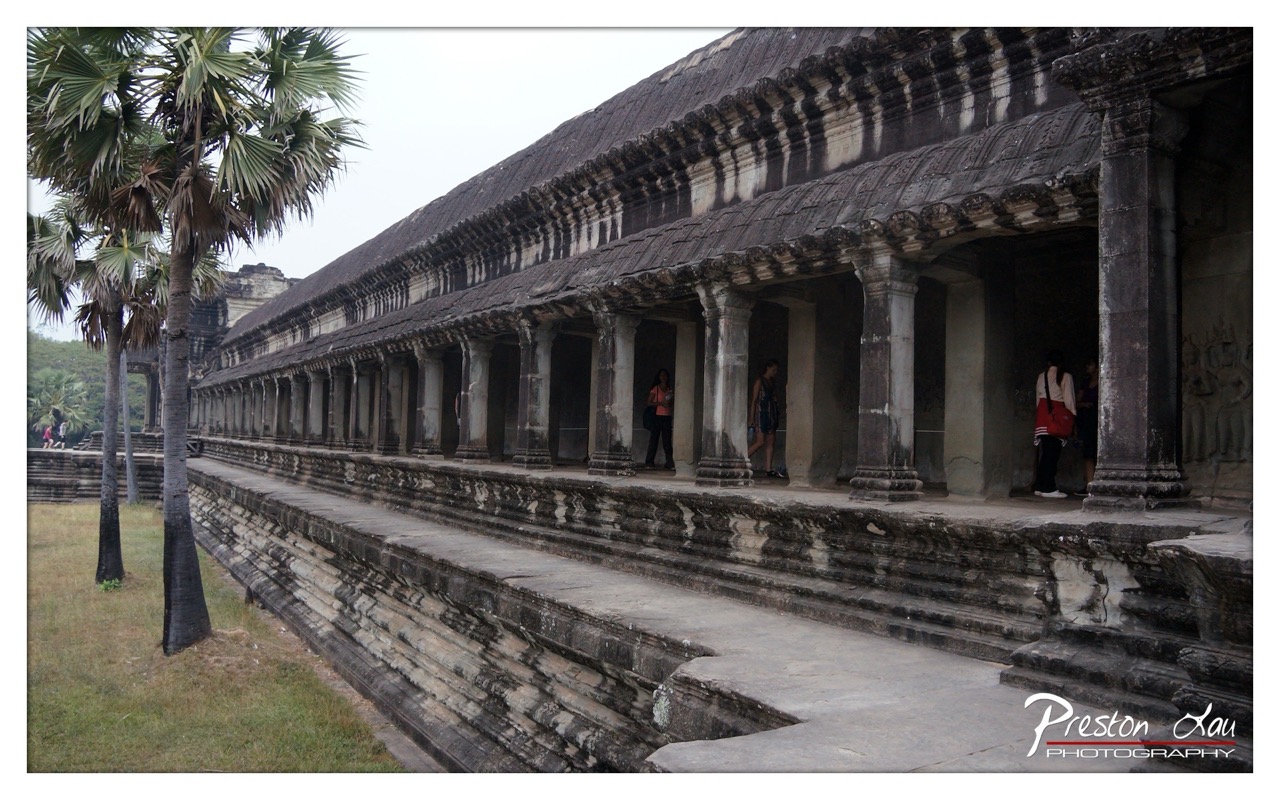

1. Overall Rating (0–10) — 7.0
This photograph captures the enduring grandeur of Angkor Wat’s colonnaded gallery, where ancient stone and modern visitors converge in quiet harmony. The weathered textures and layered architecture evoke a deep sense of time and reverence, while the palm trees add a touch of tropical stillness. Though the overcast sky tempers the mood with neutrality, the image successfully balances historical weight with human scale, making the monumental feel accessible.
2. Composition (0–10) — 7.5
The long diagonal of the gallery draws the eye into the frame, creating strong leading lines that emphasize depth and scale. The placement of the palm trees on the left adds visual weight and frames the scene naturally, while the scattered figures provide a sense of scale and life without disrupting the architectural dominance.
3. Lighting (0–10) — 6.0
The diffused, overcast light softens shadows and evenly illuminates the stonework, preserving texture without harsh contrast. While this creates a calm, contemplative mood, it also reduces the drama and richness of the scene, muting the stone’s natural tones.
4. Color & Tone (0–10) — 6.5
The palette is dominated by muted grays and earthy tones, which align with the age and solemnity of the temple. The green of the palms offers a subtle contrast, but the overall tonal range feels somewhat flat, lacking vibrancy or dynamic range.
5. Creativity (0–10) — 7.0
The photograph presents a familiar subject with a respectful, observational approach. The inclusion of visitors grounds the image in the present, offering a narrative of continuity between past and present. The framing and perspective elevate the scene beyond a simple travel snapshot.
6. Technical Quality (0–10) — 8.0
The image is sharp and detailed, with clear focus across the frame. The depth of field is well-managed, allowing both the foreground stonework and distant columns to remain crisp. The watermark is unobtrusive and professionally placed.
7. Emotional Impact (0–10) — 7.5
There is a quiet dignity in the image, evoking awe for the craftsmanship and endurance of the temple. The presence of people invites a reflective mood, suggesting both reverence and curiosity, making the viewer feel a personal connection to the historical moment.
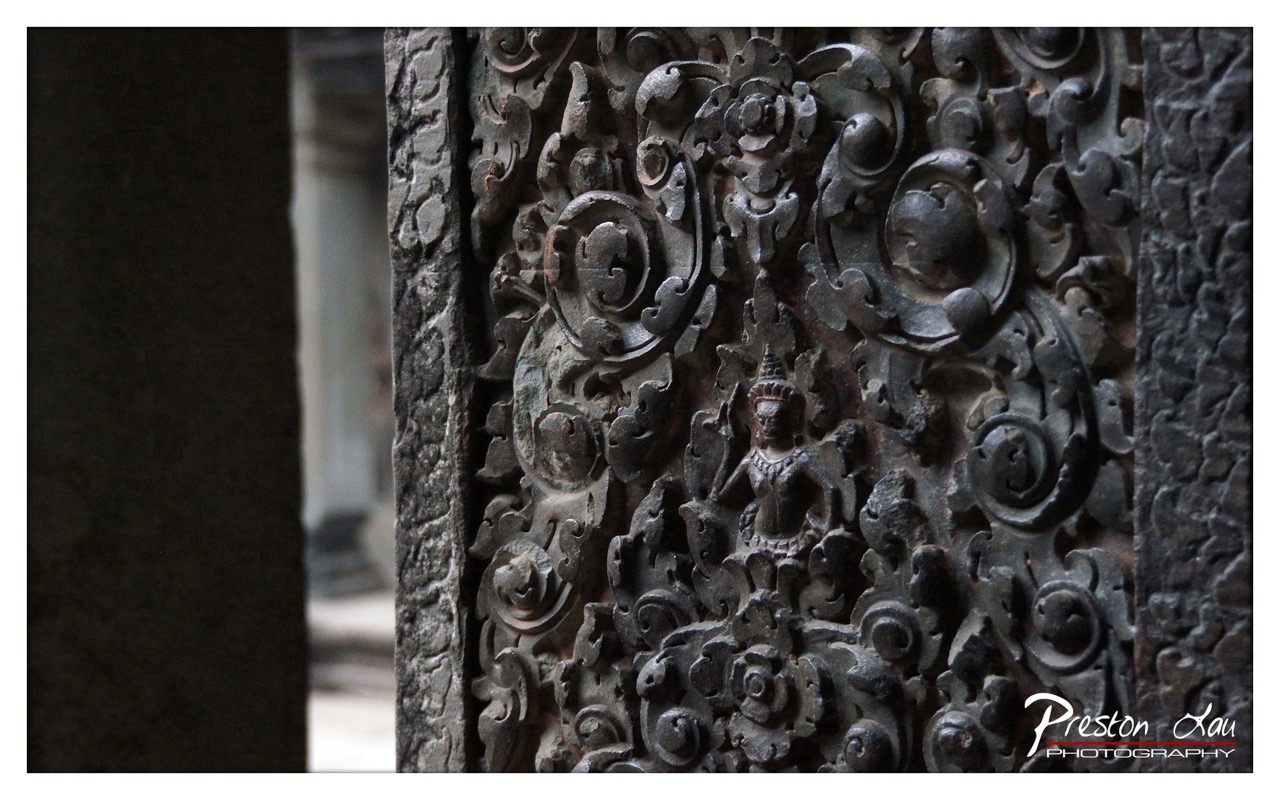

1. Overall Rating (0–10) — 7.5
This photograph captures the intricate artistry of ancient stone carving with a sense of reverence and quiet grandeur. The dark, weathered texture of the relief, centered around a delicate figure, draws the eye into a world of historical depth and spiritual symbolism. While the image is rich in detail and mood, its narrow depth of field and dim lighting slightly limit the full appreciation of the craftsmanship.
2. Composition (0–10) — 7.0
The framing centers the ornate relief, using the left pillar as a natural leading line that guides the viewer into the image. The balance between the carved subject and the dark void on the left creates a contemplative rhythm, though the off-center placement of the figure slightly disrupts symmetry.
3. Lighting (0–10) — 6.5
The soft, directional light highlights the relief’s depth and texture, emphasizing the three-dimensional quality of the carvings. However, the overall dimness and lack of contrast slightly obscure finer details, giving the image a subdued, almost somber tone.
4. Color & Tone (0–10) — 7.0
The monochromatic palette of deep grays and blacks enhances the ancient, timeless feel of the stone. The subtle variations in tone across the relief lend a sense of age and patina, though a slightly warmer undertone could have added more visual warmth.
5. Creativity (0–10) — 8.0
The photographer captures a moment of quiet discovery, transforming a static architectural detail into a narrative of cultural heritage. The focus on texture and form, rather than broad context, reflects a thoughtful and interpretive approach to temple photography.
6. Technical Quality (0–10) — 8.0
The image is sharp in the focal plane, with fine detail visible in the carvings. The shallow depth of field is used effectively to isolate the subject, though the exposure is on the darker side, sacrificing some detail in the shadows.
7. Emotional Impact (0–10) — 7.5
There is a meditative stillness in the image that invites reflection on the passage of time and the endurance of art. The quiet intensity of the scene evokes a sense of awe and respect, connecting the viewer to the spiritual and cultural significance of the carvings.
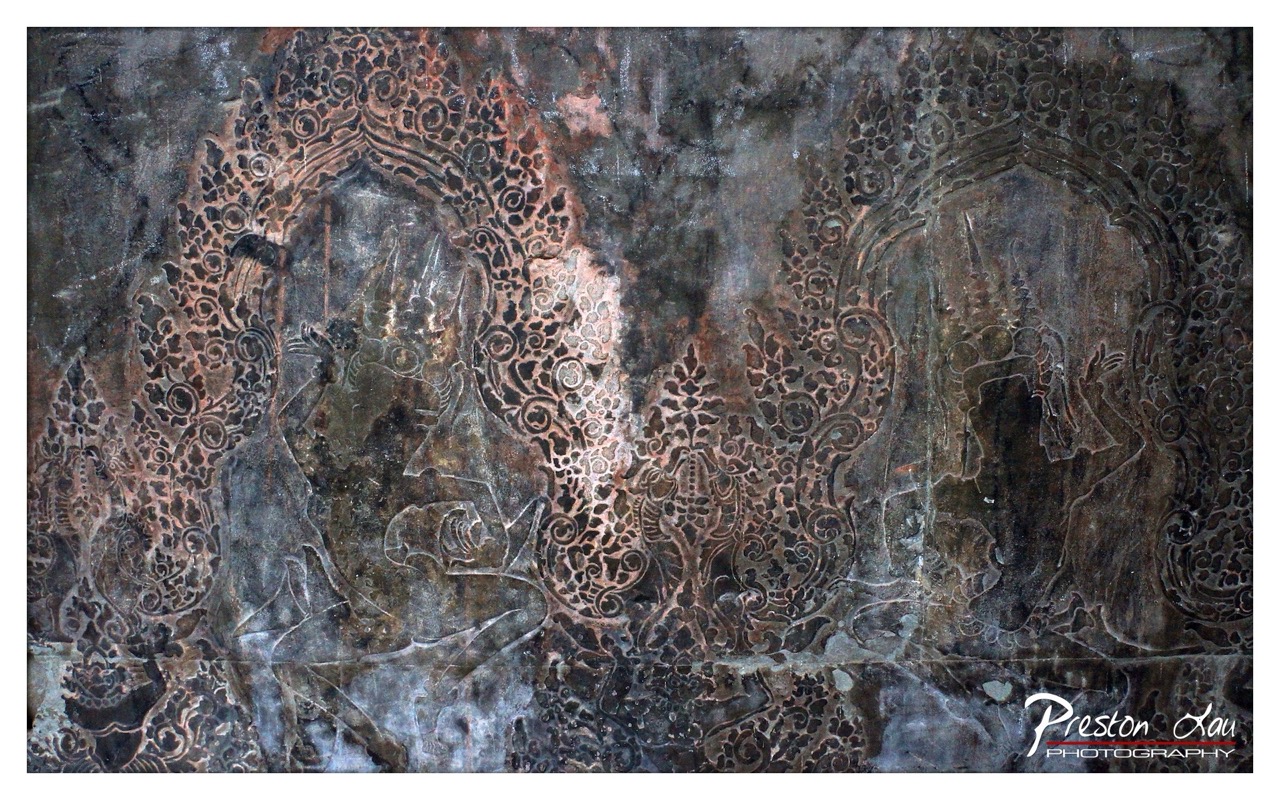

1. Overall Rating (0–10) — 7.0
This photograph captures the weathered grandeur of ancient Khmer bas-relief carvings, where time and erosion have transformed stone into a tapestry of texture and history. The interplay of light and shadow across the intricate patterns reveals a narrative etched in stone, while the dark, moody palette enhances the sense of antiquity. Though the image is rich in detail, its subdued lighting and lack of visual contrast slightly dampen its emotional resonance, leaving the viewer more as an observer than a participant in the scene.
2. Composition (0–10) — 6.5
The frame is tightly centered on the carvings, emphasizing their symmetry and complexity. However, the uneven distribution of light and shadow across the relief creates a slight imbalance, drawing the eye more toward the left side, which may distract from the overall harmony.
3. Lighting (0–10) — 6.0
The lighting is soft and directional, likely natural and diffused, which accentuates the depth of the carvings. Yet, the overall dimness and lack of dynamic contrast limit the visibility of finer details and create a flat, almost somber mood.
4. Color & Tone (0–10) — 6.5
The palette is dominated by dark earth tones—muted browns, grays, and subtle copper highlights—evoking a sense of age and decay. While cohesive, the lack of vibrancy or tonal range keeps the image from feeling fully alive or engaging.
5. Creativity (0–10) — 7.0
The photograph successfully captures the spiritual and historical weight of the subject, presenting it not as a mere documentary record but as a contemplative study of texture and time. The choice to emphasize the worn surface over clarity reflects an artistic intent to evoke mystery and endurance.
6. Technical Quality (0–10) — 7.5
The image is sharp and detailed, with clear focus on the carvings' fine patterns. The resolution captures the texture of the stone effectively, though minor noise and uneven exposure slightly compromise technical polish.
7. Emotional Impact (0–10) — 6.5
The photograph conveys a quiet reverence for the past, inviting reflection on cultural legacy and the passage of time. While the mood is contemplative, the lack of dramatic contrast and emotional intensity keeps the connection to the viewer from being fully compelling.
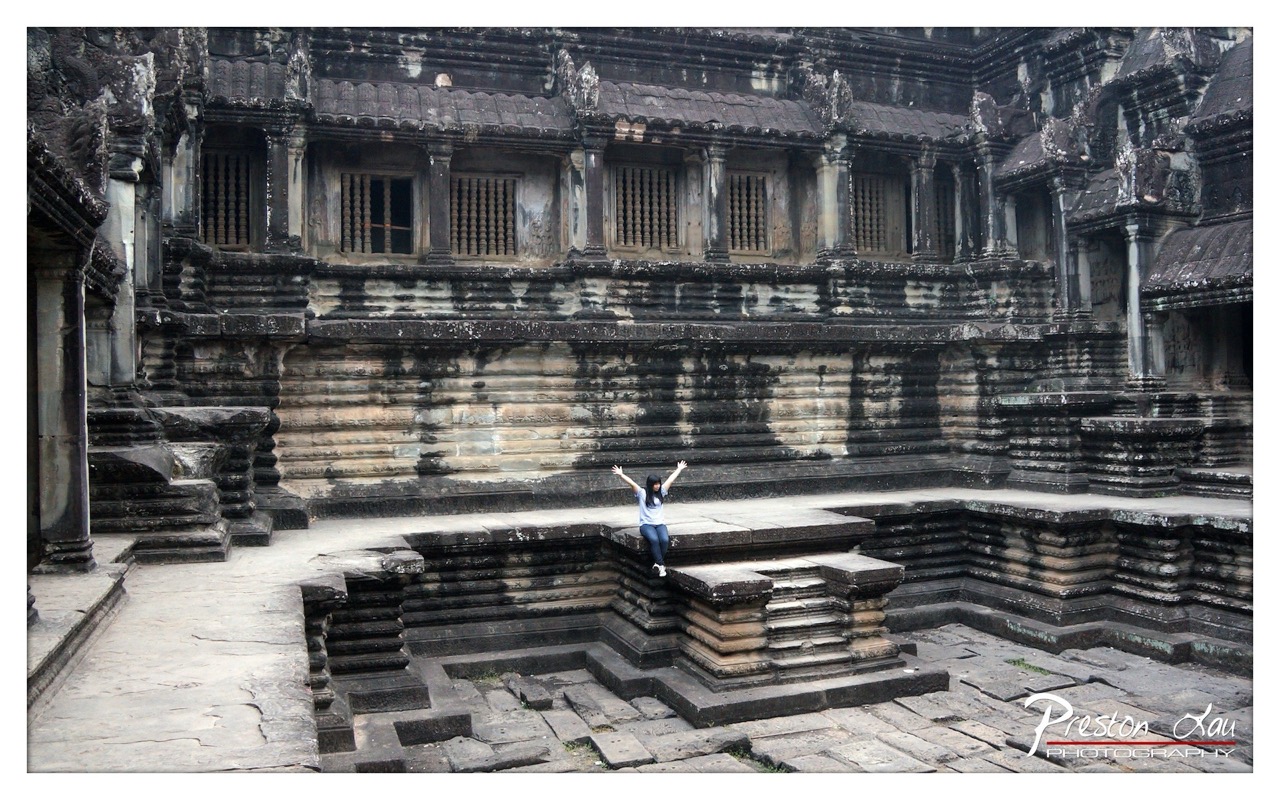

1. Overall Rating (0–10) — 7.0
This photograph captures the awe-inspiring scale of Angkor Wat’s ancient architecture, with a solitary figure emphasizing the grandeur of the stone structure. The weathered textures and layered stonework convey centuries of history, while the subject’s pose injects a sense of wonder and human connection to the past. The image is strong in narrative and composition, though its slightly flat lighting and muted tones temper its visual impact.
2. Composition (0–10) — 7.5
The subject is well-placed in the lower center, creating a sense of balance against the expansive, symmetrical temple facade. The receding stone tiers draw the eye upward, enhancing depth and scale. A slightly tighter crop could improve focus, but the wide framing effectively communicates the monument’s vastness.
3. Lighting (0–10) — 6.0
The light is even and diffused, likely from an overcast sky, which softens shadows and reveals texture without creating harsh contrasts. While this allows for detail across the stone surfaces, it also diminishes dramatic depth and mood, giving the scene a somewhat neutral tone.
4. Color & Tone (0–10) — 6.5
The palette is dominated by earthy grays and muted browns, consistent with aged stone. The subdued tones reflect the historical atmosphere but lack vibrancy. A touch of warmth or contrast in the highlights could enhance the sense of time and place.
5. Creativity (0–10) — 7.0
The inclusion of the human figure provides a compelling narrative contrast between the enduring stone and fleeting human presence. The choice to frame the subject within the architectural layers adds storytelling depth, making the image more than a mere travel snapshot.
6. Technical Quality (0–10) — 8.0
The image is sharp and clear, with fine detail visible in the stonework. Focus is consistent across the frame, and the exposure is well-balanced. The watermark is subtle and unobtrusive, indicating professional handling.
7. Emotional Impact (0–10) — 7.5
The photograph evokes a quiet sense of reverence and wonder, inviting the viewer to contemplate the passage of time and the endurance of human achievement. The subject’s gesture amplifies this emotional resonance, making the viewer feel both small and connected.
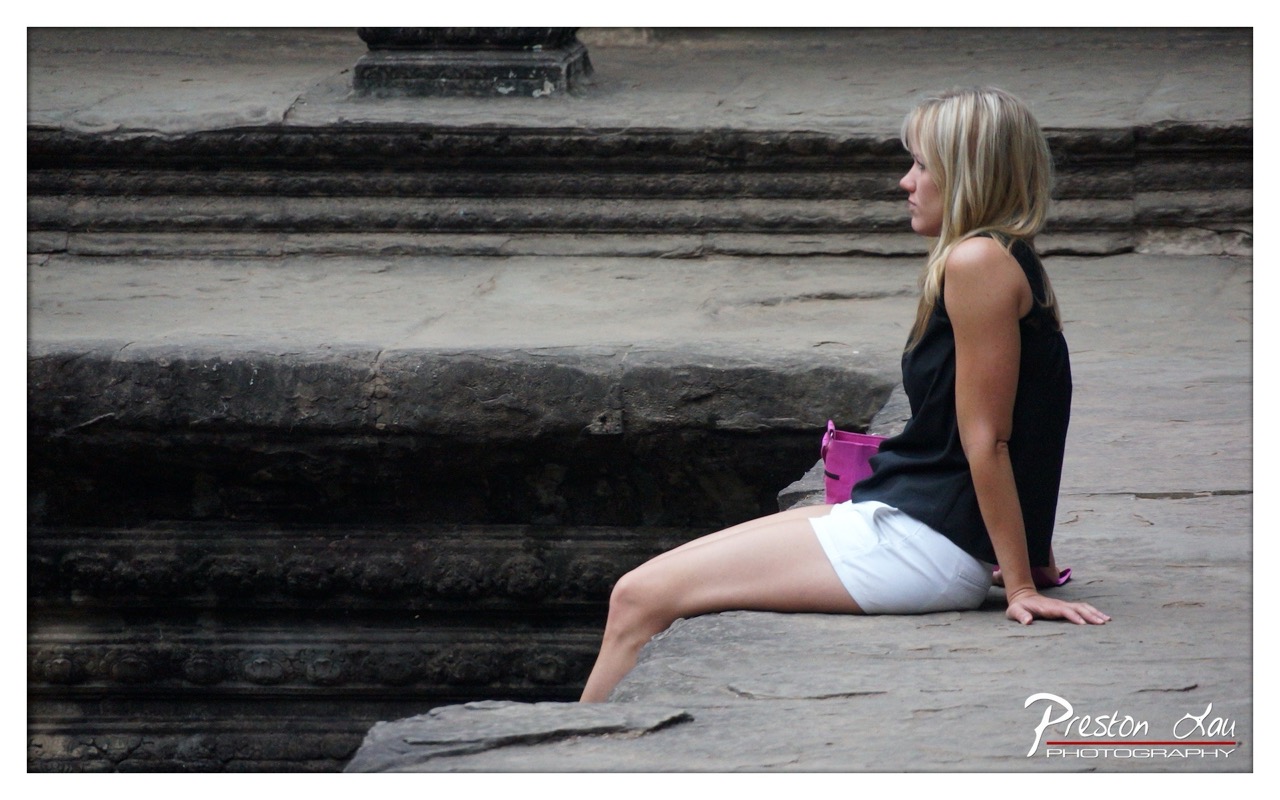

1. Overall Rating (0–10) — 6.8
This photograph captures a quiet moment of contemplation against the backdrop of ancient stone steps, evoking a sense of timelessness and solitude. The contrast between the modern figure and the weathered architecture creates a subtle narrative of presence within history. While the image is compositionally strong and emotionally resonant, the muted lighting and slightly flat color palette limit its visual impact, leaving the scene feeling more observational than immersive.
2. Composition (0–10) — 7.0
The subject is placed off-center, creating a balanced and naturalistic frame, with the layered steps leading the eye into the image. The diagonal line of the stone edge adds depth, though the right side feels slightly more open than necessary.
3. Lighting (0–10) — 5.5
Diffuse, overcast light evenly illuminates the scene but lacks directional warmth or contrast, resulting in a somewhat flat and neutral mood. The shadows are soft, which preserves detail but diminishes dramatic tension.
4. Color & Tone (0–10) — 6.0
The overall palette is subdued, with earthy grays and muted tones dominating. The bright pink bag provides a striking pop of color, drawing attention but also creating a slight visual dissonance with the historic setting.
5. Creativity (0–10) — 7.0
The juxtaposition of a modern individual against ancient ruins offers a compelling conceptual contrast, suggesting themes of travel, memory, and continuity. The candid nature of the pose enhances the authenticity of the moment.
6. Technical Quality (0–10) — 7.5
The image is sharp and well-focused, with clear detail in both the subject and the stone textures. The exposure is balanced, and the watermark is discreet, maintaining professionalism.
7. Emotional Impact (0–10) — 6.5
The photograph conveys a sense of quiet introspection and solitude, inviting viewers to ponder the relationship between the individual and the passage of time. While emotionally resonant, the lack of strong lighting and color dynamics keeps the connection from feeling deeply evocative.
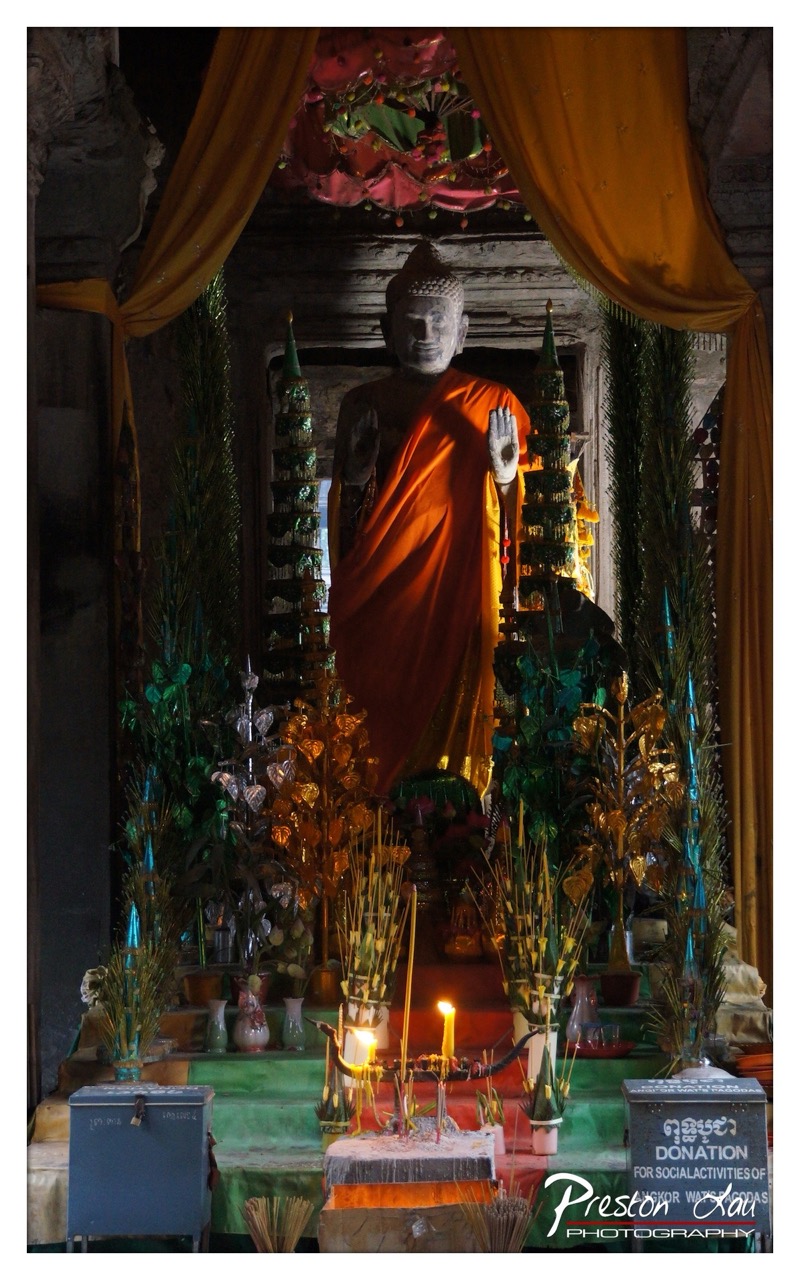

1. Overall Rating (0–10) — 7.5
This photograph captures the quiet reverence of a sacred space within a temple, where tradition and devotion converge in a richly layered composition. The interplay of warm candlelight and deep shadows enhances the spiritual atmosphere, while the vibrant orange of the robe and golden drapery draws the eye to the central Buddha figure. Though the scene is visually dense, the image succeeds in conveying a sense of sacred stillness and cultural depth, though the clutter of offerings slightly distracts from the statue’s solemn presence.
2. Composition (0–10) — 7.0
The Buddha is centered and framed by draped fabric and ornamental offerings, creating a sense of ritual enclosure. However, the foreground clutter—candles, donations, and floral arrangements—partially obstructs the lower half, slightly disrupting the visual harmony.
3. Lighting (0–10) — 8.0
The use of directional candlelight creates a dramatic chiaroscuro effect, highlighting the Buddha’s face and robe while casting the surrounding space into deep shadow. This enhances the mood of reverence and mystery, though the overall exposure is dim, limiting detail in the darker areas.
4. Color & Tone (0–10) — 7.5
The warm golden tones of the robe and candlelight contrast beautifully with the cool shadows and green foliage, creating a balanced and spiritually resonant palette. The saturation is rich but not oversaturated, allowing the colors to feel authentic and reverent.
5. Creativity (0–10) — 7.0
The image captures a moment of lived religious practice, blending the sacred with the everyday. While the subject is familiar, the composition and lighting elevate it beyond a simple documentation, suggesting a narrative of devotion and continuity.
6. Technical Quality (0–10) — 7.5
The image is sharp in the central area, with clear focus on the Buddha’s face and hands. The lighting conditions challenge the camera’s dynamic range, resulting in some loss of detail in the shadows, but the overall clarity is strong.
7. Emotional Impact (0–10) — 8.0
The photograph evokes a deep sense of peace and reverence, inviting the viewer into a quiet moment of spiritual reflection. The candlelight and stillness create a contemplative mood that resonates emotionally, even without a human presence.
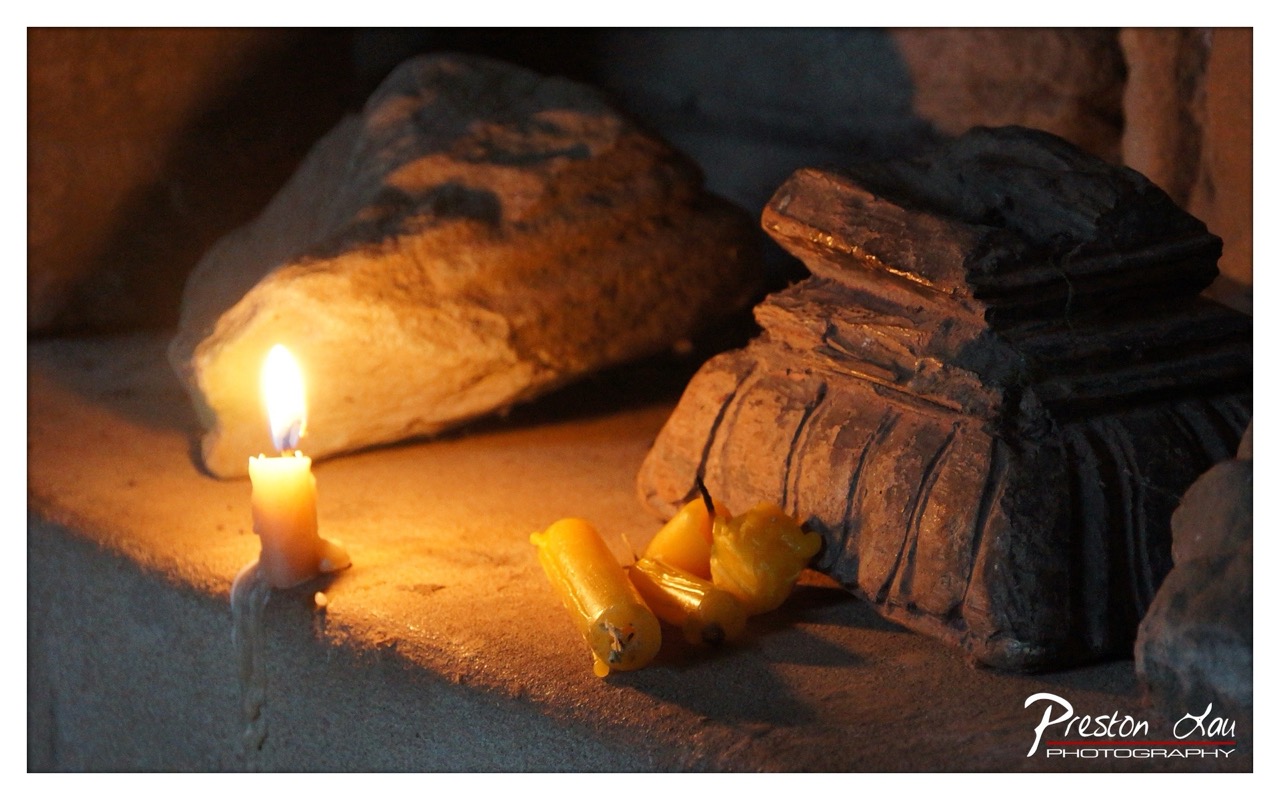

1. Overall Rating (0–10) — 7.0
This photograph captures a quiet, contemplative moment illuminated by the soft glow of a single candle, evoking a sense of reverence and timelessness. The interplay of light and shadow enhances the texture of the stone and wood, creating a meditative atmosphere. While the image is rich in mood, its slightly cluttered arrangement and modest color vibrancy prevent it from achieving greater visual harmony.
2. Composition (0–10) — 6.5
The candle is placed off-center, drawing the eye naturally, while the surrounding objects create a layered depth. However, the scattered candles and uneven framing slightly disrupt the balance, making the composition feel more casual than deliberate.
3. Lighting (0–10) — 8.0
The warm, directional candlelight creates dramatic contrast and emphasizes texture, casting deep shadows that add dimension. The soft glow enhances the intimate mood, though some areas remain underexposed due to the limited light source.
4. Color & Tone (0–10) — 6.5
The dominant warm yellows and deep browns create a cohesive, earthy palette, but the lack of color variation limits visual interest. The cool gray background provides subtle contrast, grounding the scene without distracting.
5. Creativity (0–10) — 7.0
The image successfully conveys a quiet, spiritual still life through its choice of subject and lighting. The combination of natural textures and candlelight suggests a narrative of devotion or remembrance, though it remains grounded in realism rather than abstraction.
6. Technical Quality (0–10) — 7.5
The focus is sharp on the lit candle and nearby objects, with smooth depth of field. The image is clear and well-exposed for the available light, though minor noise appears in the darker areas.
7. Emotional Impact (0–10) — 7.5
The intimate lighting and stillness evoke a sense of peace and introspection, inviting the viewer to pause and reflect. The warmth of the flame contrasts with the cold stone, suggesting both fragility and endurance—emotions that resonate deeply.
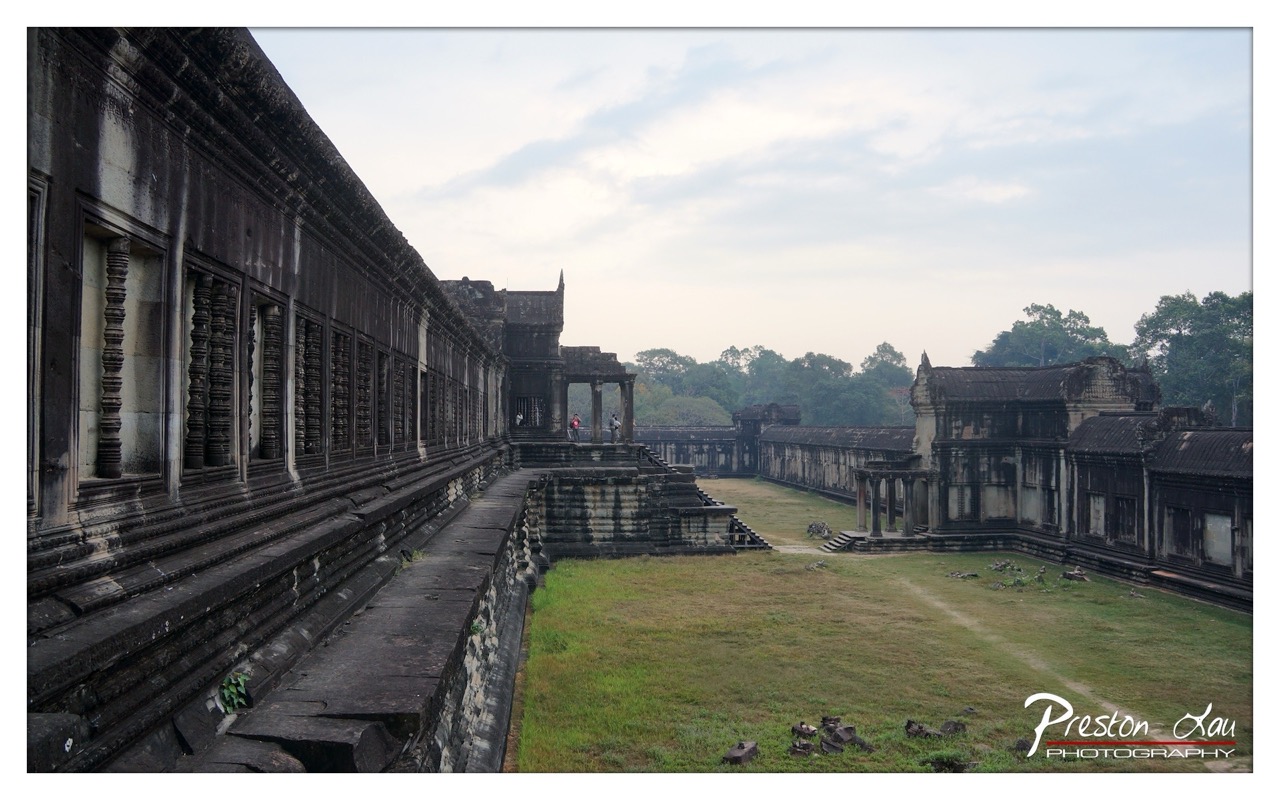

1. Overall Rating (0–10) — 7.0
This photograph captures the solemn grandeur of Angkor Wat’s ancient corridors, where time and stone converge in quiet dignity. The long perspective draws the eye through the weathered architecture, emphasizing both the scale and the enduring mystery of the site. While the overcast sky softens the mood, the composition’s depth and historical weight lend a contemplative resonance, though the image could benefit from stronger tonal contrast to elevate its visual impact.
2. Composition (0–10) — 7.5
The leading lines of the corridor create a strong sense of depth, guiding the viewer into the frame toward the distant structure. The balanced arrangement of the left wall and right courtyard offers visual harmony, though the slight asymmetry in the background architecture introduces a subtle tension that keeps the eye engaged.
3. Lighting (0–10) — 6.0
Diffuse, overcast light softens shadows and flattens the texture of the stone, lending a muted, almost somber atmosphere. While this suits the contemplative mood, the lack of directional light reduces the sense of dimension and depth in the architectural details.
4. Color & Tone (0–10) — 6.5
The palette is restrained, dominated by weathered grays and muted greens, which reflect the age and natural integration of the temple with its environment. The tonal range is somewhat compressed, with a slight cool cast that enhances the melancholic tone but limits vibrancy.
5. Creativity (0–10) — 7.0
The image successfully conveys the awe and timelessness of the site through its expansive framing and perspective. While not radically inventive, the choice to emphasize the architectural lines and human scale adds narrative depth and invites reflection.
6. Technical Quality (0–10) — 7.5
The image is sharp and clear, with good detail in the stonework and grassy courtyard. Focus is consistent across the frame, and the exposure is well-balanced, though minor noise is present in the darker areas due to the low-light conditions.
7. Emotional Impact (0–10) — 7.0
There is a quiet, meditative quality to the photograph that evokes a sense of reverence and solitude. The presence of distant visitors adds a human element without disrupting the atmosphere, reinforcing the scale and mystery of the ancient site.
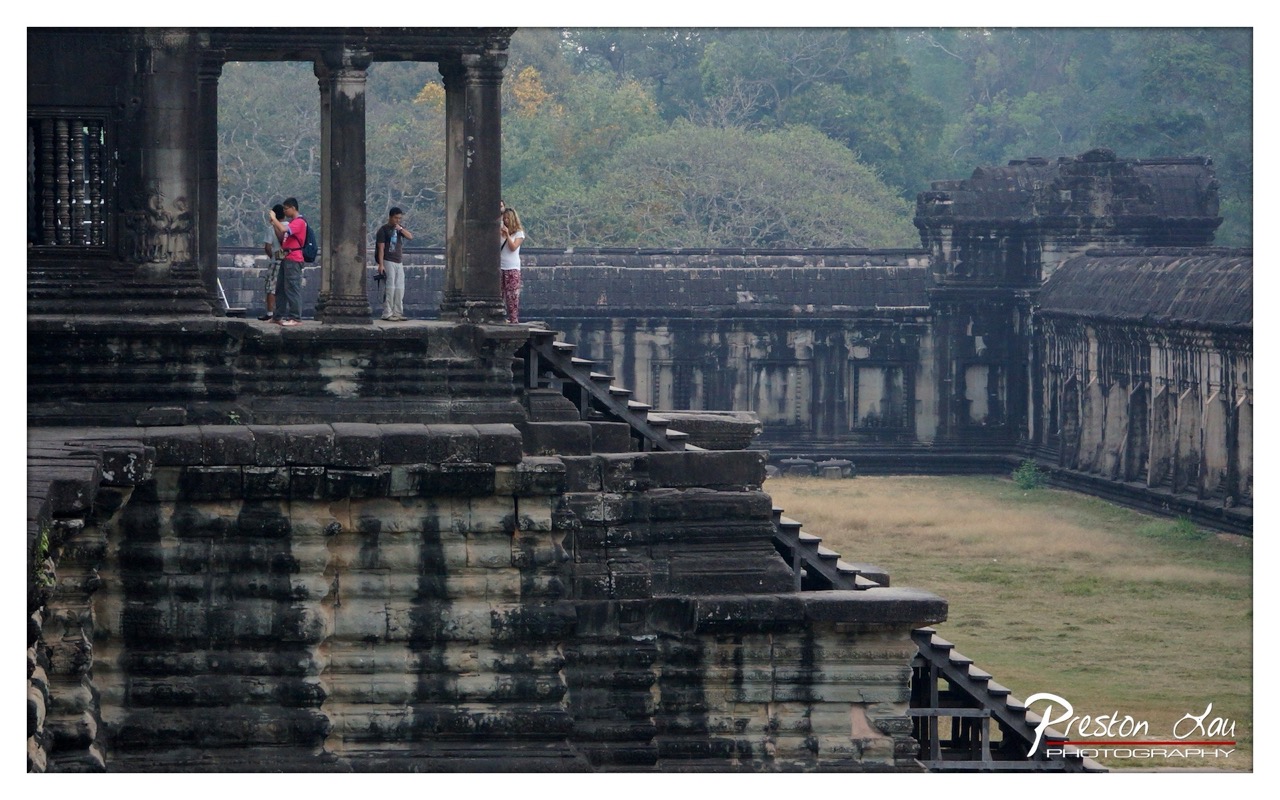

1. Overall Rating (0–10) — 7.0
This photograph captures the quiet grandeur of an ancient temple complex, where weathered stone and overgrown foliage speak to centuries of history. The presence of tourists adds a human scale, grounding the monumental architecture in lived experience. While the muted tones and soft light lend a contemplative mood, the image’s overall impact is slightly dampened by a lack of dynamic contrast and visual tension.
2. Composition (0–10) — 6.5
The layered stone structures create a strong sense of depth, with the stairs leading the eye upward toward the figures. However, the composition feels slightly off-center, with the main architectural elements occupying the left and right edges, leaving the central space less defined. A tighter crop could enhance focus on the interaction between people and monument.
3. Lighting (0–10) — 6.0
Diffused, overcast light softens the scene, minimizing harsh shadows and allowing subtle textures in the stone to emerge. While this creates a somber, atmospheric mood, it also flattens the image, reducing the dramatic interplay of light and shadow that could heighten the sense of time and place.
4. Color & Tone (0–10) — 6.5
The palette is dominated by earthy grays and muted greens, reflecting the aged stone and surrounding jungle. The colors are harmonious but subdued, with a slight cool cast that enhances the melancholic tone. A touch more saturation could bring out the richness of the moss and stonework without compromising authenticity.
5. Creativity (0–10) — 7.0
The image successfully blends historical grandeur with contemporary human presence, creating a narrative of endurance and memory. The framing, while not perfectly balanced, offers a contemplative perspective that invites the viewer to consider the intersection of past and present.
6. Technical Quality (0–10) — 7.5
The photograph is sharp and detailed, with clear focus on the foreground stonework and the figures in the midground. The exposure is well-managed, avoiding overexposed highlights or crushed shadows, though the lack of vibrancy limits the overall visual punch.
7. Emotional Impact (0–10) — 7.0
The image evokes a sense of reverence and quiet wonder, underscored by the scale of the ruins and the fleeting presence of visitors. There is a subtle melancholy in the weathered stones and overgrown walls, suggesting the passage of time and the fragility of memory.
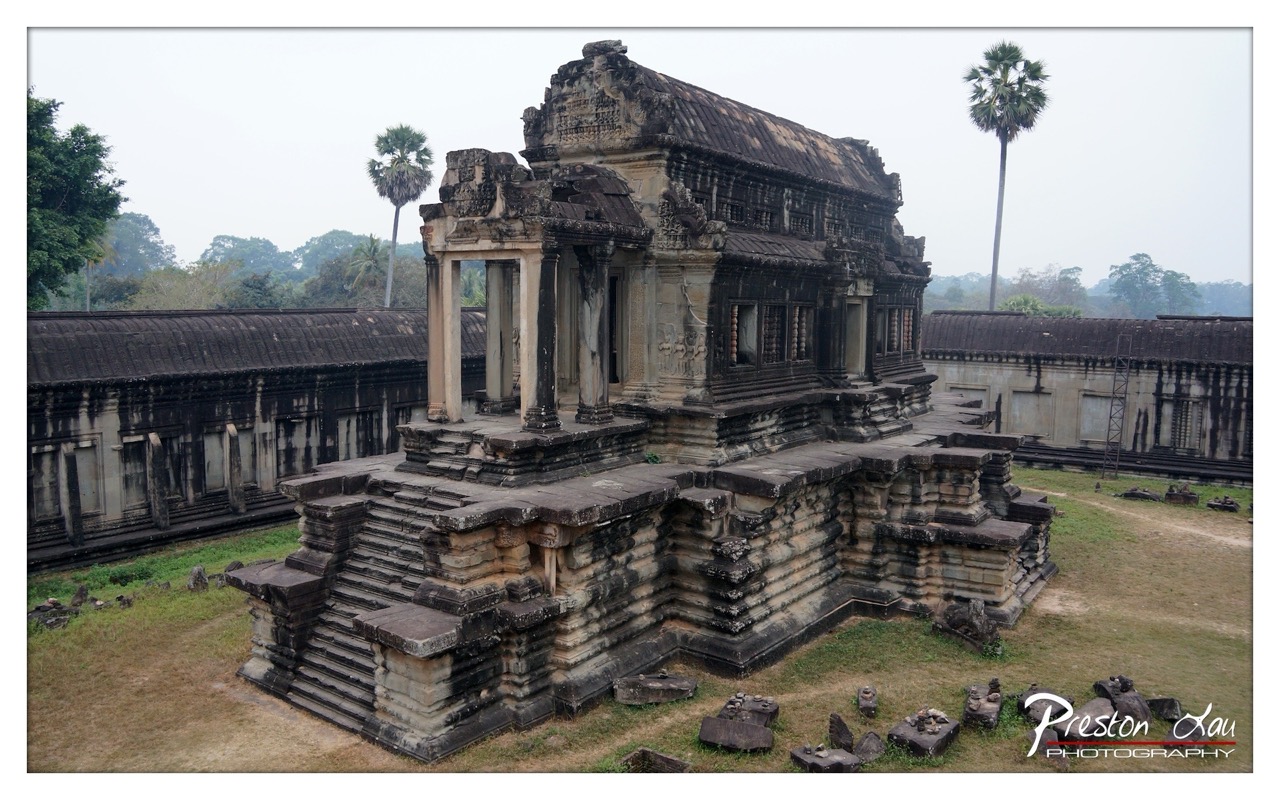

1. Overall Rating (0–10) — 7.0
This photograph captures the solemn grandeur of an ancient temple complex, where time and nature have etched their stories into weathered stone. The composition balances the architectural intricacy of the central structure with the quiet expanse of its surroundings, evoking a sense of reverence and historical depth. While the overcast sky tempers the scene’s drama, the image succeeds in conveying the enduring presence of a civilization long past, with its strength lying in its authenticity and atmospheric stillness.
2. Composition (0–10) — 7.5
The central temple is framed with deliberate symmetry, drawing the eye upward along the steps and toward the ornate entrance. The inclusion of the palm trees and surrounding walls adds depth and context, while the scattered stone fragments in the foreground provide a subtle narrative of decay and endurance.
3. Lighting (0–10) — 6.0
The diffuse, overcast light softens shadows and highlights the texture of the stone, but it also flattens the image’s tonal range. While this contributes to the contemplative mood, it diminishes the dramatic interplay of light and shadow that could have emphasized the temple’s sculptural details.
4. Color & Tone (0–10) — 6.5
The palette is restrained—dominated by muted grays, earthy browns, and the pale green of the distant foliage—creating a somber, cohesive tone. A touch of warmth in the stone’s coloration would have enhanced the visual richness without disrupting the mood.
5. Creativity (0–10) — 7.0
The photographer captures a moment of quiet contemplation rather than spectacle, focusing on the temple’s integration with its environment. The choice to include the scattered ruins in the foreground adds a narrative layer, suggesting both loss and resilience.
6. Technical Quality (0–10) — 8.0
The image is sharp and detailed, particularly in the stonework and carvings. The exposure is well-balanced, with no significant overexposed or underexposed areas, and the focus is consistent throughout the frame.
7. Emotional Impact (0–10) — 7.5
The image evokes a sense of awe and melancholy, inviting the viewer to reflect on the passage of time and the endurance of human achievement. The stillness of the scene and the weight of history lend it a powerful emotional resonance.
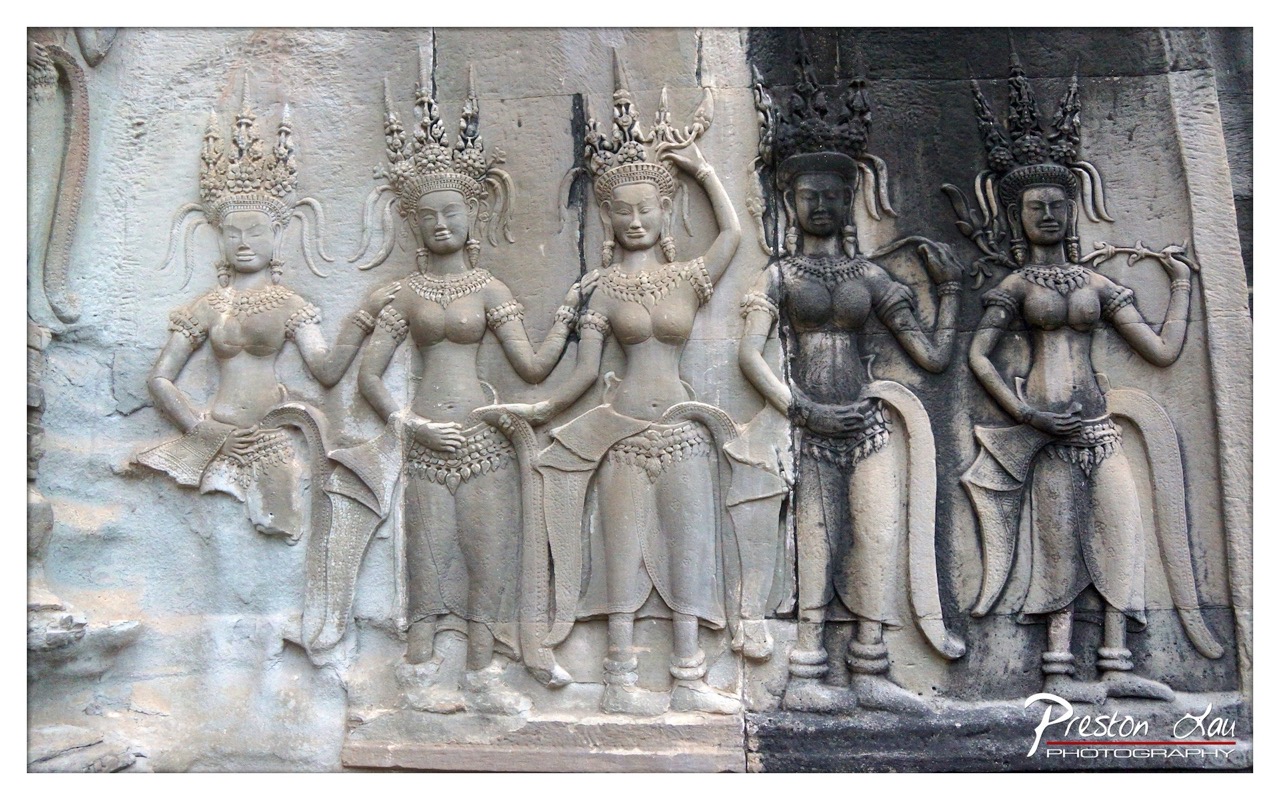

1. Overall Rating (0–10) — 7.5
This photograph captures the intricate artistry of Khmer bas-relief sculpture with remarkable clarity, conveying both the historical grandeur and delicate craftsmanship of Angkor Wat. The contrast between light and shadow accentuates the depth and texture of the stone carvings, while the composition frames the figures in a way that invites contemplation of their cultural and religious significance. While the image is strong in detail and mood, the slight uneven lighting and darkened right side slightly diminish its overall visual harmony.
2. Composition (0–10) — 7.0
The central alignment of the five figures provides a balanced and symmetrical arrangement, emphasizing the ceremonial nature of the scene. The framing captures the full breadth of the relief, though a tighter crop could have focused more intently on the most detailed figures and minimized distracting background elements.
3. Lighting (0–10) — 6.5
The natural light enhances the three-dimensional quality of the carvings, with directional sunlight creating depth and highlighting the intricate details. However, the right portion of the relief is noticeably darker, suggesting uneven exposure or shadow from an overhang, which reduces the uniformity of the image.
4. Color & Tone (0–10) — 7.0
The monochromatic stone palette is rendered with subtle tonal variation, emphasizing the age and weathering of the temple. The cool, neutral tones enhance the timeless and solemn atmosphere, though the lack of vibrant color reflects the photograph’s focus on texture and form rather than emotional vibrancy.
5. Creativity (0–10) — 7.5
The photographer successfully captures a moment of cultural heritage with a respectful and observational approach, allowing the artistry of the relief to speak for itself. The choice to include the full row of figures conveys narrative continuity, while the watermark subtly reinforces authorship without distracting from the subject.
6. Technical Quality (0–10) — 8.0
Sharp focus across the relief ensures that fine details—such as the crowns, jewelry, and flowing garments—are clearly visible. The exposure is generally well-handled, with good dynamic range, though the darker right side indicates a slight imbalance in lighting control.
7. Emotional Impact (0–10) — 7.0
The image evokes a sense of reverence and awe, inviting the viewer to reflect on the skill and devotion behind these ancient carvings. The stillness and symmetry of the figures create a contemplative mood, connecting the viewer to a long-ago spiritual world, though the lack of human presence keeps the emotional connection somewhat distant.
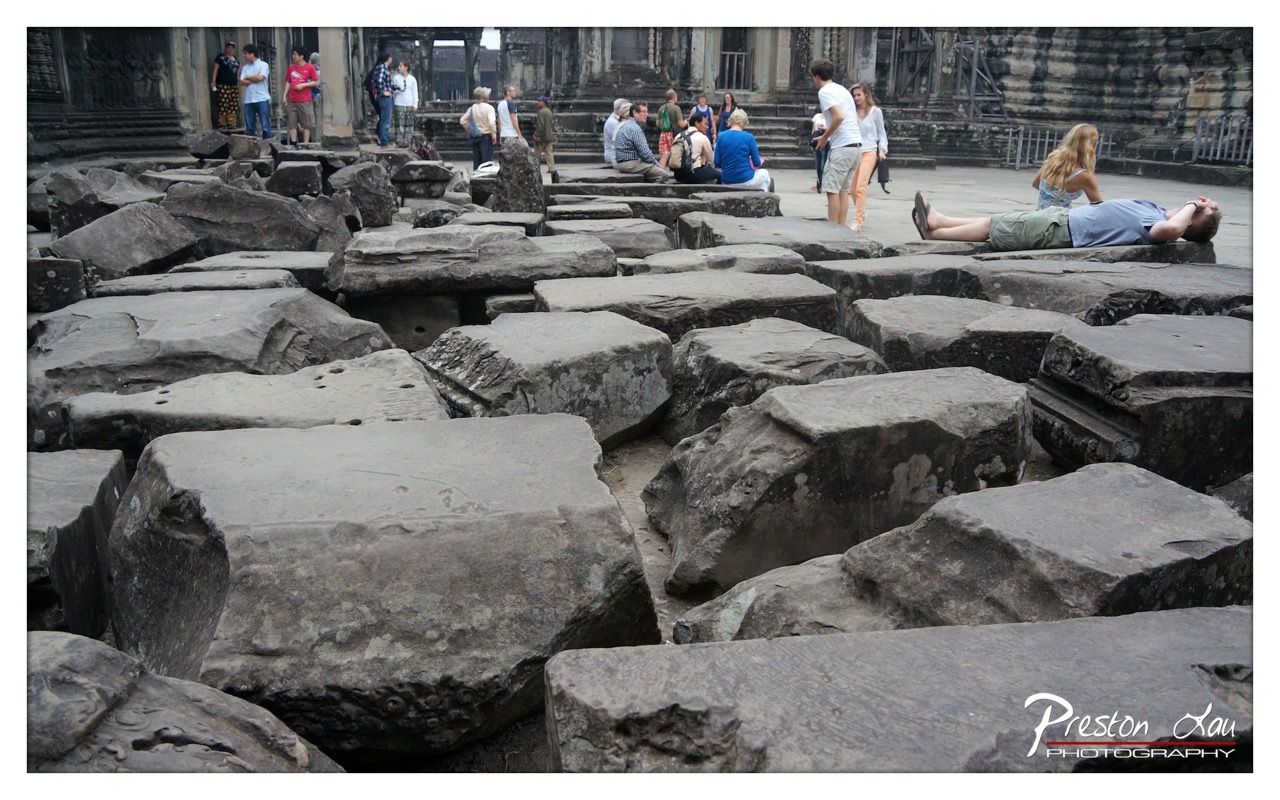

1. Overall Rating (0–10) — 7.0
This photograph captures the haunting grandeur of an ancient ruin, where the weight of history is etched into every weathered stone. The juxtaposition of tourists exploring the site with the man lying peacefully on the rubble introduces a quiet, contemplative tension—human presence framed by time’s erosion. While the image’s narrative depth is compelling, its muted tones and slightly cluttered foreground diminish the visual impact, keeping it from achieving a truly cinematic resonance.
2. Composition (0–10) — 6.5
The low-angle perspective emphasizes the scale of the fallen stones, creating a sense of immersion, but the foreground clutter slightly disrupts the visual flow. The man lying down acts as a focal point, though his placement on the right edge creates an imbalance.
3. Lighting (0–10) — 6.0
Diffuse, overcast lighting softens the scene, minimizing harsh shadows and preserving detail in the stone textures. However, the lack of directional light reduces depth and drama, giving the image a flat, documentary feel.
4. Color & Tone (0–10) — 5.5
The palette is dominated by monochromatic grays and muted earth tones, which reinforce the somber, historical atmosphere. While consistent, the lack of color contrast limits visual excitement and emotional punch.
5. Creativity (0–10) — 7.0
The conceptual contrast between human stillness and ancient decay offers a poetic narrative. The inclusion of the reclining figure introduces a quiet meditation on time and mortality, elevating the image beyond mere documentation.
6. Technical Quality (0–10) — 7.5
The image is sharp and well-exposed, with clear detail in the stone textures and background figures. The focus is consistent across the frame, supporting the scene’s narrative clarity.
7. Emotional Impact (0–10) — 6.5
The scene evokes a sense of quiet reflection, inviting viewers to ponder the passage of time and the impermanence of human endeavors. The emotional resonance is subtle but meaningful, particularly for those attuned to history and decay.
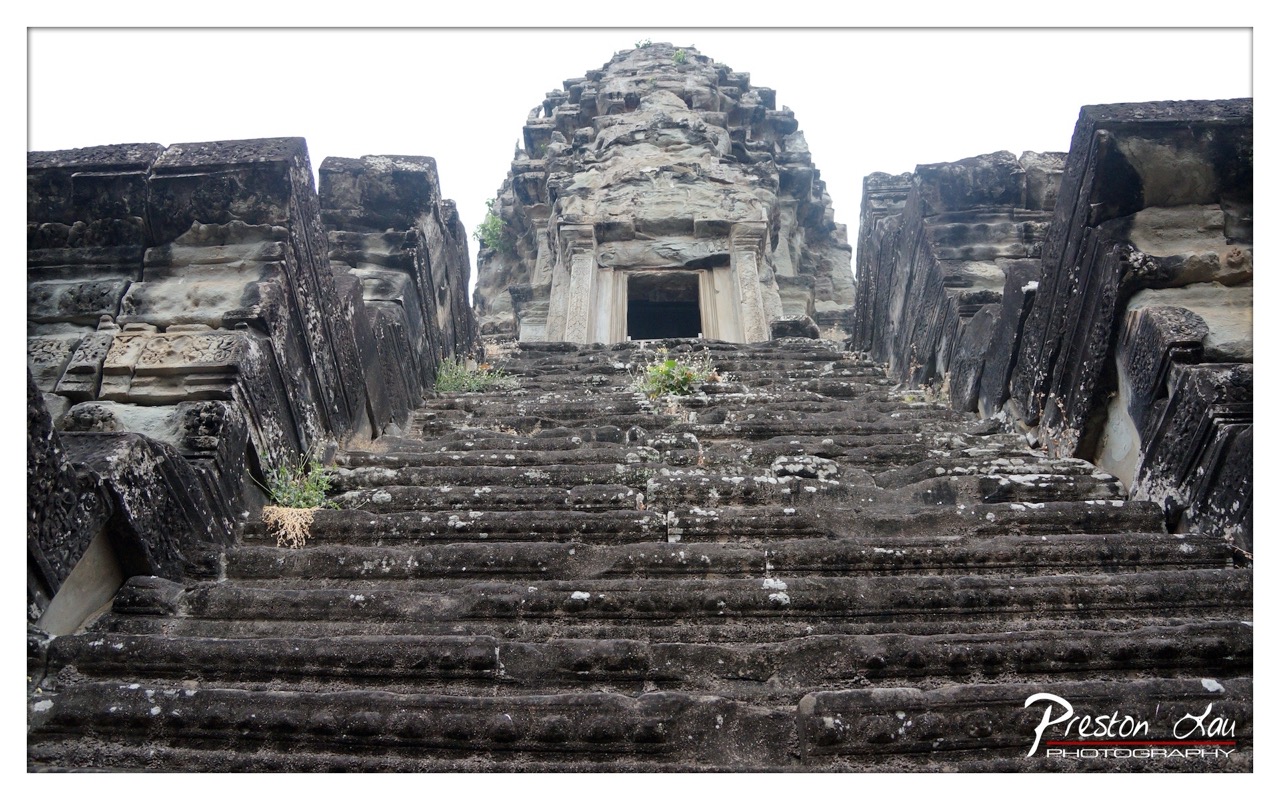

1. Overall Rating (0–10) — 7.0
This photograph captures the solemn grandeur of an ancient temple, its weathered stone steps leading the eye toward a crumbling sanctuary under an overcast sky. The low-angle perspective enhances the monumentality of the structure, while the presence of vegetation sprouting between the stones speaks to time’s quiet erosion. Though the lighting is flat and the sky overexposed, the image conveys a powerful sense of history and stillness, inviting contemplation of decay and endurance.
2. Composition (0–10) — 8.0
The symmetrical framing along the central staircase creates a strong leading line, drawing the viewer’s gaze directly to the temple entrance. The balance between the flanking walls and the ascending steps imparts a sense of order and purpose, reinforcing the spiritual journey implied by the architecture.
3. Lighting (0–10) — 5.5
The diffuse, overcast light minimizes shadows and flattens the texture of the stone, reducing depth and drama. While it ensures even exposure across the scene, the lack of contrast and directional light weakens the sculptural quality of the carvings and stonework.
4. Color & Tone (0–10) — 6.0
The palette is dominated by muted grays and earthy tones, with subtle white lichen and green sprouts offering small points of color. The overall tonal range is narrow, giving the image a somber, almost monochromatic feel that suits the subject but lacks visual richness.
5. Creativity (0–10) — 7.0
The choice to frame the shot from the base of the steps imbues the image with a sense of reverence and ascent. The photographer captures not just a temple, but a narrative of time, faith, and nature reclaiming the man-made—offering a contemplative, almost cinematic interpretation of a historic site.
6. Technical Quality (0–10) — 7.5
The image is sharp and detailed, with clear definition in the texture of the stone and the surrounding carvings. Focus is consistent across the frame, and the exposure is balanced despite the bright sky. The watermark is unobtrusive and professionally placed.
7. Emotional Impact (0–10) — 7.5
There is a profound sense of quiet awe and melancholy, evoked by the scale of the ruins and the evidence of time’s passage. The viewer is invited to imagine the footsteps of countless pilgrims and the weight of centuries, creating a strong emotional connection to the past.
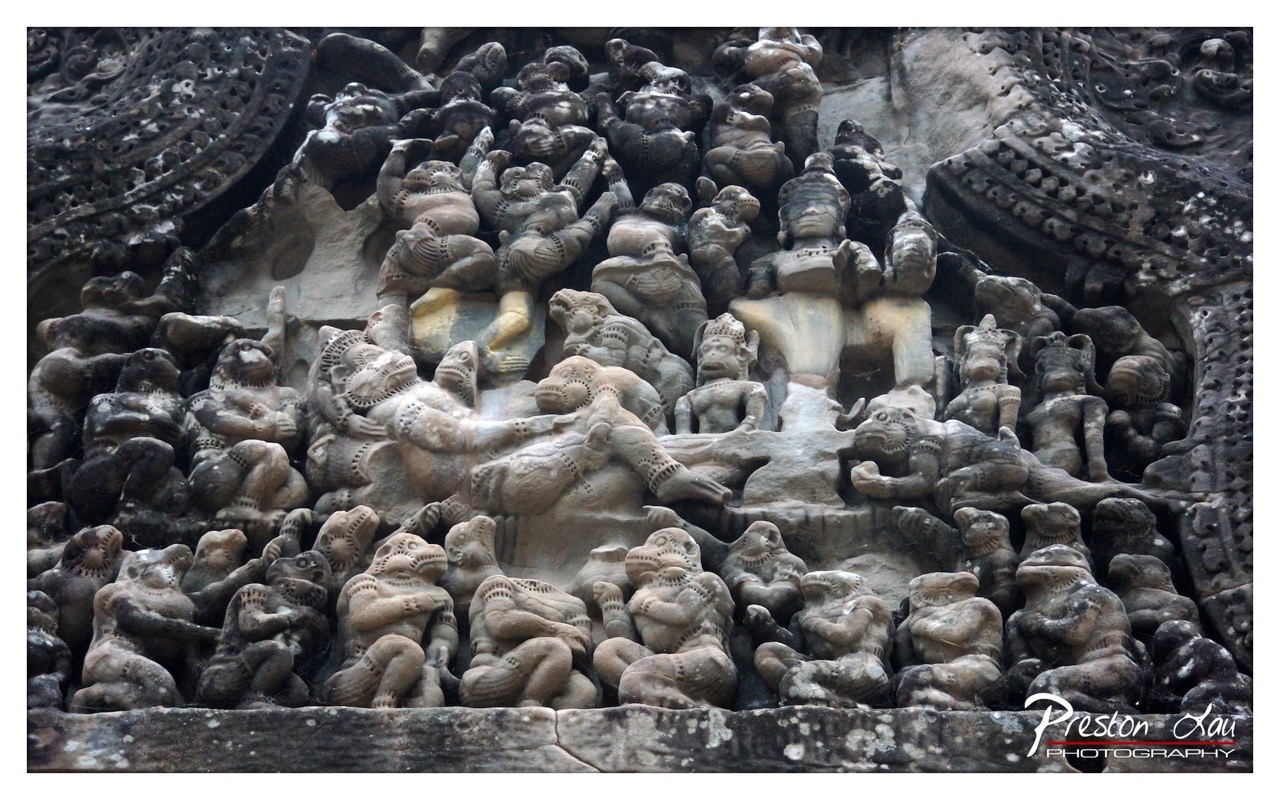

1. Overall Rating (0–10) — 7.5
This photograph captures the intricate and chaotic energy of a bas-relief carving, brimming with mythological figures locked in eternal struggle. The density of detail and the weathered texture of the stone lend a sense of ancient gravity and narrative depth. While the composition is rich with visual information, it risks overwhelming the viewer due to the sheer number of figures and the lack of a clear focal point.
2. Composition (0–10) — 6.0
The frame is tightly packed with figures, creating a sense of visual congestion. The central figure, though slightly more prominent, is not clearly emphasized, and the lack of negative space diminishes the clarity of the narrative flow.
3. Lighting (0–10) — 6.5
The lighting is soft and diffuse, likely from an overcast sky, which helps reveal the depth of the carvings without harsh shadows. However, the even illumination flattens some of the three-dimensional detail, reducing the dramatic impact of the relief.
4. Color & Tone (0–10) — 6.0
The palette is muted and monochromatic, dominated by weathered stone grays and subtle earth tones. While this reinforces the ancient and enduring nature of the subject, the lack of color variation limits visual vibrancy and emotional resonance.
5. Creativity (0–10) — 7.0
The image successfully captures the complexity and storytelling of the relief, presenting it as both a historical artifact and a visual tapestry. The photographer’s choice to frame the scene densely reflects the narrative density of the carving itself, though a more deliberate selection of subject or angle might enhance the artistic interpretation.
6. Technical Quality (0–10) — 8.0
The image is sharp and detailed, with excellent clarity in the textures of the stone. The focus is consistent across the frame, allowing the viewer to explore the intricacies of the carvings without distraction.
7. Emotional Impact (0–10) — 6.5
The photograph conveys a sense of awe and reverence for the craftsmanship and cultural legacy of the site. While the emotional weight is present, the visual complexity and lack of a strong focal point prevent the image from fully drawing the viewer into a singular emotional moment.
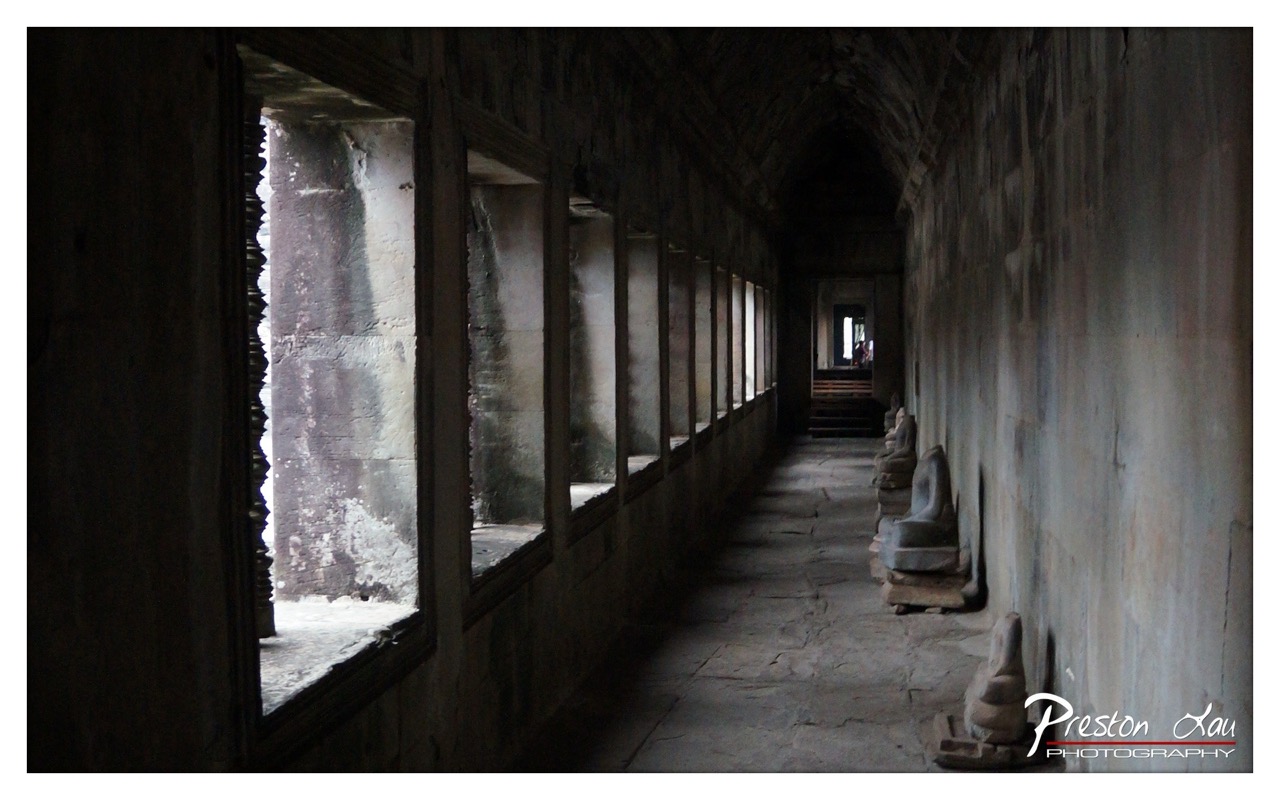

1. Overall Rating (0–10) — 7.5
This photograph captures the solemn stillness of an ancient temple corridor, where time seems to have paused. The interplay of deep shadows and soft, natural light filtering through the windows creates a meditative atmosphere, emphasizing the passage of centuries. While the image is compelling in mood and composition, its lack of vibrant contrast and slightly muted tonal range keeps it from achieving full visual impact.
2. Composition (0–10) — 8.0
The long, narrow corridor creates a strong sense of depth and perspective, drawing the eye toward the distant opening. The repeating verticals of the window frames and the line of stone statues on the right guide the viewer’s gaze, enhancing the architectural rhythm. The framing feels deliberate and balanced, though the left side’s heavy shadow slightly disrupts symmetry.
3. Lighting (0–10) — 7.0
Natural light enters from the windows on the left, casting soft, directional illumination that highlights texture and depth. The contrast between the bright openings and the dark interior enhances the sense of mystery and age. While the lighting is atmospheric, the deep shadows on the right wall reduce detail in those areas, slightly limiting tonal range.
4. Color & Tone (0–10) — 6.5
The palette is subdued, dominated by grays and earth tones that reflect the weathered stone. The lack of color saturation lends authenticity but also a muted, almost melancholic quality. A touch more warmth or contrast in the highlights could have enlivened the scene without sacrificing its historical tone.
5. Creativity (0–10) — 7.5
The photograph succeeds in capturing the quiet reverence of the space, using composition and light to tell a story of endurance and silence. The choice to frame the corridor with the statues and the distant light at the end suggests a spiritual journey, offering a contemplative narrative that feels both personal and universal.
6. Technical Quality (0–10) — 8.0
The image is sharp and clear, with well-managed focus across the corridor. The noise level is low, and the dynamic range is handled well, preserving detail in both the bright and dark areas. The watermark is subtle and does not detract from the visual integrity.
7. Emotional Impact (0–10) — 8.0
There is a powerful sense of solitude and timelessness that resonates deeply. The viewer is invited to walk the corridor, to feel the weight of history and the quiet presence of the past. The image evokes introspection and wonder, making it emotionally compelling and memorable.
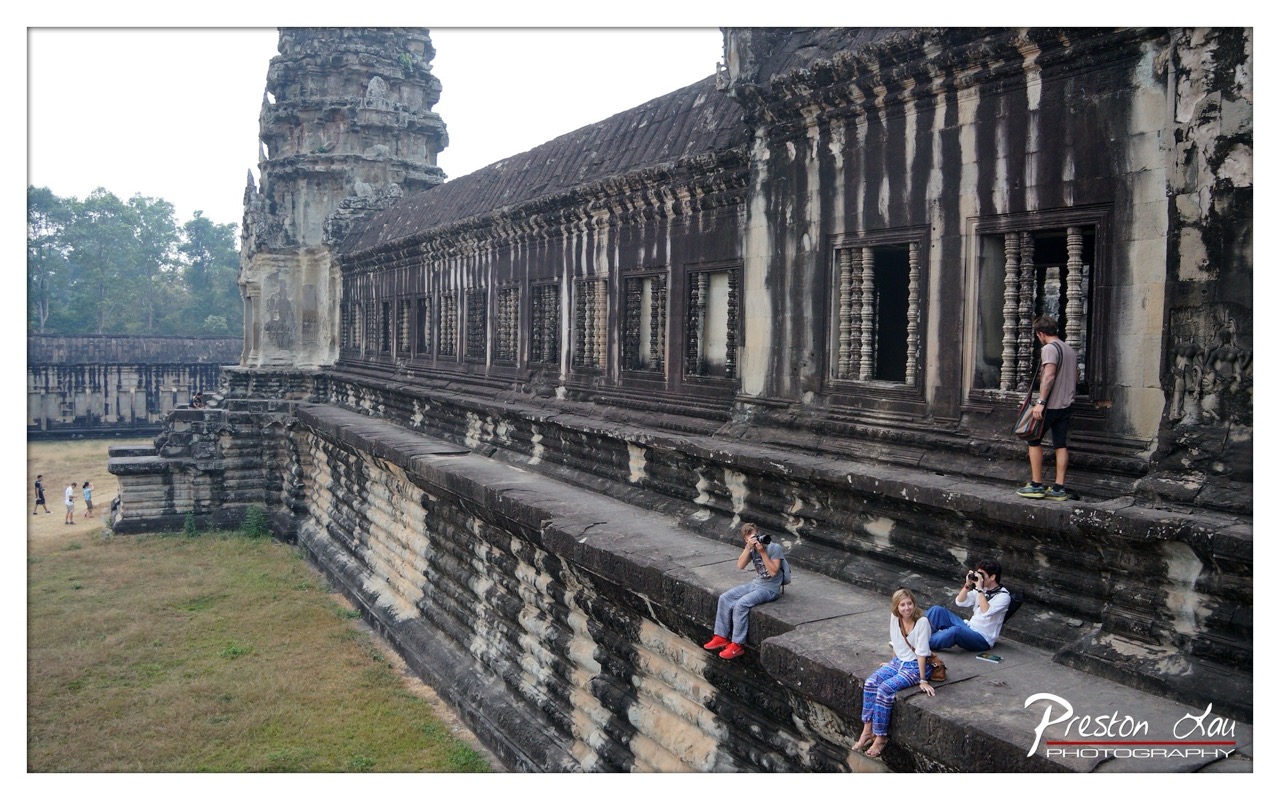

1. Overall Rating (0–10) — 7.0
This photograph captures the juxtaposition of ancient grandeur and modern tourism at Angkor Wat, where time-worn stone walls stand as silent witnesses to countless visitors. The composition balances the massive scale of the temple with the intimate presence of tourists, creating a narrative of discovery and reverence. While the image is visually engaging, its emotional depth is slightly muted by the overcast light and the somewhat chaotic arrangement of people.
2. Composition (0–10) — 6.5
The long horizontal structure of the temple dominates the frame, creating a strong sense of scale. The placement of tourists along the stone ledge adds visual interest and scale, but the scattered positioning of figures—particularly the lone photographer on the far left—creates a slight imbalance. A tighter focus on the central group could enhance narrative cohesion.
3. Lighting (0–10) — 5.5
The diffuse, overcast light softens shadows and flattens the scene, reducing the dramatic texture of the stone. While this allows for even exposure across the temple’s weathered surface, it diminishes the sense of depth and atmosphere that would be present in golden-hour light.
4. Color & Tone (0–10) — 6.0
The palette is largely muted, dominated by earthy grays and browns, which aligns with the aged stone. However, the lack of vibrancy in the colors, particularly in the sky and grass, gives the image a slightly dull appearance. A touch of warmer tones could have added visual warmth and contrast.
5. Creativity (0–10) — 7.0
The photographer captures a compelling narrative—tourists interacting with a sacred historical site—by framing the scene to emphasize both human scale and architectural majesty. The inclusion of people engaged in photography adds a layer of meta-commentary on the act of witnessing and documenting history.
6. Technical Quality (0–10) — 7.5
The image is sharp and well-focused, with clear details in the temple’s intricate carvings and the textures of the stone. The exposure is balanced, and the watermark is discreet, indicating strong technical control.
7. Emotional Impact (0–10) — 6.5
The image evokes a sense of awe and contemplation, inviting the viewer to reflect on the passage of time and the human desire to connect with the past. While the emotional resonance is present, it is tempered by the impersonal quality of the lighting and the casual demeanor of the subjects.
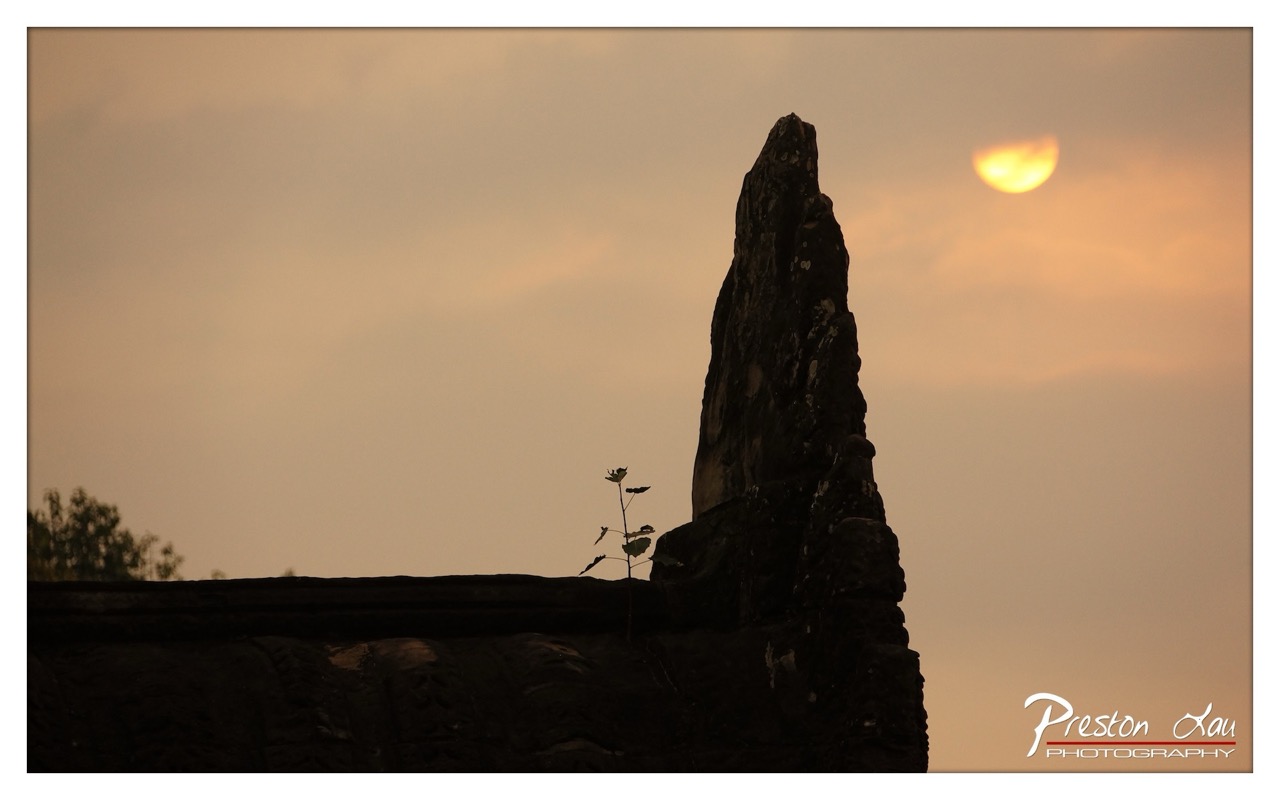

1. Overall Rating (0–10) — 7.5
This photograph captures a moment of quiet reverence, where ancient stone and natural light converge in a meditative stillness. The silhouette of the weathered spire against the glowing sunset evokes a sense of timelessness and resilience, while the delicate sprout adds a subtle narrative of life persisting through decay. Though the image is strong in mood and symbolism, it lacks a bit of visual punch due to the muted tonal range, keeping it from achieving full emotional resonance.
2. Composition (0–10) — 7.0
The vertical spire anchors the frame on the right, creating a strong focal point that draws the eye upward. The small plant on the left balances the composition, while the setting sun in the upper right adds a gentle counterweight. The framing feels intentional, though slightly tight, leaving room for a more expansive sense of space.
3. Lighting (0–10) — 8.0
The golden hour light bathes the sky in warm, soft tones, creating a luminous backdrop that enhances the silhouette effect. The low-angle sunlight emphasizes texture and form, casting deep shadows that define the stone’s age and character. The moon-like orb of the sun adds a celestial quality, elevating the scene’s atmosphere.
4. Color & Tone (0–10) — 7.0
A warm, analogous palette of amber and muted orange dominates, creating a cohesive and harmonious tone. The dark silhouette contrasts sharply with the glowing sky, though the overall tonal range is somewhat compressed, limiting the depth of the gradient. A touch more contrast in the midtones could enhance the image’s richness.
5. Creativity (0–10) — 8.0
The juxtaposition of ancient stone, a single sprout, and the setting sun suggests a layered narrative of endurance and renewal. The photographer’s choice to shoot in silhouette transforms the scene from mere documentation into a symbolic meditation on time and nature, demonstrating strong artistic intent.
6. Technical Quality (0–10) — 8.0
The image is sharp and clean, with well-managed exposure and minimal noise. The focus is precise on the spire’s silhouette, and the lighting conditions allow for a balanced exposure across the sky. The watermark is unobtrusive and professionally placed.
7. Emotional Impact (0–10) — 8.0
There is a profound sense of peace and contemplation in the image, inviting the viewer to reflect on the passage of time and the quiet persistence of life. The combination of decay and growth, shadow and light, evokes a quiet melancholy and wonder that lingers after viewing.
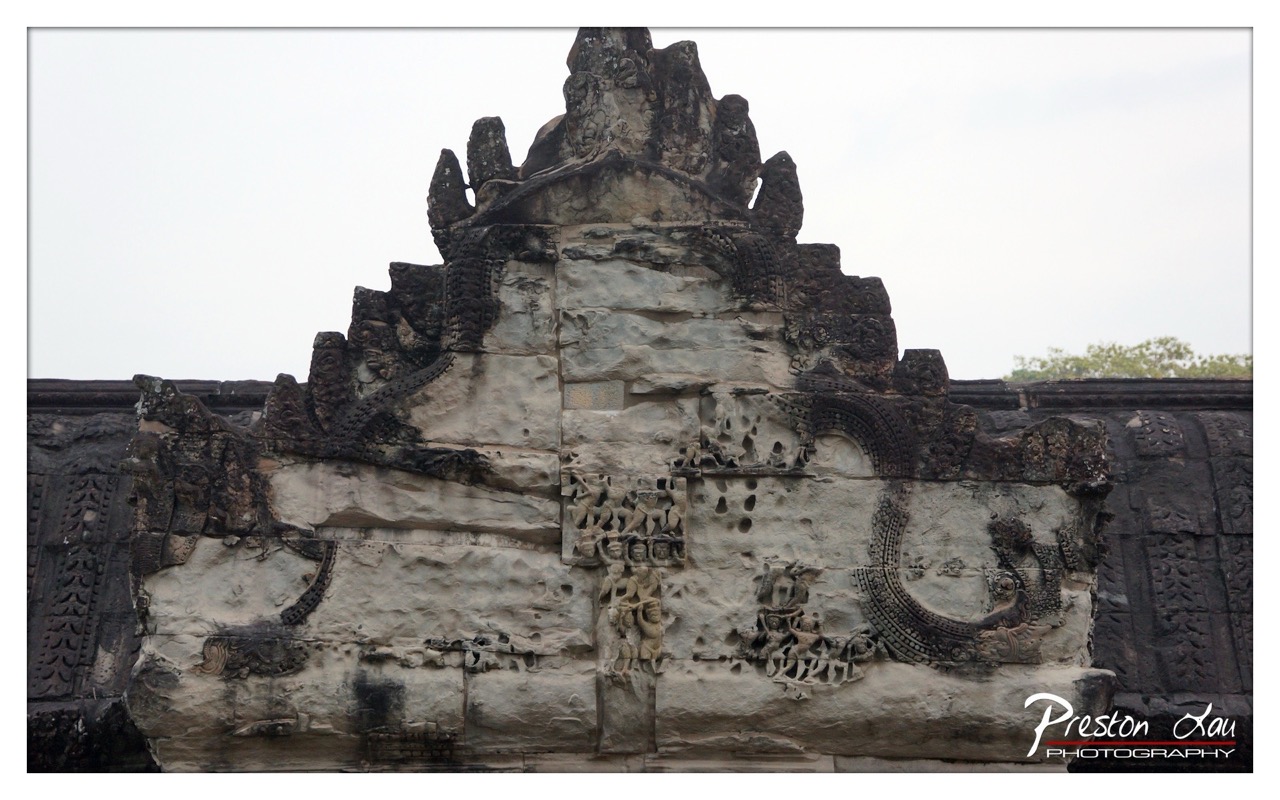

1. Overall Rating (0–10) — 7.0
This photograph captures the weathered grandeur of an ancient temple facade, where time and nature have etched their stories into the stone. The intricate carvings and layered textures speak to a rich cultural heritage, while the overcast sky lends a somber, contemplative mood. Though the image is strong in detail and historical resonance, the muted lighting and lack of dynamic contrast slightly dampen its visual impact.
2. Composition (0–10) — 6.5
The central focus on the ornate pediment is well-framed, but the composition feels slightly top-heavy due to the large expanse of sky. A tighter crop could emphasize the architectural details and create a more balanced visual weight.
3. Lighting (0–10) — 5.5
The diffuse, overcast light evenly illuminates the subject, minimizing harsh shadows and allowing for clear visibility of the carvings. However, the lack of directional light reduces depth and dimensionality, giving the image a flat, muted quality.
4. Color & Tone (0–10) — 6.0
The palette is restrained, dominated by grays and earthy tones that reflect the aged stone. While this reinforces the historical atmosphere, the absence of tonal contrast and color vibrancy limits the image’s visual appeal.
5. Creativity (0–10) — 7.0
The photographer captures a moment of quiet reverence, presenting the temple not as a mere landmark but as a living relic. The focus on intricate details and decay offers a poetic interpretation of time’s passage, blending documentation with storytelling.
6. Technical Quality (0–10) — 7.5
The image is sharp and detailed, with clear definition in the carved reliefs. The focus is consistent across the frame, and the exposure is well-managed, preserving texture without overexposing highlights.
7. Emotional Impact (0–10) — 6.5
There is a quiet dignity in the image, evoking a sense of awe and melancholy. The viewer is invited to contemplate the endurance of art and culture, though the subdued tone keeps the emotional connection at a distance.
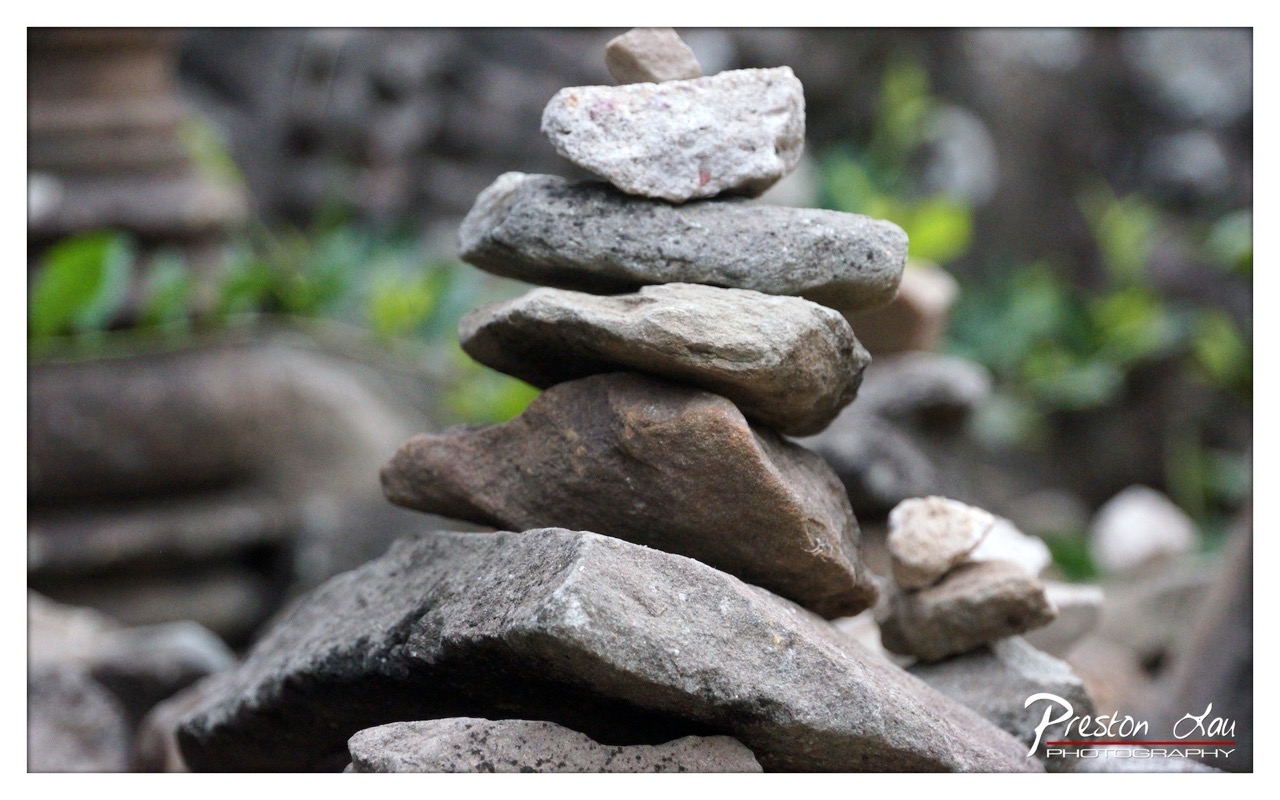

1. Overall Rating (0–10) — 7.0
This photograph captures the quiet balance and meditative stillness of a stone cairn, evoking a sense of harmony between nature and human intention. The careful stacking of stones creates a focal point of serenity, while the soft, natural backdrop enhances the contemplative mood. Though the image is visually calm, its emotional depth could be heightened with more dynamic lighting and a stronger sense of narrative.
2. Composition (0–10) — 7.5
The cairn is centered with a clear focal point, drawing the eye upward along the stacked stones. The shallow depth of field effectively isolates the subject, while the blurred background of foliage and rock adds context without distraction. The composition is balanced and deliberate, emphasizing the structure's stability and fragility.
3. Lighting (0–10) — 6.0
Soft, diffused light illuminates the scene evenly, preserving the natural textures of the stones without harsh shadows. However, the lighting is somewhat flat, lacking directional warmth or contrast that might enhance the mood and give the image more dimension.
4. Color & Tone (0–10) — 6.5
The palette is restrained, dominated by earthy grays and muted greens, which supports the natural, meditative tone. While the colors are harmonious, they lack vibrancy and could benefit from a slightly cooler or warmer cast to add emotional nuance.
5. Creativity (0–10) — 7.0
The image is conceptually strong, leveraging the symbolism of the cairn as a gesture of balance and mindfulness. The photographer's choice to focus on the structure in a quiet, natural setting is both poetic and thoughtful, though it remains within a familiar visual tradition.
6. Technical Quality (0–10) — 8.0
Sharp focus on the central stones ensures clarity and detail, while the smooth bokeh in the background demonstrates effective use of aperture. The image is well-exposed, with no noticeable noise or artifacts, reflecting solid technical execution.
7. Emotional Impact (0–10) — 7.0
There is a quiet introspection in the image, inviting contemplation of stillness and impermanence. The viewer is drawn into a moment of calm, though the emotional resonance is subtle, resting more on atmosphere than dramatic expression.
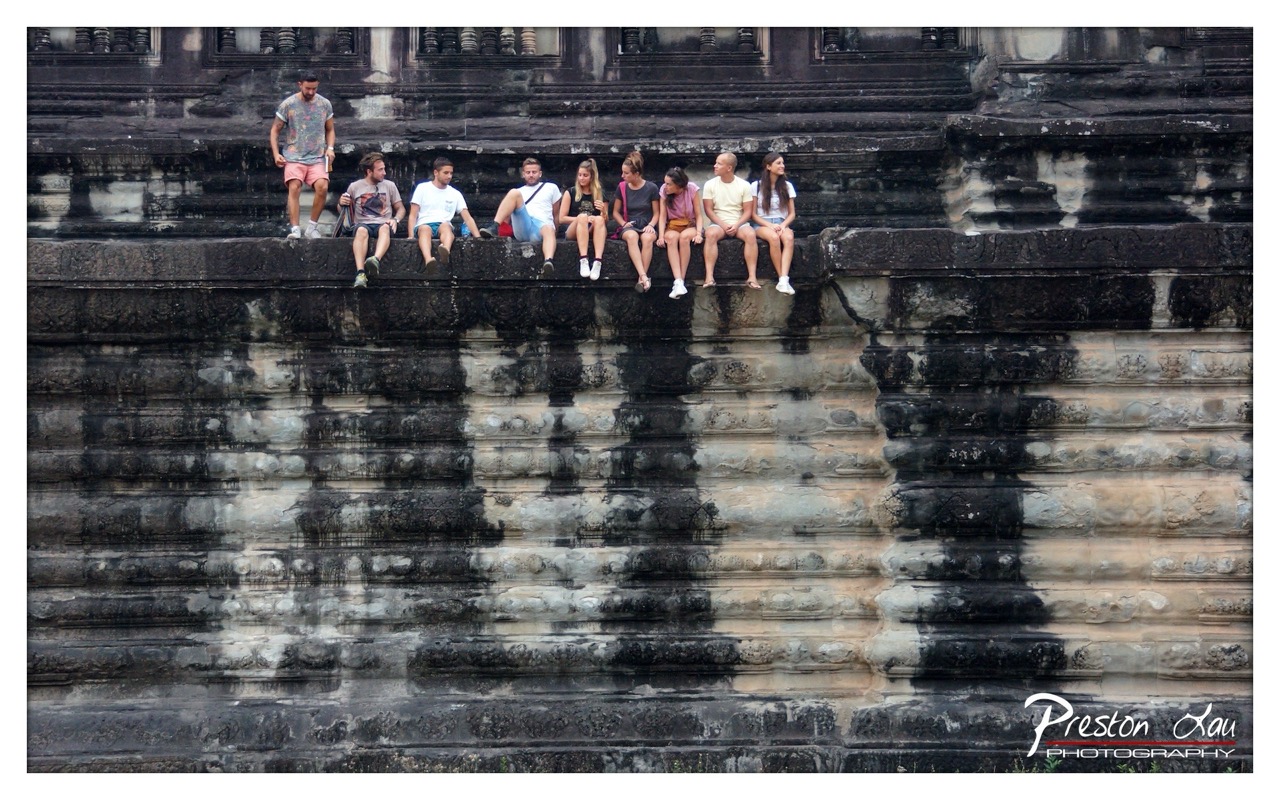

1. Overall Rating (0–10) — 6.8
This photograph captures a striking juxtaposition between ancient stone and modern tourism, where the weight of history is softened by the casual presence of tourists. The weathered texture of the temple wall and the dark, water-stained patterns evoke a sense of time’s passage, while the group of visitors introduces a contemporary layer that feels both intrusive and inevitable. While the image successfully frames a moment of cultural intersection, its emotional depth is slightly diluted by the casual composition and lack of narrative focus.
2. Composition (0–10) — 6.0
The horizontal alignment of the group creates a strong visual line, but the framing feels slightly unbalanced, with too much empty space at the bottom. The placement of the standing man on the left edge adds asymmetry, but it doesn’t fully resolve the composition’s inherent flatness.
3. Lighting (0–10) — 6.5
Natural daylight provides even illumination across the scene, preserving detail in the stone textures. However, the lack of directional light results in a flat, unemotional quality that fails to accentuate the architectural depth or create dramatic contrast.
4. Color & Tone (0–10) — 6.0
The palette is dominated by muted earth tones—grays, blacks, and faded beiges—creating a somber, almost monochromatic mood. While this reflects the age of the temple, the lack of vibrancy diminishes the visual energy of the human subjects, making them blend into the background.
5. Creativity (0–10) — 7.0
The concept of contrasting ancient heritage with modern tourism is compelling and thought-provoking. The image captures a real-world tension between preservation and access, offering a subtle commentary on cultural commodification.
6. Technical Quality (0–10) — 7.5
The image is sharp and clear, with well-defined textures in the stonework and clean focus on the subjects. The exposure is balanced, and the watermark is discreet, preserving the image’s integrity.
7. Emotional Impact (0–10) — 6.0
The photograph evokes a quiet melancholy—the feeling of history being observed, but not deeply engaged with. While the scene is visually striking, it stops short of eliciting a strong emotional response, leaving the viewer as a passive observer rather than an emotional participant.
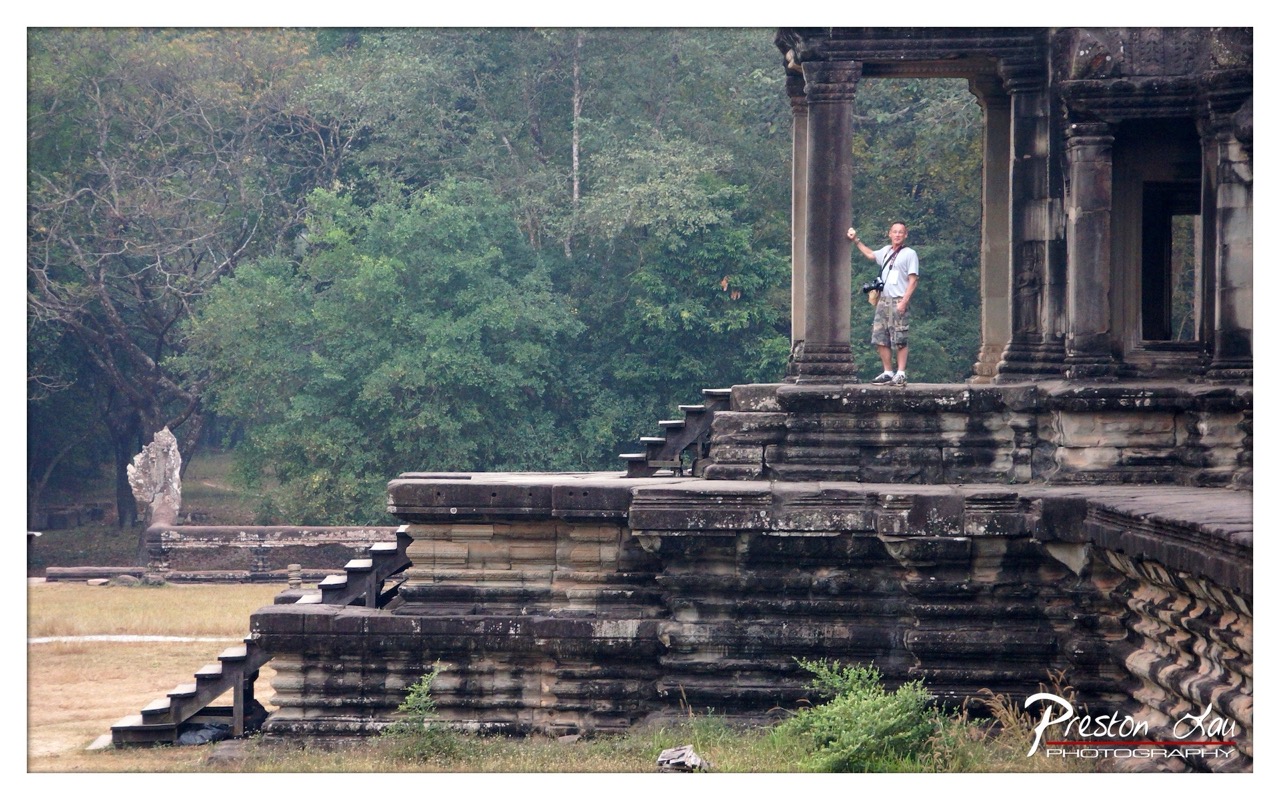

1. Overall Rating (0–10) — 6.8
This photograph captures a contemplative moment at an ancient temple, where human presence is both a point of scale and a bridge between past and present. The weathered stone and surrounding forest lend a sense of timelessness, while the solitary figure adds narrative weight. Though the image is grounded in authenticity, the composition and lighting hold back its emotional resonance, leaving it more documentary than poetic.
2. Composition (0–10) — 6.5
The subject is placed off-center, framed by the temple’s arch and columns, creating a natural visual anchor. The diagonal lines of the stairs lead the eye upward, but the wide framing dilutes focus and introduces visual clutter in the foreground.
3. Lighting (0–10) — 5.5
Diffused daylight flattens the scene, softening textures and reducing contrast. While it prevents harsh shadows, it also diminishes the depth and drama that would elevate the ancient stonework.
4. Color & Tone (0–10) — 6.0
The palette is muted, dominated by earthy tones and overcast greens. The lack of vibrancy softens the image, but the tonal balance supports the historical and natural atmosphere.
5. Creativity (0–10) — 6.5
The concept of juxtaposing a modern traveler with ancient ruins is compelling and familiar, but the execution remains conventional. The image tells a story, but it doesn’t reinterpret it with fresh vision.
6. Technical Quality (0–10) — 7.5
The focus is sharp on the central figure and temple, with good clarity throughout. The image is well-exposed and free of distracting technical flaws.
7. Emotional Impact (0–10) — 6.0
The image evokes a quiet sense of awe and reflection, but the emotional pull is restrained by the flat lighting and lack of dramatic tension. It invites contemplation but doesn’t deeply move.
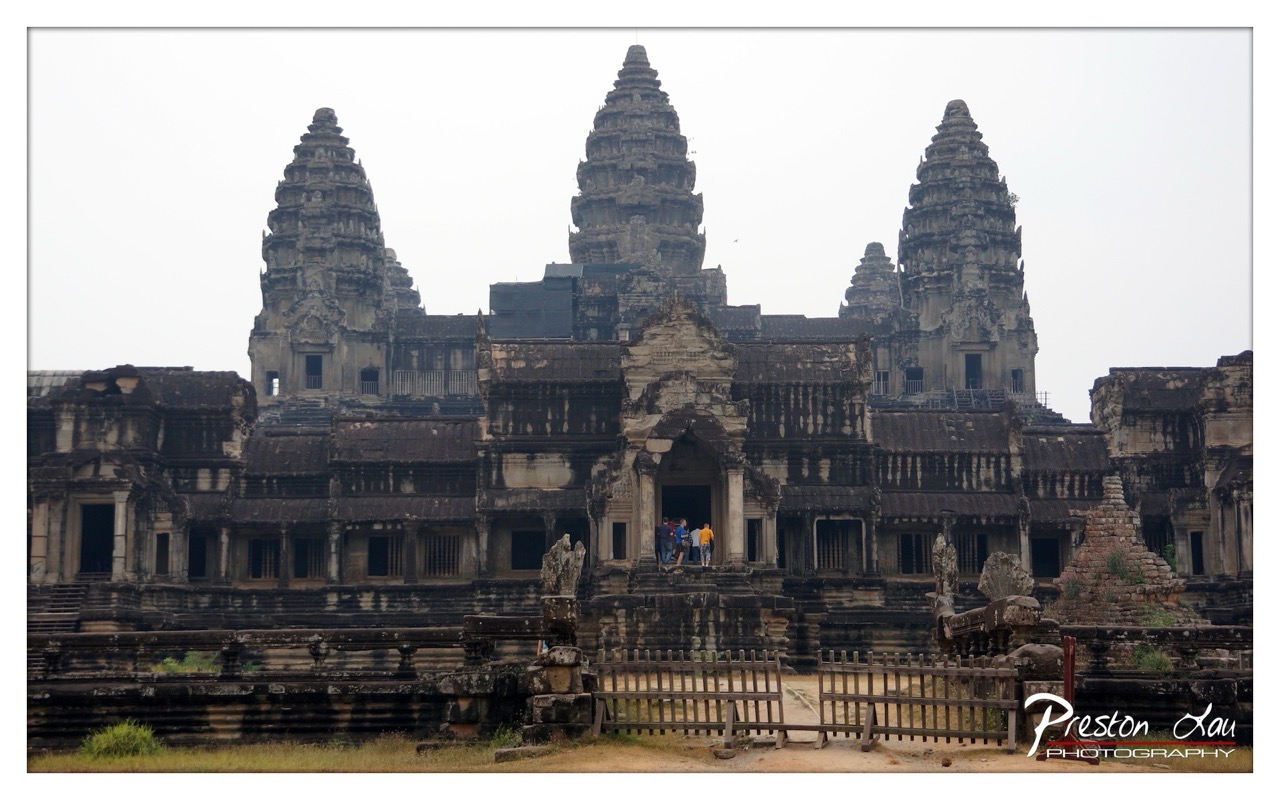

1. Overall Rating (0–10) — 7.0
This photograph captures the majestic presence of Angkor Wat under an overcast sky, conveying both its ancient grandeur and enduring mystery. The composition frames the temple with a sense of reverence, allowing the intricate stonework and towering spires to dominate the scene. While the muted lighting softens the dramatic potential of the architecture, the image succeeds in evoking a contemplative mood, inviting the viewer to reflect on the passage of time and cultural legacy.
2. Composition (0–10) — 7.5
The central placement of the temple’s main facade creates a strong focal point, with the wooden gate and steps guiding the eye upward. The inclusion of tourists adds scale and human context, enhancing the sense of awe. However, the slightly wide framing leaves some visual weight on the sides, which could be tightened for greater impact.
3. Lighting (0–10) — 5.5
The diffuse, overcast light flattens the textures of the stone, reducing contrast and depth. While it prevents harsh shadows and allows for even exposure, the lack of directional light diminishes the dramatic interplay of light and shadow that could have emphasized the temple’s intricate carvings.
4. Color & Tone (0–10) — 6.0
The palette is dominated by muted grays and earthy tones, reflecting the aged stone and cloudy sky. While cohesive, the lack of vibrancy gives the image a somber, almost melancholic quality. A touch of warmer tone or subtle color grading could have added visual warmth and emotional resonance.
5. Creativity (0–10) — 7.0
The photograph takes a straightforward, documentary approach, but its strength lies in capturing the temple’s spiritual and historical weight. The framing and inclusion of visitors introduce a narrative layer, suggesting the ongoing relevance of this ancient site in the present day.
6. Technical Quality (0–10) — 8.0
The image is sharp and clear, with good detail visible in the architectural elements. The focus is consistent across the temple complex, and the exposure is well-balanced despite the challenging lighting conditions.
7. Emotional Impact (0–10) — 7.5
The image evokes a sense of reverence and quiet wonder, drawing the viewer into a moment of stillness before a monument of immense historical significance. The subdued atmosphere, though not overtly dramatic, resonates with a contemplative solemnity that lingers.
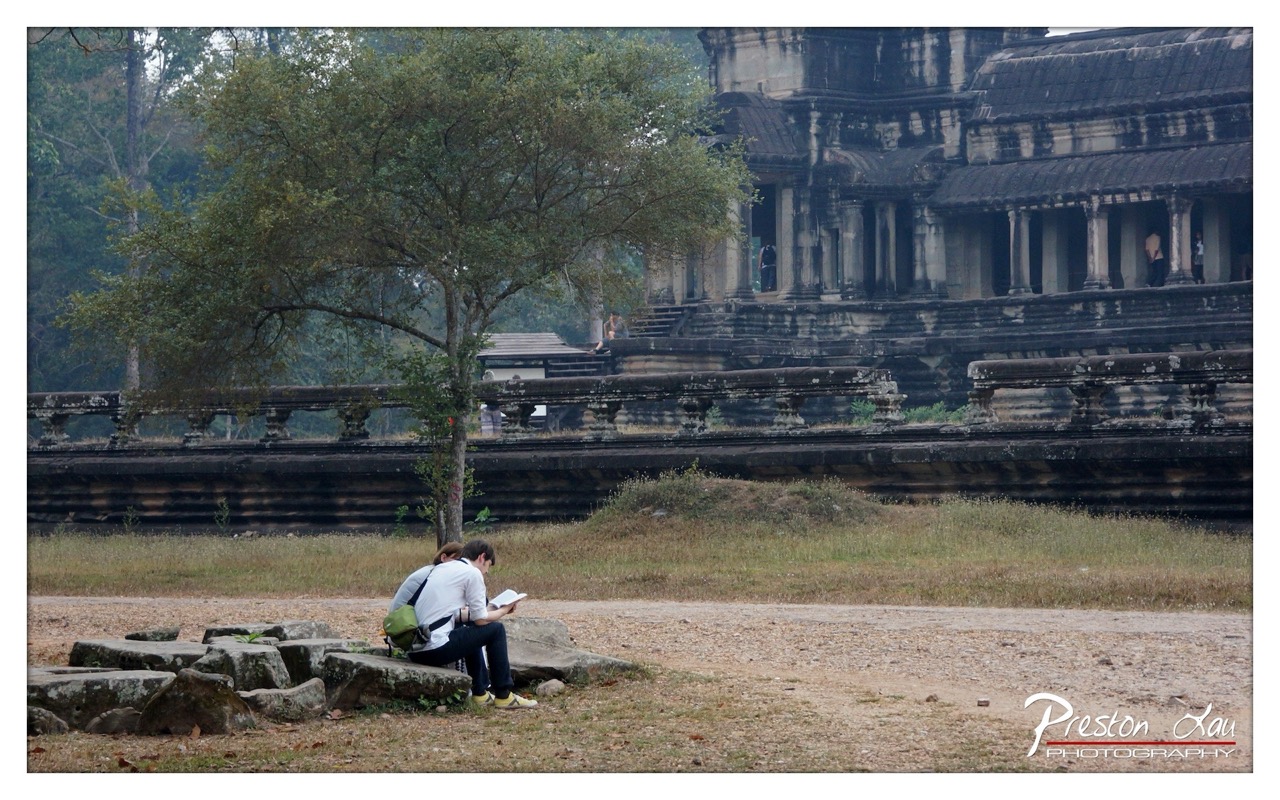

1. Overall Rating (0–10) — 7.0
This photograph captures a quiet, contemplative moment set against the grandeur of an ancient temple, where modern stillness contrasts with historical weight. The composition draws the viewer into a personal narrative, balancing human scale with monumental architecture. While the muted atmosphere and subdued colors lend a reflective mood, the image could benefit from stronger tonal contrast to elevate its visual impact.
2. Composition (0–10) — 7.0
The subjects are placed off-center, creating a natural visual flow toward the temple, while the tree in the mid-ground adds depth and frames the scene. The layered elements—foreground rocks, seated figures, and the temple in the background—establish a balanced and coherent spatial structure.
3. Lighting (0–10) — 6.0
Soft, diffused light suggests an overcast day, which flattens shadows and reduces contrast. While this creates a calm, introspective mood, it also diminishes the texture of the stone and the vibrancy of the surrounding greenery.
4. Color & Tone (0–10) — 6.0
The palette is dominated by earthy tones—grays, muted greens, and browns—lending a subdued, naturalistic feel. The lack of vivid color enhances the contemplative tone, though a slightly warmer cast might have added emotional warmth.
5. Creativity (0–10) — 7.0
The juxtaposition of a quiet, personal moment against a vast historical backdrop is compelling. The photographer captures a narrative of travel and reflection, suggesting a deeper connection between the individual and the ancient site.
6. Technical Quality (0–10) — 7.5
The image is sharp and well-focused, with clean detail visible in both the foreground and background. The exposure is balanced, though the overall tone is slightly underexposed, affecting contrast and depth.
7. Emotional Impact (0–10) — 7.5
The photograph evokes a sense of peace and introspection, inviting the viewer to imagine the quiet thoughts of the reader. The human element, set within the grandeur of history, creates a poignant emotional resonance.
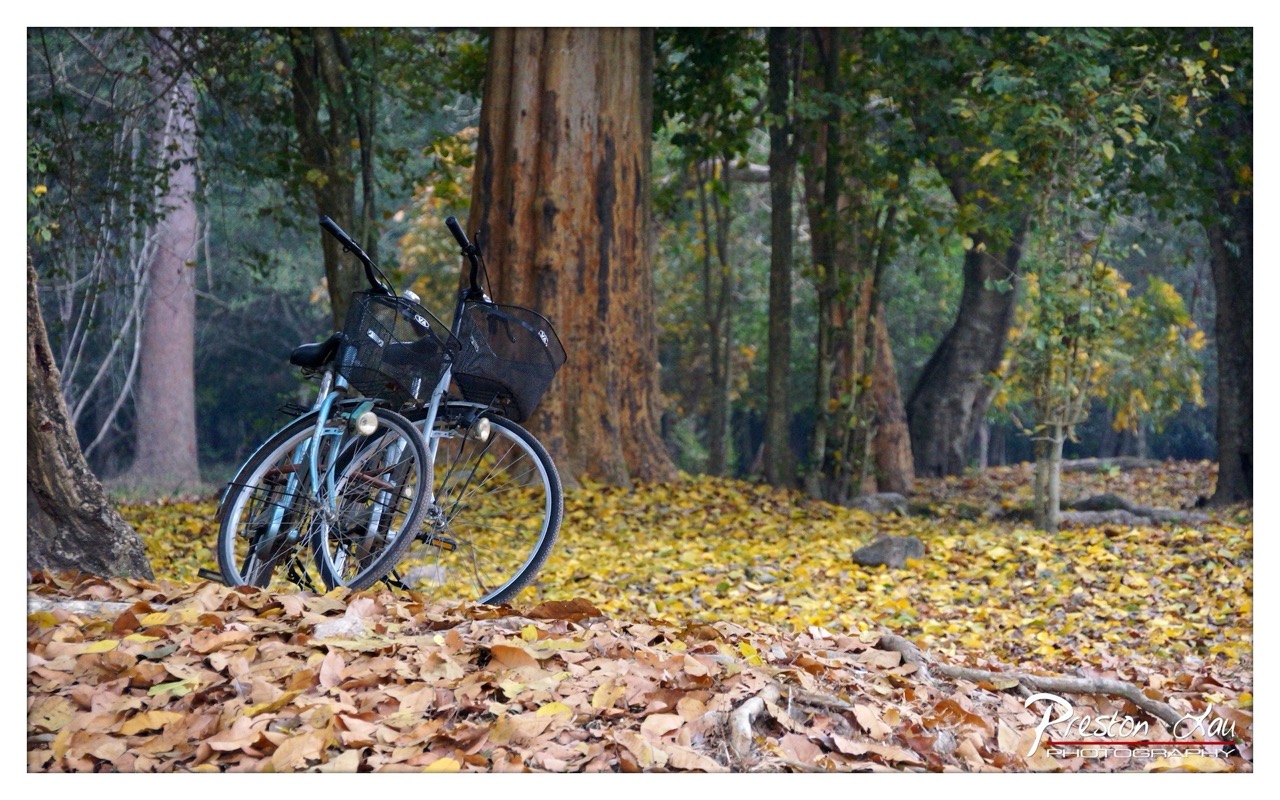

1. Overall Rating (0–10) — 7.0
This photograph captures a serene woodland moment, where two bicycles rest amid a carpet of golden leaves, evoking a sense of quiet pause in nature. The warm autumnal palette and soft focus on the background enhance the tranquil mood, though the composition feels slightly unbalanced by the off-center framing and cluttered foreground. While the image succeeds in conveying a contemplative atmosphere, it lacks the visual cohesion to feel fully resolved.
2. Composition (0–10) — 6.0
The bicycles are placed off-center, creating a slightly awkward imbalance. The foreground leaf pile draws the eye but also adds visual clutter, while the strong verticals of the trees provide structure, though they don’t fully anchor the subject.
3. Lighting (0–10) — 6.5
Diffused, overcast light creates even illumination with soft shadows, preserving detail in the leaves and bike frames. However, the lack of directional light reduces depth and texture, giving the scene a flat, muted quality.
4. Color & Tone (0–10) — 7.5
The warm yellows and browns of the fallen leaves contrast gently with the cooler tones of the bicycles and tree trunks, creating a harmonious autumn palette. The subtle saturation enhances the seasonal mood without appearing oversaturated.
5. Creativity (0–10) — 6.5
The juxtaposition of human-made bicycles in a natural setting offers a quiet narrative of travel and rest. While not particularly original, the image thoughtfully captures a fleeting moment of harmony between technology and nature.
6. Technical Quality (0–10) — 7.5
The focus is sharp on the bicycles, with clean detail in the foreground leaves. The depth of field is well-managed, and the image is free from noticeable noise or distortion.
7. Emotional Impact (0–10) — 7.0
The photograph evokes a sense of calm and nostalgia, inviting the viewer to imagine a peaceful bike ride paused in the quiet of the woods. The muted colors and stillness lend it a reflective, almost meditative quality.
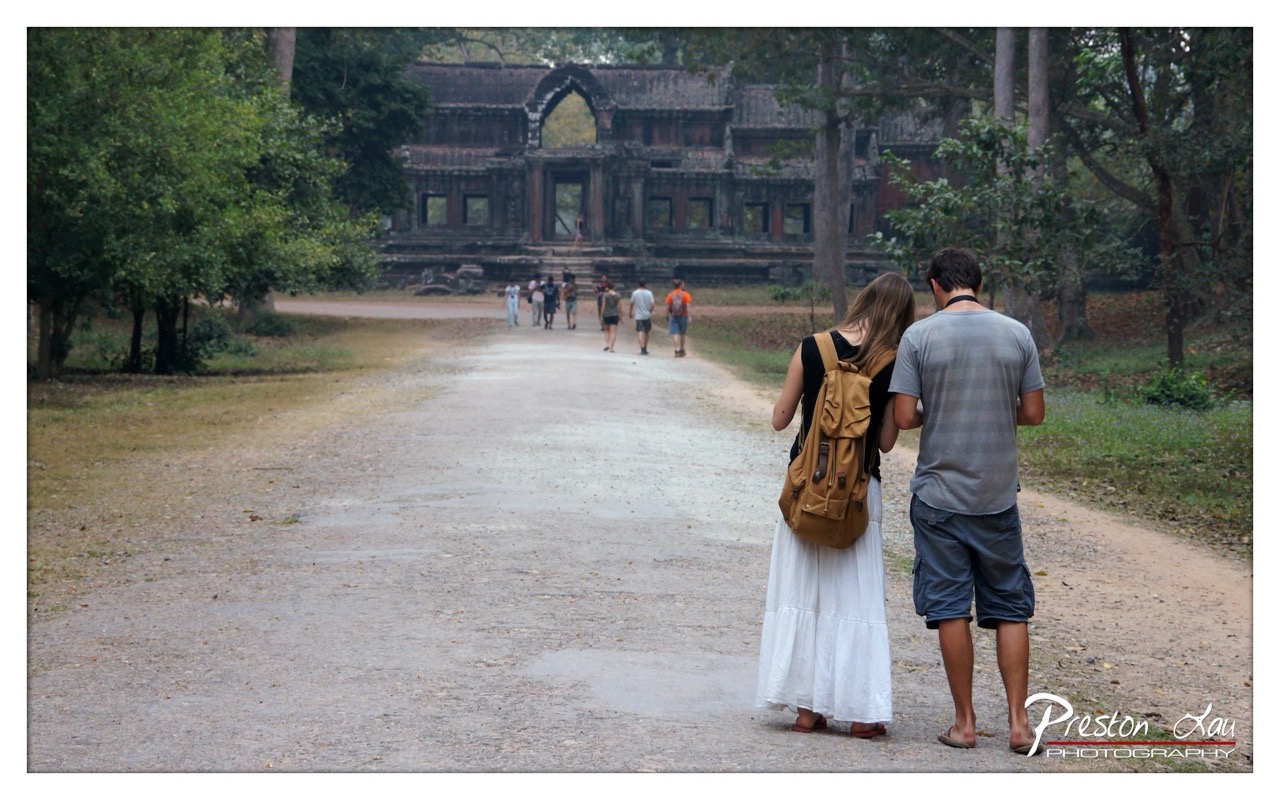

1. Overall Rating (0–10) — 7.0
This photograph captures a quiet moment of exploration at a historic temple site, where the scale of ancient architecture contrasts with the intimacy of human presence. The composition draws the eye along the path toward the temple, evoking a sense of journey and discovery. While the image is grounded in realism and narrative, it lacks the dramatic lighting and color richness that might elevate it into something more poetic or emotionally resonant.
2. Composition (0–10) — 7.5
The couple in the foreground anchors the image, creating a natural entry point, while the receding path and temple form strong leading lines. The placement of the couple slightly off-center adds balance, and the depth of field enhances the sense of distance and scale.
3. Lighting (0–10) — 6.0
Soft, diffused daylight evenly illuminates the scene, minimizing harsh shadows and allowing the textures of the temple and foliage to be visible. However, the overcast quality of the light lends a muted tone, slightly dampening the visual energy of the moment.
4. Color & Tone (0–10) — 6.5
The palette is subdued, dominated by earthy greens, grays, and browns, which suit the ancient, weathered setting. While harmonious, the colors lack vibrancy, giving the image a somewhat flat and documentary feel.
5. Creativity (0–10) — 7.0
The photograph tells a story of travel and awe, using the couple’s perspective to frame the temple as a destination. The inclusion of other visitors adds life and context, reinforcing the idea of shared cultural experience.
6. Technical Quality (0–10) — 8.0
Sharp focus across the frame, particularly on the couple and the temple, demonstrates solid technical execution. The image is clean, with no visible noise or blur, and the depth of field is well managed.
7. Emotional Impact (0–10) — 6.5
The image evokes a sense of wanderlust and reverence, but the emotional pull is moderate—more observational than deeply moving. The viewer is invited to imagine the journey, but the moment feels fleeting rather than profound.
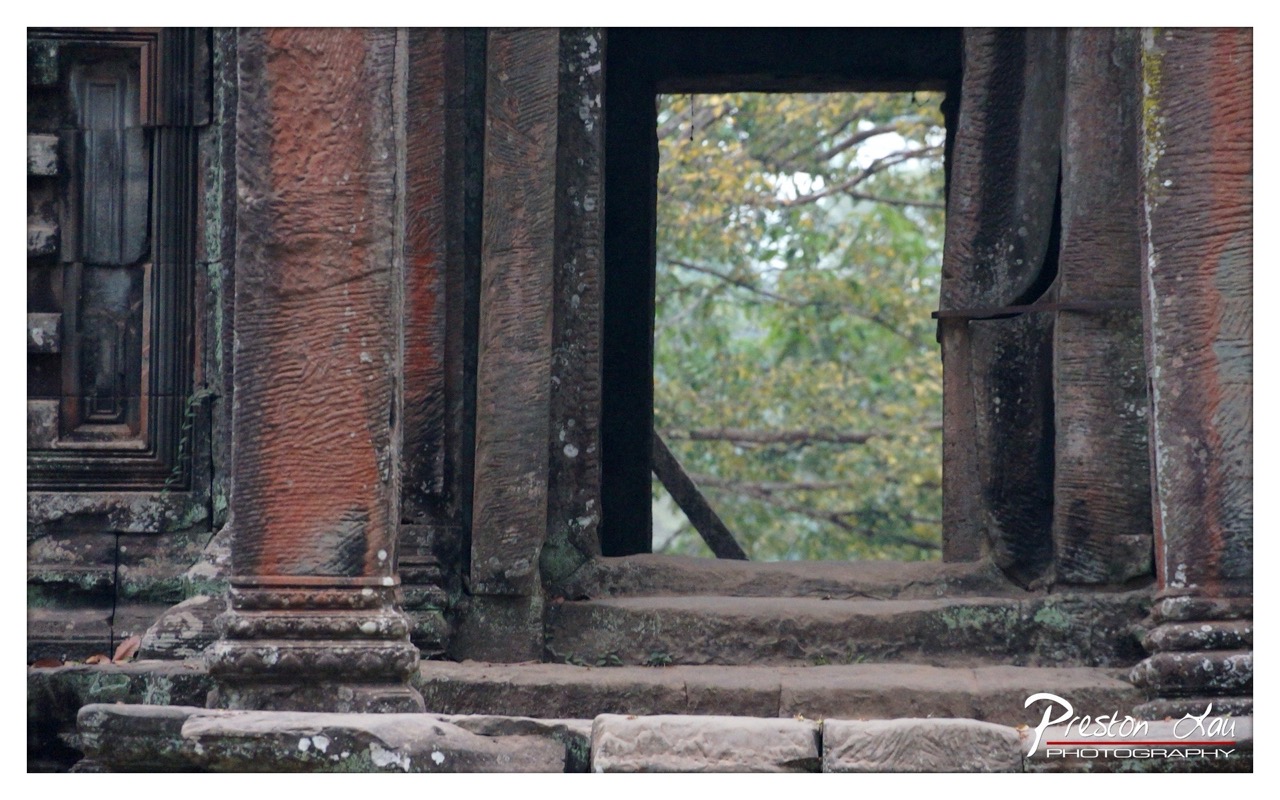

1. Overall Rating (0–10) — 7.0
This photograph captures the quiet dignity of ancient stone architecture, where time and nature have etched their stories into the weathered pillars and steps. The framing through the doorway creates a natural vignette, drawing the eye toward the lush greenery beyond and evoking a sense of passage—both temporal and physical. While the image is rich in texture and history, the muted lighting and slightly overcast atmosphere temper its emotional intensity, leaving it more contemplative than dramatic.
2. Composition (0–10) — 7.5
The doorway acts as a strong compositional anchor, creating a natural frame within the frame. The vertical lines of the pillars guide the eye toward the center, while the stone steps lead the viewer’s gaze into the scene. The slight asymmetry adds visual interest without disrupting balance.
3. Lighting (0–10) — 6.0
Diffused, overcast light softens the scene, minimizing harsh shadows and enhancing the texture of the stone. While this creates a somber mood appropriate for the ruins, it also flattens contrast and reduces the visual depth that might otherwise emphasize the passage of time.
4. Color & Tone (0–10) — 6.5
The palette is dominated by earthy tones—muted reds, browns, and grays—blended with the soft greens of the foliage. The tonal range is subdued, which supports the aged, melancholic atmosphere, though a touch more vibrancy could have made the natural backdrop feel more alive.
5. Creativity (0–10) — 7.0
The choice to frame the shot through the doorway adds a narrative dimension, suggesting discovery and mystery. The juxtaposition of man-made stone and encroaching nature enhances the theme of impermanence, offering a poetic reflection on time’s passage.
6. Technical Quality (0–10) — 8.0
The image is sharp and well-focused, with excellent detail in the stone textures and mossy surfaces. The exposure is balanced, and there is no noticeable noise, indicating strong technical execution.
7. Emotional Impact (0–10) — 6.5
The photograph evokes a quiet reverence and a sense of solitude, inviting contemplation of history and decay. While it doesn’t deliver an immediate emotional punch, its subtlety allows for a slow, reflective connection to the past.
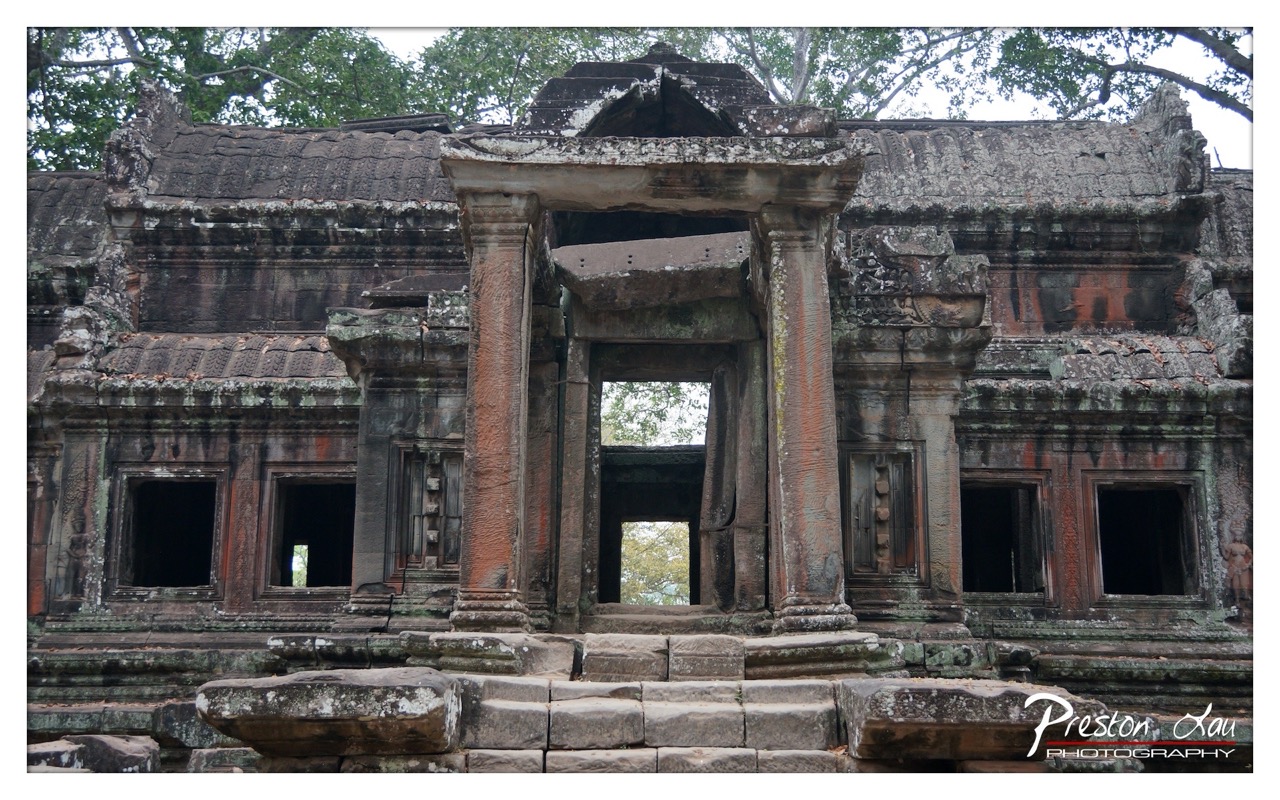

1. Overall Rating (0–10) — 7.5
This photograph captures the haunting grandeur of an ancient temple, where time and nature have woven a story into stone. The weathered textures and layered decay speak of centuries of endurance, while the framing draws the eye through the central archway, inviting contemplation of what lies beyond. While the composition is strong and the subject compelling, a slightly warmer tone and more dynamic lighting could deepen the emotional resonance.
2. Composition (0–10) — 8.0
The central doorway creates a strong focal point, framed by symmetrical columns and leading the viewer’s gaze into the depth of the structure. The layered steps and horizontal lines of the stone terrace add rhythm and balance, reinforcing the temple’s architectural harmony.
3. Lighting (0–10) — 6.5
Natural daylight illuminates the scene evenly, but the overcast sky casts a flat, cool light that softens the texture and depth of the stonework. A more directional light would enhance the contrast and highlight the intricate carvings.
4. Color & Tone (0–10) — 7.0
The palette of weathered stone—muted grays, ochre stains, and patches of green moss—evokes a sense of age and quiet decay. While rich in texture, the colors are slightly desaturated, which tempers the visual impact.
5. Creativity (0–10) — 7.5
The photographer captures the temple not as a mere landmark, but as a living ruin, with the interplay of architecture and nature suggesting a narrative of reclamation. The use of the arch as a visual conduit adds a layer of storytelling.
6. Technical Quality (0–10) — 8.5
Sharp focus across the frame preserves fine details in the stonework and carvings. The exposure is balanced, and the image is free of noticeable noise or artifacts, showcasing strong technical execution.
7. Emotional Impact (0–10) — 7.0
The image evokes a sense of reverence and melancholy, inviting the viewer to reflect on the passage of time and the impermanence of human achievement. The quiet stillness of the scene resonates deeply, even if the lighting keeps the emotion understated.
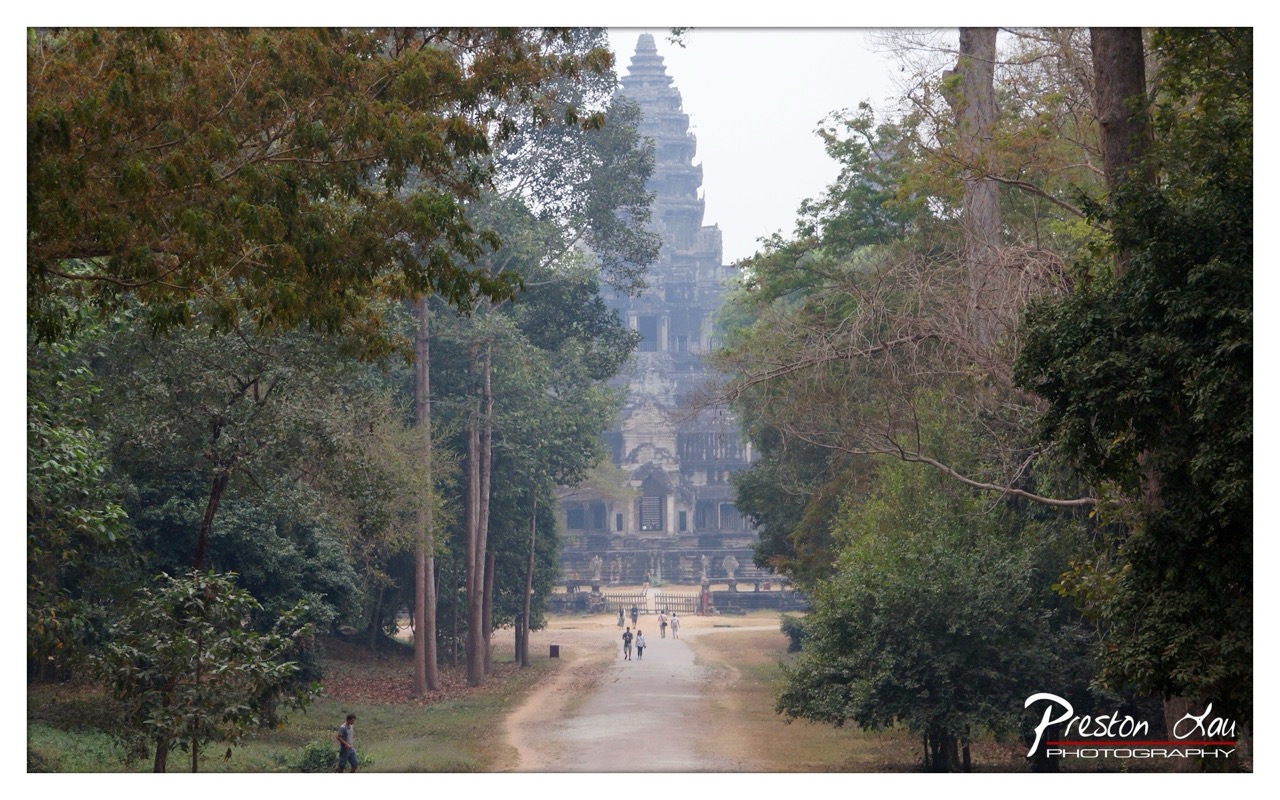

1. Overall Rating (0–10) — 7.0
This photograph captures the solemn grandeur of Angkor Wat’s central tower, framed by the encroaching jungle and a path that draws the eye toward its ancient silhouette. The mood is contemplative and slightly melancholic, enhanced by the overcast sky and muted light, which lend the scene a timeless, almost ghostly quality. While the image effectively conveys the scale and mystery of the temple, the slightly dull color palette and soft focus prevent it from achieving greater visual drama.
2. Composition (0–10) — 7.0
The path creates a strong leading line, guiding the viewer’s gaze toward the temple and establishing a sense of depth. The framing by trees on both sides adds a natural arch, enhancing the sense of discovery. However, the placement of the temple slightly off-center and the presence of small figures at the bottom left create a subtle imbalance, though the composition remains harmonious overall.
3. Lighting (0–10) — 5.5
The diffuse, overcast light softens shadows and flattens contrast, creating a muted atmosphere appropriate for the mood but lacking in dynamic range. While this contributes to the scene’s somber tone, it also reduces the texture and detail of the temple’s stonework.
4. Color & Tone (0–10) — 6.0
The palette is dominated by soft greens and grays, creating a cohesive but subdued look. The lack of vibrant tones lends a naturalistic feel, but the overall tone is slightly desaturated, diminishing the visual impact of the temple’s intricate carvings.
5. Creativity (0–10) — 6.5
The image offers a familiar subject with a thoughtful perspective, emphasizing the integration of architecture and nature. The framing through the trees adds narrative depth, suggesting a journey into the past. While not radically original, the approach feels intentional and evocative.
6. Technical Quality (0–10) — 7.5
The focus is sharp on the temple and path, and the image is free from technical flaws such as noise or blur. The depth of field is appropriate, with the foreground and background both reasonably clear, though the distant details of the temple remain slightly soft.
7. Emotional Impact (0–10) — 7.0
There is a quiet sense of reverence and wonder, evoked by the scale of the temple and the way it emerges from the forest. The presence of small human figures emphasizes the monument’s enormity and the passage of time, creating a subtle emotional resonance with the viewer.
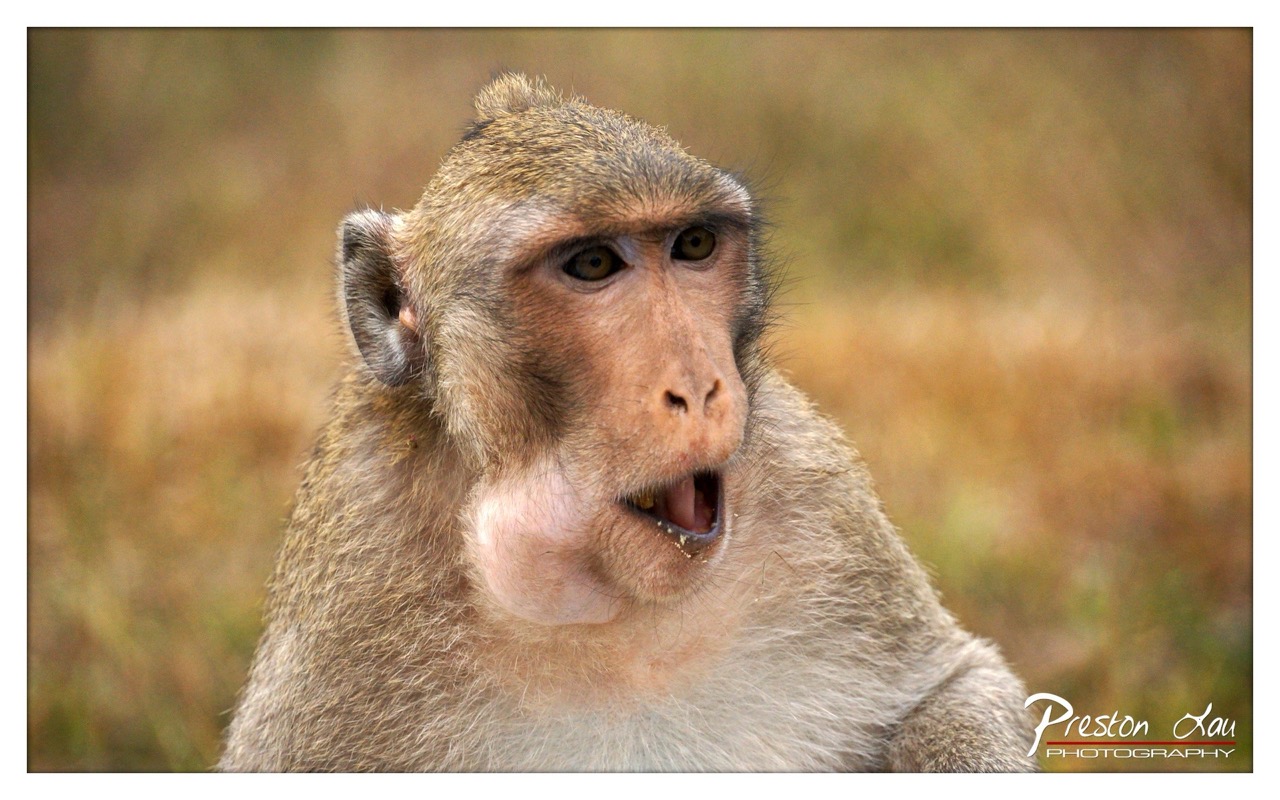

1. Overall Rating (0–10) — 7.5
This portrait of a macaque captures a moment of raw, unfiltered expression, where the subject’s wide eyes and open mouth suggest alarm or vocalization. The shallow depth of field isolates the monkey against a softly blurred natural backdrop, creating a compelling focal point. While the image is visually arresting and emotionally charged, the tight framing and slightly awkward angle limit its broader aesthetic harmony.
2. Composition (0–10) — 7.0
The subject is well-centered, with the monkey’s face occupying the focal plane, drawing immediate attention. However, the tight crop and slight tilt in the frame create a sense of imbalance, subtly undermining the image’s visual stability.
3. Lighting (0–10) — 7.5
Natural, diffused light illuminates the subject evenly, highlighting the texture of the fur and the subtle details around the eyes and mouth. The soft lighting enhances the intimate, candid mood without creating harsh shadows.
4. Color & Tone (0–10) — 7.0
The warm, earthy tones of the fur and background blend harmoniously, creating a natural palette that evokes the monkey’s habitat. The color contrast between the lighter face and darker fur adds depth, though the overall tone leans slightly muted.
5. Creativity (0–10) — 8.0
The photographer captures a rare, expressive moment that transcends mere documentation. The choice to focus on the monkey’s emotional state—perhaps surprise or communication—adds narrative depth and elevates the image beyond a standard wildlife portrait.
6. Technical Quality (0–10) — 8.5
Sharp focus on the monkey’s face ensures crisp detail, particularly in the eyes and facial features. The background blur is smooth and well-managed, demonstrating strong lens and aperture control.
7. Emotional Impact (0–10) — 8.5
The monkey’s expression conveys a powerful sense of immediacy and vulnerability, inviting the viewer to speculate on its thoughts or intentions. This emotional resonance makes the image memorable and thought-provoking.
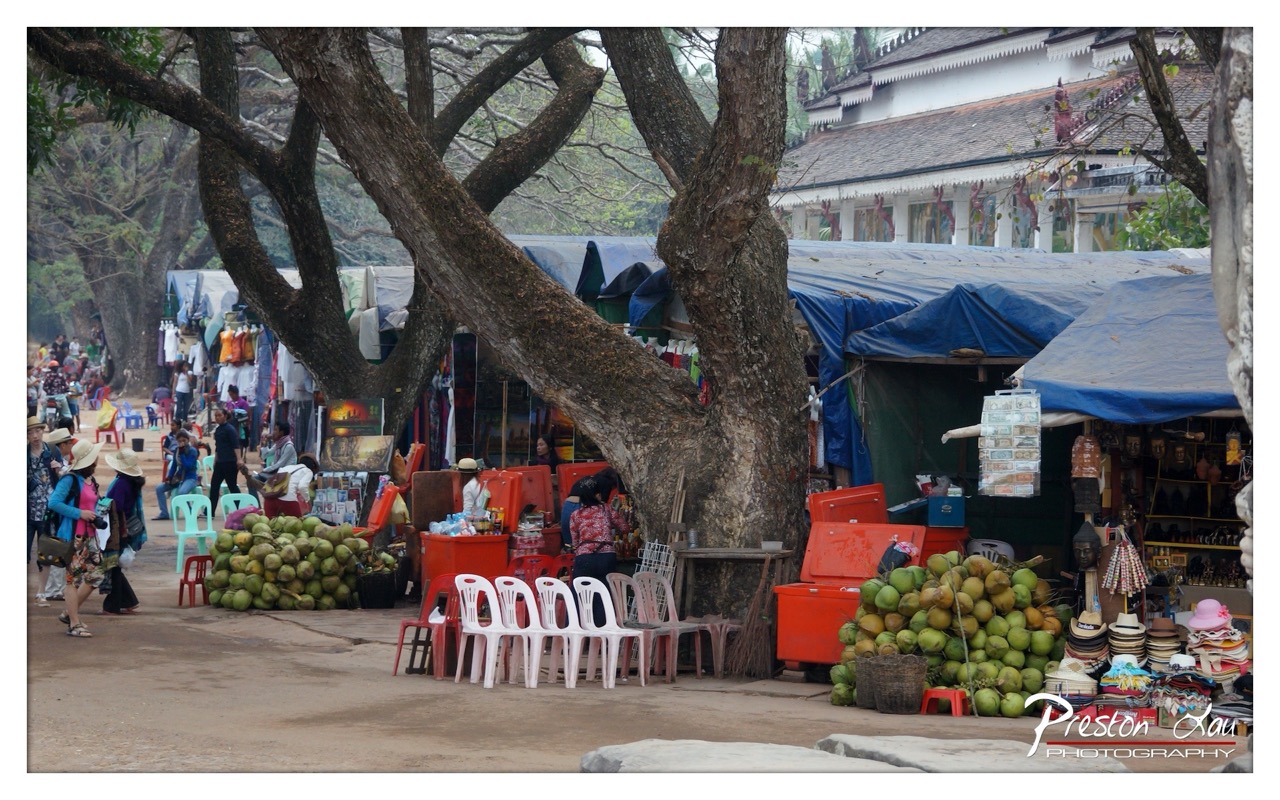

1. Overall Rating (0–10) — 7.0
This photograph captures the vibrant, bustling energy of a street market under the shelter of a sprawling tree, where daily commerce blends seamlessly with cultural life. The scene is rich with detail—coconuts stacked like treasure, colorful stalls, and people moving with purpose—evoking a sense of authenticity and place. While the image is compelling and full of narrative potential, its composition and lighting prevent it from achieving a more polished, emotionally resonant impact.
2. Composition (0–10) — 6.0
The large tree trunk dominates the center, creating a natural frame but also obstructing the view and disrupting visual flow. The placement of stalls and people feels scattered, and the depth of field is uneven, leading the eye to jump between foreground and background without a clear focal point.
3. Lighting (0–10) — 5.5
The light is flat and diffused, likely from an overcast sky, which softens shadows but also drains vibrancy from the scene. While it allows for even exposure, the lack of directional light prevents the image from having dynamic contrast or mood.
4. Color & Tone (0–10) — 6.5
The color palette is varied, with pops of red, blue, and green from the stalls and produce, but the overall tone is muted. The green coconuts and blue tarps provide visual interest, yet the lack of saturation keeps the image from feeling vivid or engaging.
5. Creativity (0–10) — 7.0
The photograph successfully documents a lively cultural moment with a sense of realism. The use of the tree as a compositional anchor adds a natural, organic element, and the inclusion of people and everyday objects creates a layered, storytelling quality.
6. Technical Quality (0–10) — 7.5
The image is sharp and clear, with good detail in the foreground and midground. The focus is consistent, and the exposure is well-balanced, allowing for visible texture in the tree bark, plastic chairs, and coconuts.
7. Emotional Impact (0–10) — 6.5
The image conveys a sense of community and everyday life, inviting the viewer to imagine the sounds and smells of the market. However, the lack of strong lighting and composition keeps the emotional connection from feeling deeply personal or immersive.
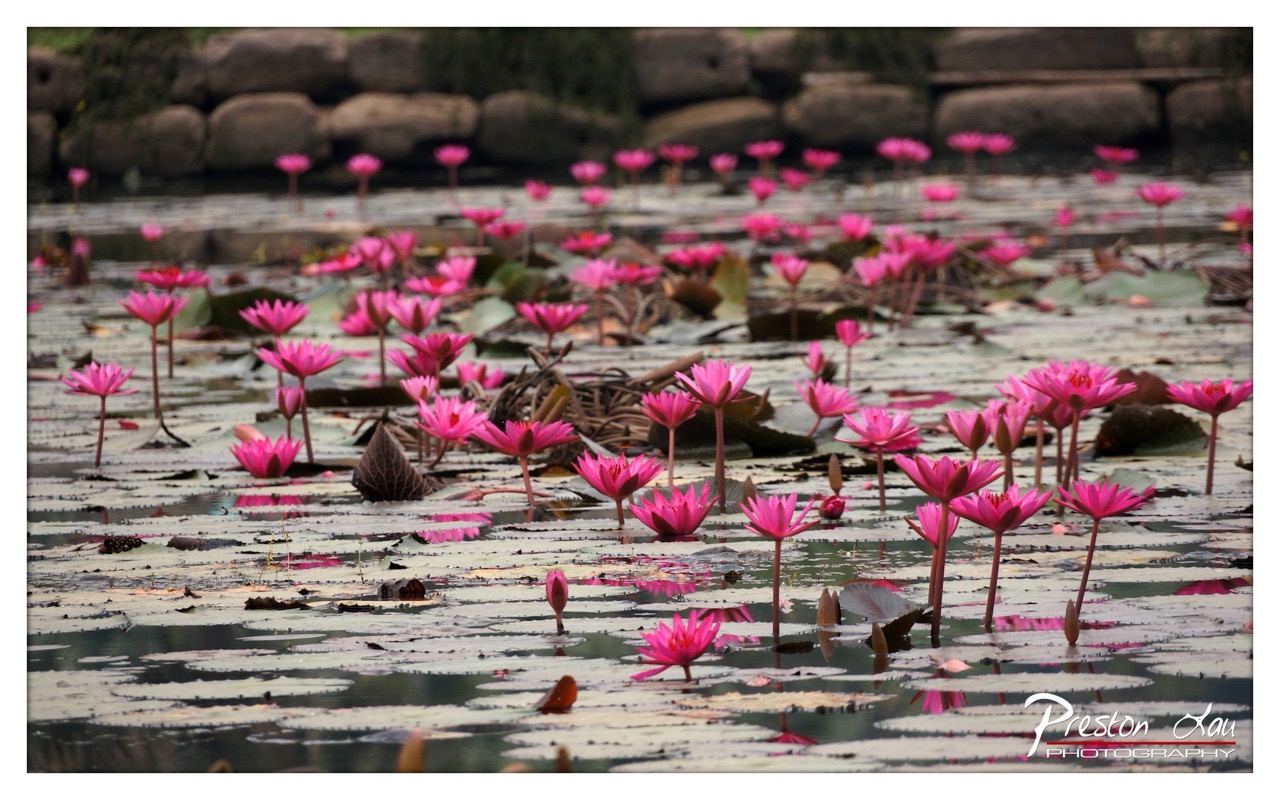

1. Overall Rating (0–10) — 7.5
This photograph captures the serene beauty of a pond teeming with vibrant pink water lilies, their delicate forms rising above a mosaic of lily pads and rippling water. The rich magenta blooms contrast beautifully with the muted greens and grays of the surrounding environment, creating a visually engaging scene that feels both natural and dreamlike. While the image succeeds in conveying a sense of tranquility and abundance, the slightly soft focus and overcast lighting keep it from reaching its full atmospheric potential.
2. Composition (0–10) — 7.0
The flowers are distributed across the frame with a natural, scattered arrangement that guides the eye through the scene. The diagonal lines formed by the stems and the placement of the larger lily pads create subtle movement, though the central cluster of blooms slightly overpowers the composition, drawing attention too heavily to one area.
3. Lighting (0–10) — 6.0
The soft, diffused light suggests an overcast day, which evenly illuminates the scene but reduces contrast and depth. While this prevents harsh shadows, it also gives the image a somewhat flat quality, muting the vibrancy of the pink blossoms.
4. Color & Tone (0–10) — 8.0
The vivid pink of the water lilies stands out strikingly against the subdued greens, grays, and silvery reflections on the water. The color palette is harmonious and natural, with the magenta tones lending a sense of life and energy to the scene.
5. Creativity (0–10) — 7.5
The photographer captures a familiar subject—water lilies—with a fresh and contemplative eye. The inclusion of fallen petals and the subtle inclusion of the photographer’s signature in the corner lend the image a personal, almost poetic quality, suggesting a quiet moment of observation.
6. Technical Quality (0–10) — 7.5
The image is sharp enough to reveal fine details in the petals and lily pads, and the focus is well-placed on the foreground blooms. However, there is a slight softness across the frame, possibly due to lens choice or atmospheric haze, which slightly diminishes overall clarity.
7. Emotional Impact (0–10) — 8.0
The scene evokes a sense of peace and quiet wonder, inviting the viewer to pause and reflect on the delicate beauty of nature. The repetition of the blossoms creates a meditative rhythm, and the soft focus enhances the dreamlike quality, making the image emotionally resonant and memorable.
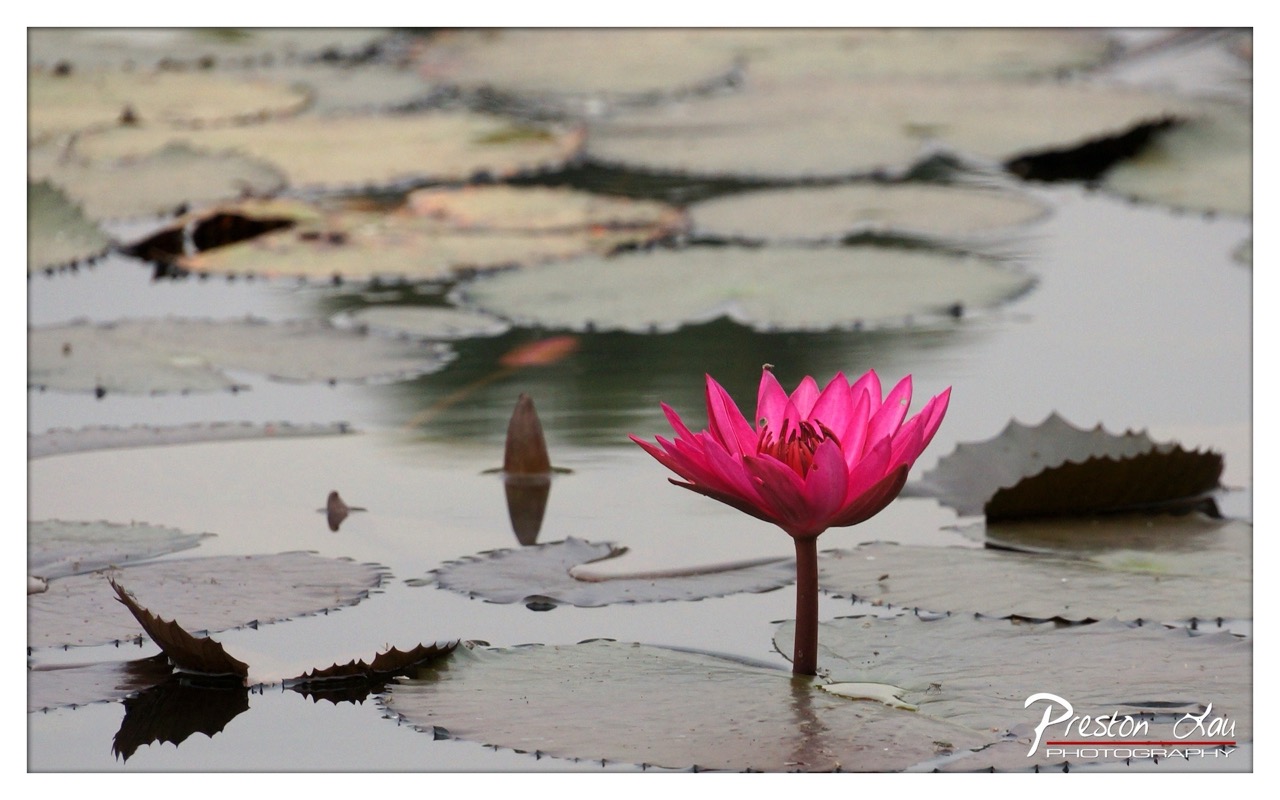

1. Overall Rating (0–10) — 7.0
This photograph captures a serene and contemplative moment in a tranquil pond, where the vibrant pink lotus stands as a striking focal point amid muted natural tones. The soft focus in the background enhances the flower’s delicate beauty, while the still water and scattered lily pads create a sense of quiet harmony. While the image is visually pleasing, it holds back slightly from emotional depth due to a lack of dramatic lighting or dynamic composition.
2. Composition (0–10) — 7.0
The lotus is positioned slightly off-center, following the rule of thirds, which creates a balanced and natural feel. The scattered lily pads and reflections add depth and texture, while the blurred background effectively isolates the subject. A tighter crop could further emphasize the flower’s elegance, but the current framing allows the environment to breathe.
3. Lighting (0–10) — 6.0
The lighting is soft and diffused, likely from an overcast sky, which minimizes harsh shadows and lends a gentle mood to the scene. While this contributes to the calm atmosphere, it also reduces contrast and depth, making the image feel somewhat flat and lacking in dimension.
4. Color & Tone (0–10) — 7.0
The vivid pink of the lotus creates a strong contrast against the muted greens and grays of the pond, drawing the eye immediately. The color palette is cohesive and natural, with subtle tonal variations in the water and leaves adding visual interest. The overall tone is tranquil, though slightly desaturated, which slightly diminishes the vibrancy.
5. Creativity (0–10) — 6.5
The image is a thoughtful interpretation of a classic natural subject—lotus in a pond—offering a peaceful, meditative quality. While not particularly original in concept, the photographer’s choice to emphasize the flower’s isolation and the reflective stillness of the water adds a layer of quiet contemplation.
6. Technical Quality (0–10) — 8.0
The focus is sharp on the lotus, and the depth of field is well-controlled, with the background softly blurred. The image is clean, with no visible noise or artifacts, and the watermark is subtle and unobtrusive. The technical execution is solid and professional.
7. Emotional Impact (0–10) — 6.5
The photograph evokes a sense of peace and stillness, inviting quiet reflection. The solitary lotus, rising above the water, can symbolize resilience and purity, resonating emotionally with viewers familiar with its cultural significance. However, the subdued lighting and lack of dynamic contrast limit the emotional punch, keeping the experience more subdued than profound.
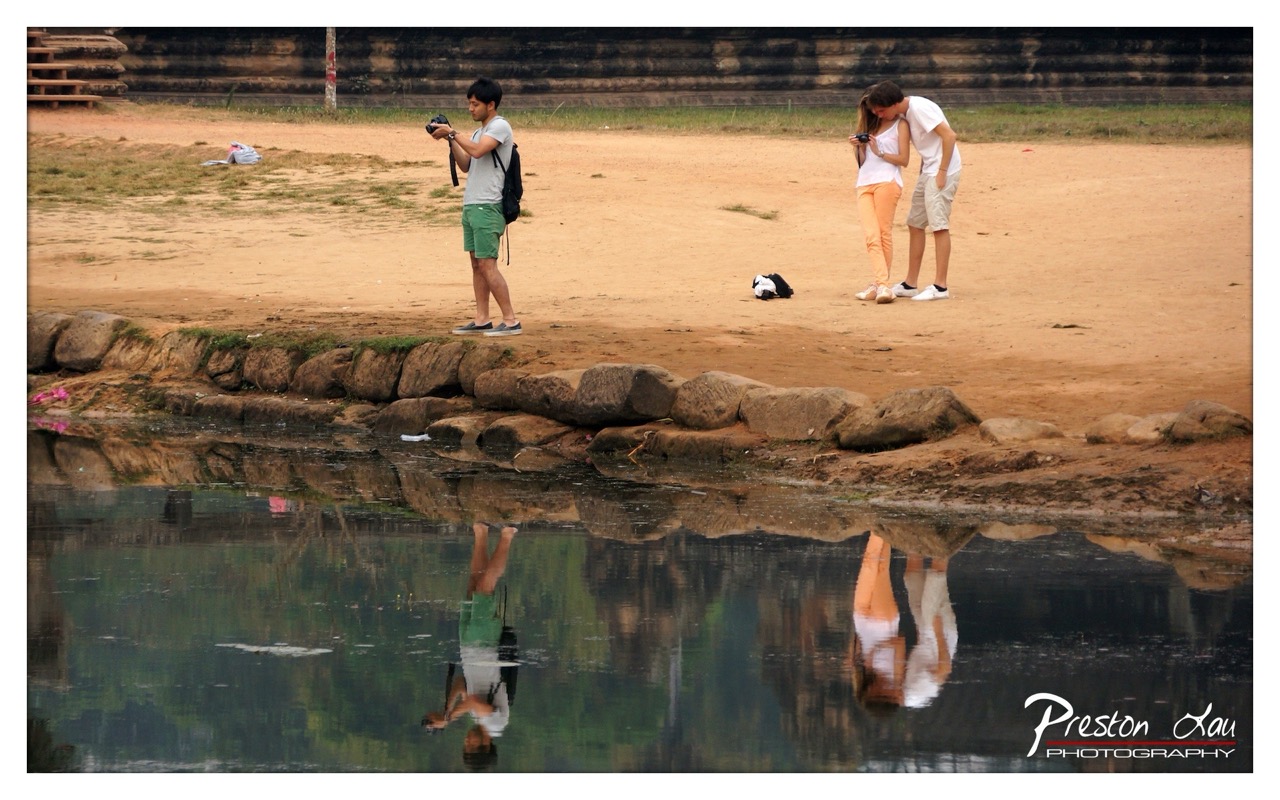

1. Overall Rating (0–10) — 7.0
This photograph captures a quiet, candid moment of two tourists exploring a historic site, their reflections adding a layer of poetic symmetry. The interplay between the real and the mirrored worlds creates a dreamlike stillness, while the weathered stone and earthy tones lend a sense of timelessness. Though the composition is strong, the slightly cluttered background and soft focus detract from the image’s overall clarity and impact.
2. Composition (0–10) — 7.5
The diagonal line of rocks and the reflective surface create a natural division, guiding the eye across the frame. The placement of the figures balances the composition, with the man on the left and the couple on the right creating visual equilibrium.
3. Lighting (0–10) — 6.5
The soft, diffused light enhances the reflective quality of the water and gives the scene a calm, overcast mood. While the lighting is even, it lacks dramatic contrast, which slightly diminishes the visual depth.
4. Color & Tone (0–10) — 7.0
The warm earth tones of the sand and stone contrast subtly with the cool, dark reflections in the water, creating a balanced palette. The colors are natural and cohesive, with a slight warmth that enhances the tranquil atmosphere.
5. Creativity (0–10) — 8.0
The use of reflection as a compositional element is both clever and evocative, doubling the narrative and adding a layer of introspection. The juxtaposition of modern visitors against ancient ruins suggests a dialogue between past and present.
6. Technical Quality (0–10) — 7.5
The image is sharp and well-focused, particularly in the foreground, with clean detail in the reflections. The exposure is balanced, though the shadows are slightly underexposed, losing some detail in the water.
7. Emotional Impact (0–10) — 7.0
The image evokes a sense of contemplation and quiet discovery, inviting the viewer to reflect on the passage of time and the human connection to history. The intimacy of the couple’s moment adds emotional warmth, though the overall mood remains somewhat detached.
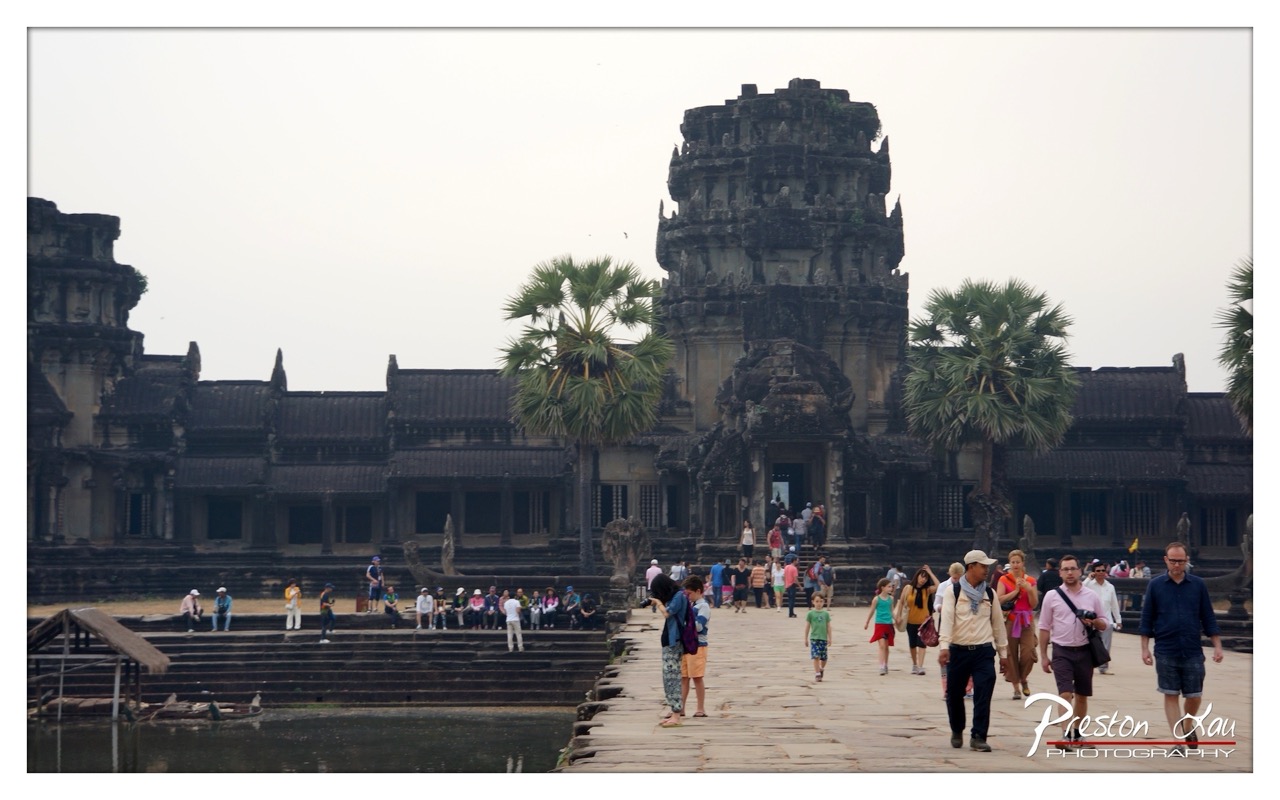

1. Overall Rating (0–10) — 6.0
This photograph captures the grandeur of Angkor Wat with a sense of scale and human presence, but the overcast sky and muted tones temper its visual impact. While the composition effectively frames the temple’s architecture and the flow of visitors, the lack of dramatic lighting and color depth keeps the image from feeling truly immersive. It succeeds as a documentary record but falls short of evoking the awe one might expect from such a historic site.
2. Composition (0–10) — 6.5
The wide-angle perspective includes both the temple’s intricate stonework and the bustling crowd, creating a sense of place. The diagonal path draws the eye into the frame, and the placement of the palm trees adds natural balance, though the scene feels slightly cluttered due to the number of people.
3. Lighting (0–10) — 5.0
The overcast sky casts a flat, diffused light across the scene, softening details and reducing contrast. While this prevents harsh shadows, it also diminishes the texture and depth of the ancient stone, giving the image a washed-out quality.
4. Color & Tone (0–10) — 5.5
The palette is dominated by muted grays and earthy tones, with only faint hints of color from the tourists’ clothing. The lack of vibrancy dampens the visual energy, and the overall tone feels subdued and somewhat lifeless.
5. Creativity (0–10) — 6.0
The image is straightforward and observational, capturing a moment of cultural tourism rather than expressing a personal vision. The inclusion of people adds narrative, but the approach is conventional rather than inventive.
6. Technical Quality (0–10) — 7.0
The focus is sharp across the frame, and the details of the temple and people are clearly rendered. The exposure is balanced, though the lack of dynamic range limits the image’s visual depth.
7. Emotional Impact (0–10) — 5.5
While the scene conveys the scale and enduring presence of Angkor Wat, the flat lighting and crowded atmosphere create a sense of detachment. The emotional resonance is muted, as the viewer is reminded more of tourism than of spiritual or historical reverence.
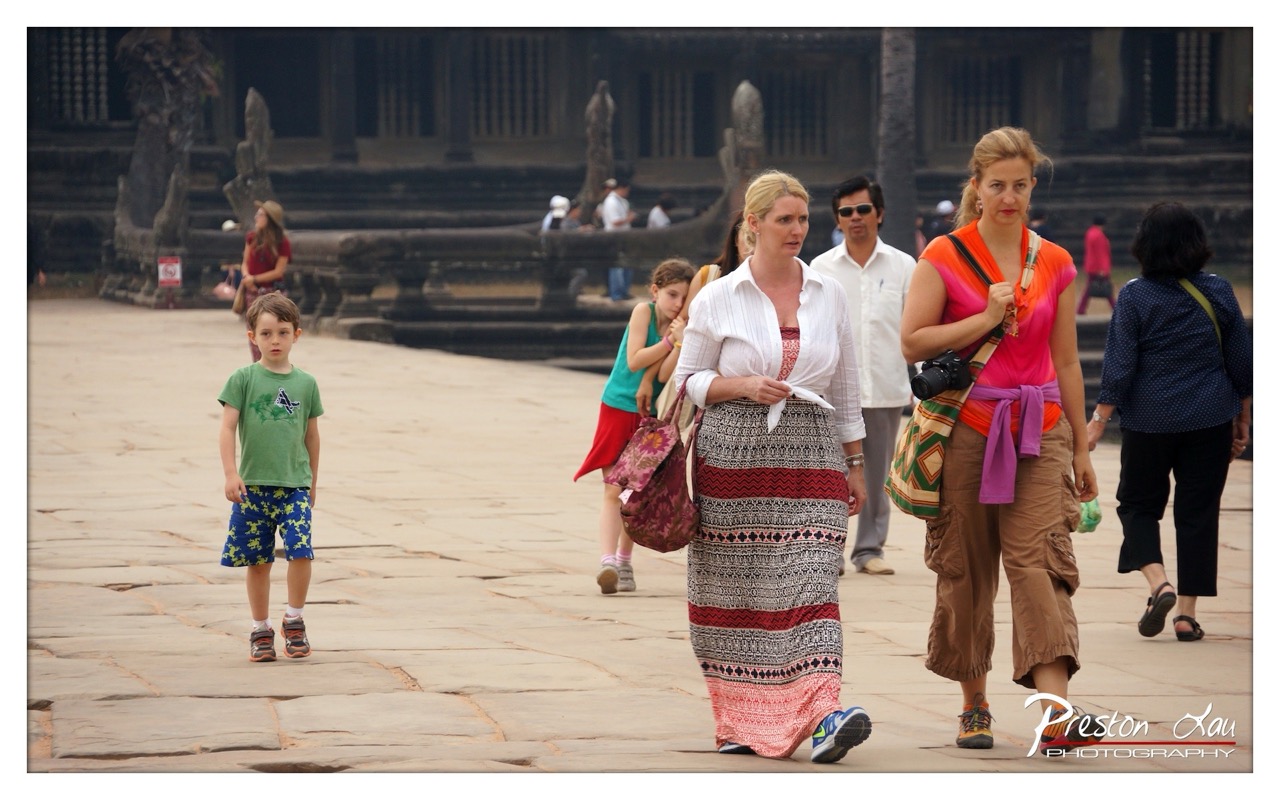

1. Overall Rating (0–10) — 6.8
This photograph captures a candid moment of travelers exploring a historic temple complex, blending cultural context with everyday human movement. The contrast between the ancient stone architecture and the modern attire of the visitors creates a compelling narrative of time and place. While the image successfully documents a slice of life, its emotional resonance is slightly muted by the lack of a strong focal point and a somewhat cluttered background.
2. Composition (0–10) — 6.0
The framing includes multiple subjects across the frame, creating a sense of movement and depth, but the lack of a clear focal point diffuses attention. The boy on the left stands out due to his isolated positioning, yet the central figures are slightly off-center, disrupting visual balance.
3. Lighting (0–10) — 6.5
Natural daylight provides even illumination across the scene, though the overcast sky softens shadows and reduces contrast. The light is functional but lacks drama, giving the image a neutral, documentary feel.
4. Color & Tone (0–10) — 6.2
The palette is dominated by earthy tones of stone and muted clothing, punctuated by the bright green shirt and colorful skirt. While the colors are varied, they lack vibrancy, resulting in a somewhat flat and unengaging tonal range.
5. Creativity (0–10) — 6.5
The image succeeds in capturing a candid, travel-based moment, but the storytelling is observational rather than expressive. The juxtaposition of tourists and ancient ruins offers narrative potential, but the execution remains straightforward without a strong artistic vision.
6. Technical Quality (0–10) — 7.5
The photograph is sharp and well-focused, with clear detail in the foreground subjects. The depth of field is adequate, allowing both the people and the temple in the background to remain visible, though slightly soft.
7. Emotional Impact (0–10) — 6.0
The image evokes a sense of quiet exploration and cultural curiosity, but the emotional connection is limited by the lack of a dominant subject or moment. The viewer is invited to observe rather than feel, resulting in a mild sense of engagement.
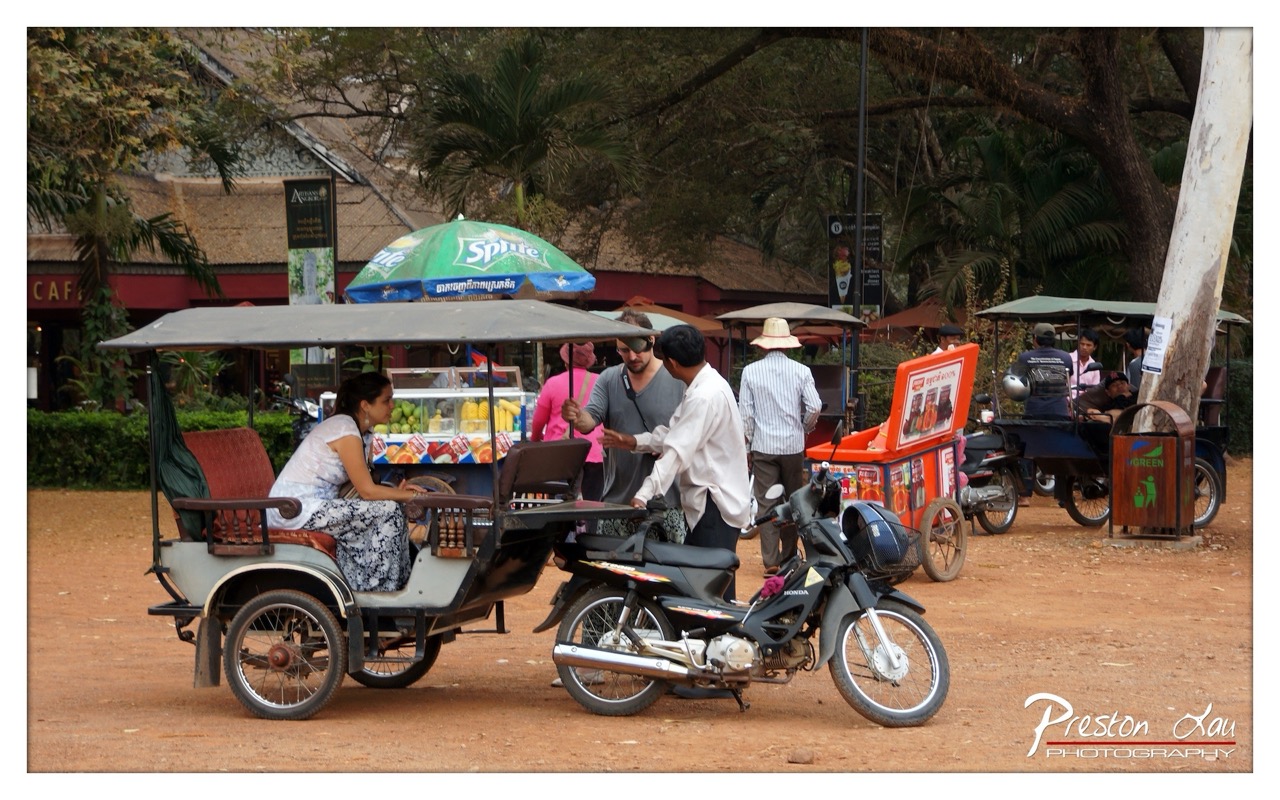

1. Overall Rating (0–10) — 6.8
This photograph captures a vibrant street scene in a tropical locale, blending local life with tourist interaction in a candid, documentary style. The composition is rich with cultural detail—tuk-tuks, street vendors, and casual exchanges—all suggesting a moment of everyday commerce. While the image is visually engaging and full of narrative potential, the slightly cluttered arrangement and flat lighting hold it back from greater artistic impact. The authenticity of the moment is compelling, but the image feels more like a snapshot than a fully realized photograph.
2. Composition (0–10) — 6.5
The frame is filled with multiple subjects and elements, creating a sense of bustling activity. The tuk-tuk and motorcycle in the foreground draw the eye, while the vendor and figures in the midground add depth. However, the placement of the motorcycle slightly disrupts the flow, and the composition feels somewhat crowded, with the tree trunk on the right cutting into the scene.
3. Lighting (0–10) — 6.0
The lighting is natural and even, suggesting midday sunlight, but it lacks direction and depth. The flat, bright quality washes out some details and fails to create strong shadows or mood. While the exposure is generally correct, the lack of contrast diminishes the visual drama.
4. Color & Tone (0–10) — 6.8
The palette is rich with earthy tones—browns, greens, and muted reds—that reflect the tropical setting. The green Sprite umbrella adds a pop of color and serves as a visual anchor. The overall tone is warm and natural, though the saturation is moderate, giving the image a slightly subdued feel.
5. Creativity (0–10) — 7.0
The photograph successfully captures a slice of everyday life with a sense of place and cultural authenticity. The inclusion of tourists interacting with locals adds a layer of narrative, suggesting cross-cultural exchange. While not highly stylized, the image conveys a strong sense of environment and context.
6. Technical Quality (0–10) — 7.5
The image is sharp and clear, with good focus on the central subjects. The details in the tuk-tuk, vendor display, and motorcycle are well-defined. The exposure is balanced, and there are no obvious technical flaws such as blur or noise.
7. Emotional Impact (0–10) — 6.5
The image evokes a sense of curiosity and connection, inviting the viewer to imagine the story behind the interaction. The human presence and activity create a subtle emotional warmth, though the lack of strong emotional cues or a focal point prevents a deeper connection.


1. Overall Rating (0–10) — 6.0
This photograph captures the vibrant energy of a street-side coffee stall in a bustling Southeast Asian setting, where daily life unfolds in a natural, unposed rhythm. The composition is rich with cultural detail—the multilingual menu, the variety of beverages, and the casual interactions—giving it a strong sense of place. While the image succeeds in documenting a moment of everyday commerce, it feels slightly overexposed and cluttered, which tempers its visual impact and emotional depth.
2. Composition (0–10) — 5.5
The frame is filled with multiple overlapping elements—signs, people, and vehicles—creating a busy, layered scene. The central focus on the vendor and customer interaction is slightly disrupted by the large menu sign on the left, which dominates the foreground and draws the eye away from the human narrative.
3. Lighting (0–10) — 5.0
The lighting is flat and diffused, likely due to overcast conditions or the late afternoon sun, resulting in a lack of dramatic shadows and depth. While it evenly illuminates the scene, it also mutes the vibrancy of the colors and diminishes the warmth that could enhance the atmosphere.
4. Color & Tone (0–10) — 5.5
The palette is dominated by muted greens, grays, and whites, with pops of red and blue from the signage. While the colors are functional and readable, they lack richness and contrast, giving the image a somewhat washed-out appearance that reduces its visual appeal.
5. Creativity (0–10) — 6.5
The image is conceptually strong, capturing an authentic slice of local life with a focus on cultural specificity. The inclusion of bilingual text and the variety of beverages adds narrative depth, but the execution feels more documentary than artistic, with little emphasis on visual storytelling or stylistic innovation.
6. Technical Quality (0–10) — 7.0
The photograph is sharp and in focus, particularly on the central figures and signage. The depth of field is adequate, allowing the background to remain readable without distracting. However, the overall image lacks dynamic range and subtle tonal gradations.
7. Emotional Impact (0–10) — 5.0
While the image conveys a sense of routine and community, it doesn’t evoke a strong emotional response. The viewer is positioned as an observer rather than a participant, and the lack of a clear focal point or emotional peak keeps the connection at a surface level.
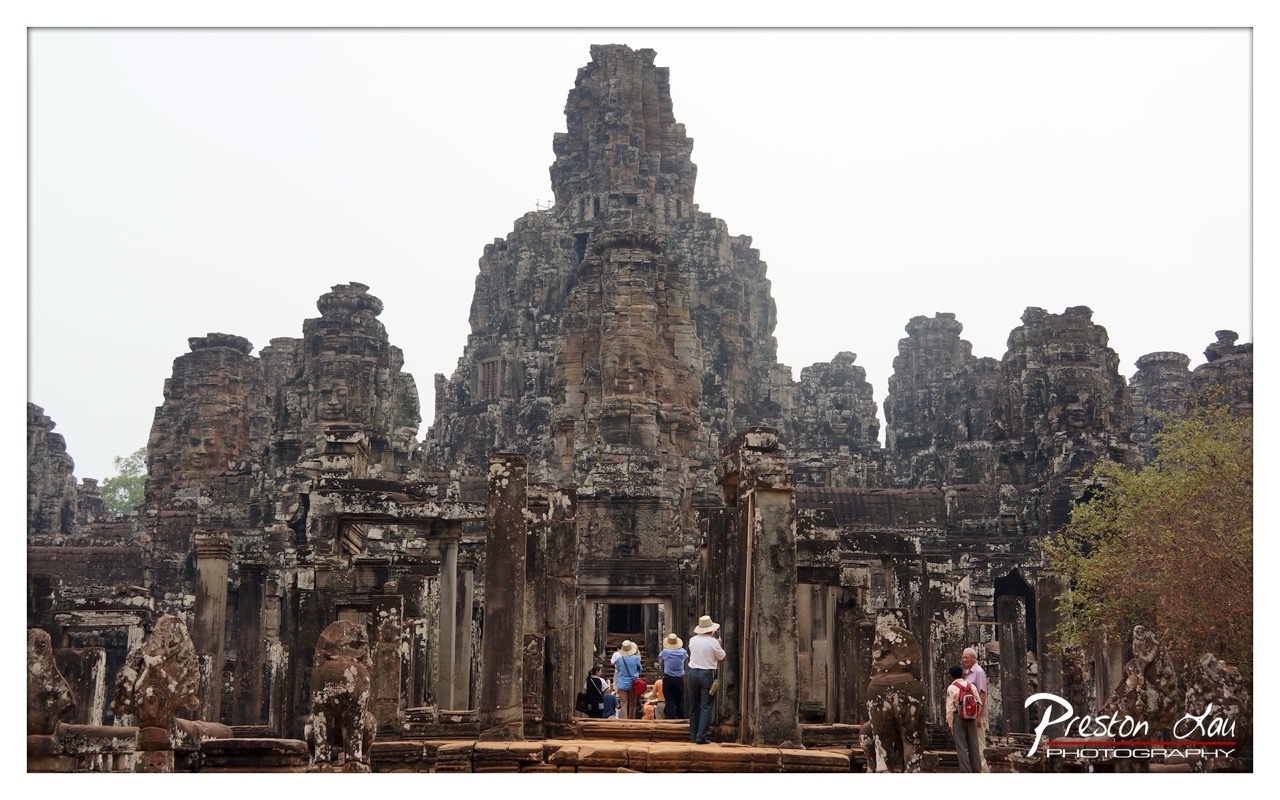

1. Overall Rating (0–10) — 7.0
This photograph captures the enduring grandeur of Angkor Wat’s Bayon temple, where ancient stone faces gaze silently over time. The composition balances the monumental architecture with human scale, grounding the scene in both history and presence. While the overcast sky drains some of the image’s vibrancy, the weathered textures and quiet dignity of the ruins convey a powerful sense of timelessness and reverence.
2. Composition (0–10) — 7.5
The central tower dominates the frame, drawing the eye upward, while the placement of tourists at the base provides narrative scale and depth. The symmetry of the temple’s facade is well-represented, though the slight asymmetry of the people and foreground elements adds naturalism without disrupting balance.
3. Lighting (0–10) — 6.0
The diffuse, overcast light softens shadows and minimizes harsh contrasts, allowing the intricate carvings and textures of the stone to be visible. However, the flat lighting also diminishes the dramatic depth and richness of the scene, lending a muted tone to the overall image.
4. Color & Tone (0–10) — 6.5
The palette is dominated by earthy grays and browns, with subtle variations in tone across the weathered stone. The lack of strong color saturation gives the image a somber, historical feel, appropriate to the site’s age, though a touch more contrast or warmth could enhance visual appeal.
5. Creativity (0–10) — 7.0
The photograph effectively juxtaposes the ancient and the contemporary, using the tourists as a narrative device to emphasize the scale and ongoing relevance of the temple. The framing captures both the architectural majesty and the human connection to the site, offering a layered interpretation of place and memory.
6. Technical Quality (0–10) — 8.0
The image is sharp and well-focused, with fine detail visible in the stonework and textures. The exposure is balanced, and the dynamic range is managed well despite the challenging lighting conditions.
7. Emotional Impact (0–10) — 7.5
There is a quiet awe in the image—both the reverence for the ancient craftsmanship and the contemplative presence of the visitors evoke a deep emotional resonance. The stillness of the scene invites introspection, making the viewer feel a part of a long-standing human tradition of pilgrimage and wonder.
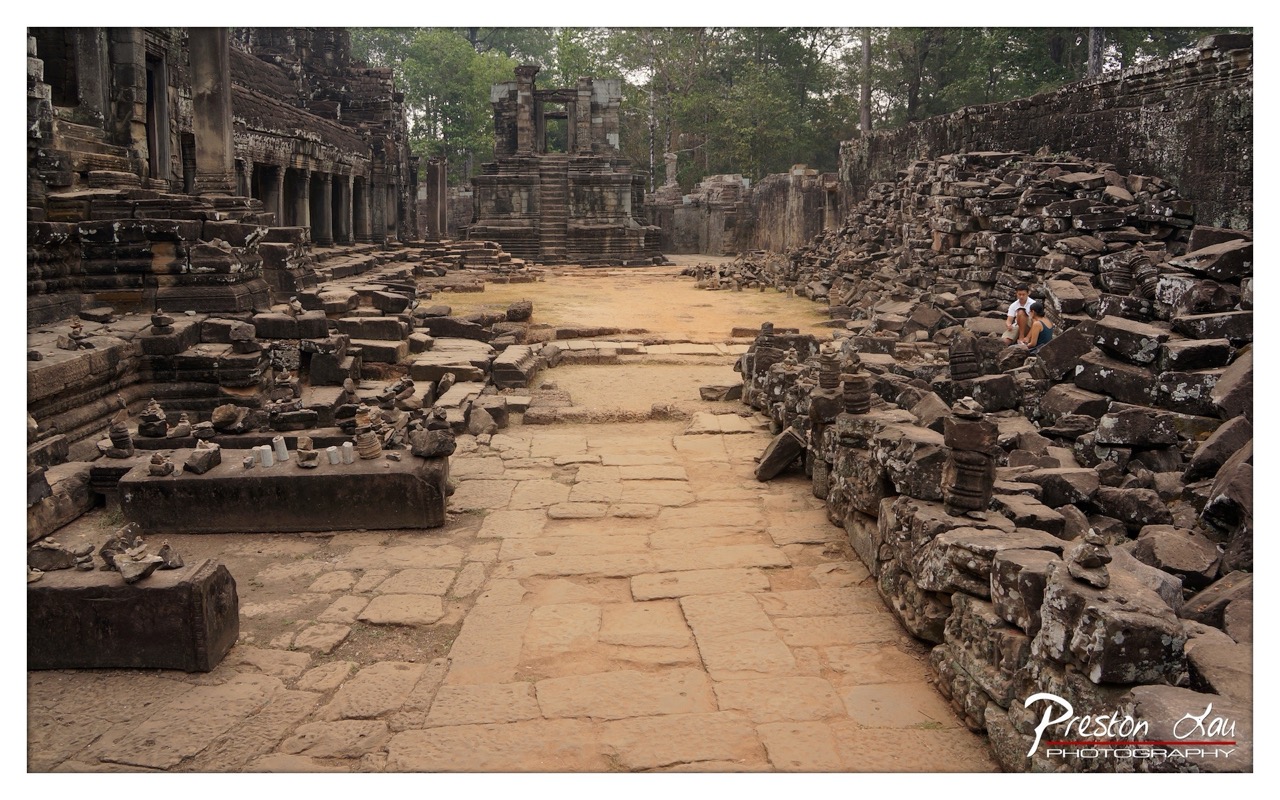

1. Overall Rating (0–10) — 7.0
This photograph captures the solemn grandeur of an ancient temple ruin, where time and nature have claimed their due. The weathered stone, scattered debris, and quiet path evoke a profound sense of history and decay, while the distant figures offer a human scale to the monumental architecture. Though the scene is rich in texture and narrative, the muted lighting and slightly flat color balance temper its emotional resonance, preventing it from fully transcending documentation into poetic contemplation.
2. Composition (0–10) — 7.5
The leading stone path draws the eye into the frame, creating a strong sense of depth and inviting exploration. The placement of the ruins and the small group of people on the right balances the visual weight, while the scattered stone piles on the left add texture and narrative complexity. The slightly asymmetrical framing enhances the organic feel of the ruins, though the right side feels slightly heavier due to the concentration of rubble.
3. Lighting (0–10) — 6.0
The soft, diffused light suggests an overcast day, which minimizes harsh shadows and allows for even exposure across the scene. While this avoids blown highlights, it also flattens the textures of the stone and reduces the dramatic contrast that could elevate the mood. The light feels functional rather than evocative, underscoring the scene’s realism at the cost of atmospheric depth.
4. Color & Tone (0–10) — 6.5
The palette is dominated by earthy browns and grays, consistent with the aged stone and dusty ground. The tones are cohesive and grounded, reinforcing the sense of antiquity. However, the lack of vibrancy—particularly in the greens of the trees and the subtle tones of the stone—makes the image feel somewhat desaturated. A touch of warmth or enhanced contrast could have given the scene more visual energy.
5. Creativity (0–10) — 7.0
The image succeeds in capturing the quiet dignity of a historical site, using composition and scale to tell a story of endurance and loss. The inclusion of the people adds a layer of contemporary life intersecting with the past, a subtle but effective narrative device. While not radically original in concept, the photograph is thoughtful in its framing and intent, offering a reflective perspective on time and memory.
6. Technical Quality (0–10) — 8.0
The image is sharp and well-focused, with clear detail visible in the stone textures and architectural elements. The exposure is balanced, with no significant overexposed or underexposed areas. The slight vignette adds a subtle framing effect, though it is not overpowering. The watermark is discreet and does not detract from the image.
7. Emotional Impact (0–10) — 6.5
The photograph evokes a contemplative mood, inviting the viewer to reflect on the passage of time and the fragility of human achievements. The presence of people adds a touch of life and connection, but their small scale within the vast ruins also emphasizes solitude and impermanence. The emotional pull is strong but restrained, leaving the viewer with a sense of quiet awe rather than profound resonance.
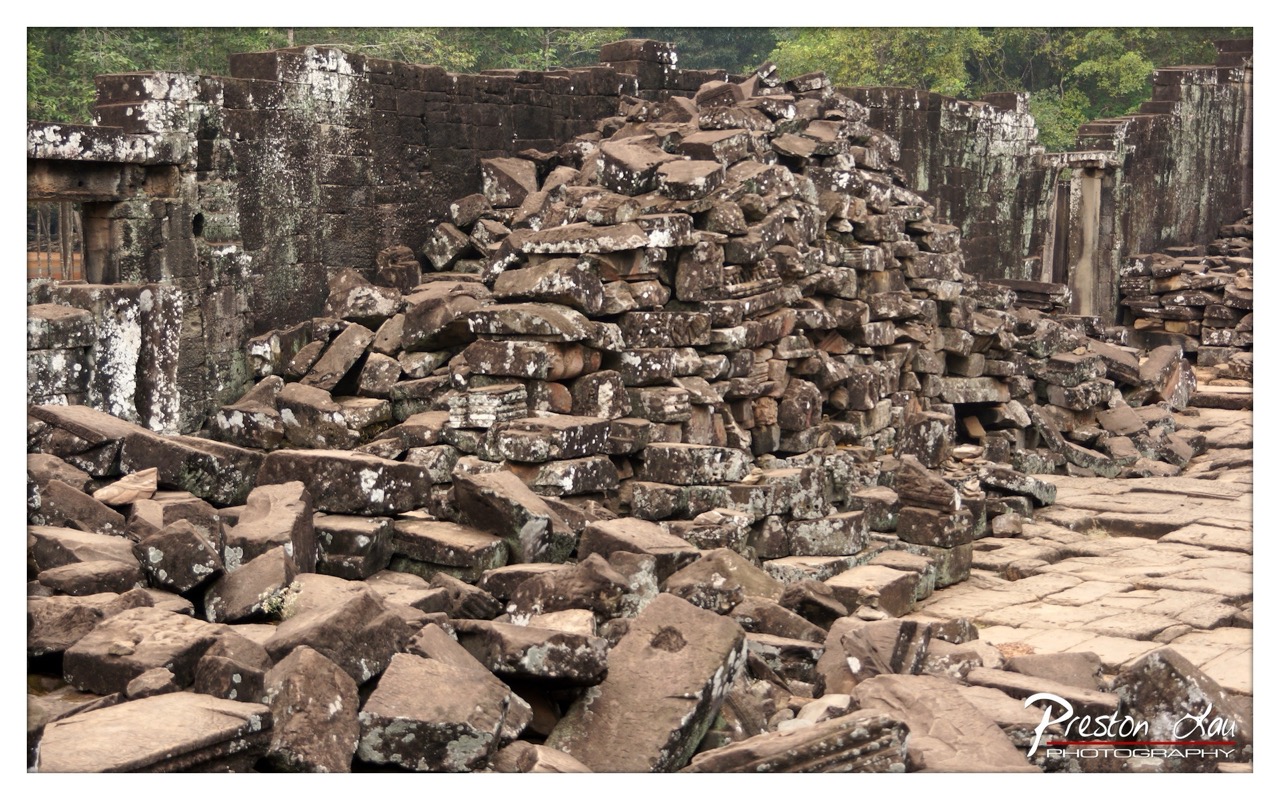

1. Overall Rating (0–10) — 7.0
This photograph captures the haunting grandeur of ancient ruins, where time and nature have reclaimed a once-majestic structure. The scattered stone blocks and moss-covered walls evoke a profound sense of decay and endurance, while the natural light softens the harshness of the wreckage. Though the scene is rich in historical weight, the composition feels slightly overwhelmed by the sheer volume of rubble, slightly diminishing the clarity of the narrative.
2. Composition (0–10) — 6.0
The frame is densely packed with debris, creating visual clutter that distracts from the central structure. The diagonal line of the stone path leads the eye, but the uneven distribution of rubble disrupts balance and diminishes focal clarity.
3. Lighting (0–10) — 6.5
Diffused daylight evenly illuminates the scene, minimizing harsh shadows and allowing texture and detail to emerge. The soft light enhances the weathered surfaces but lacks dramatic contrast, resulting in a subdued, almost documentary tone.
4. Color & Tone (0–10) — 6.0
The palette is dominated by earthy browns and grays, punctuated by patches of green lichen. While the tones are harmonious and natural, the overall desaturation gives the image a muted quality, reducing its visual impact.
5. Creativity (0–10) — 7.0
The image successfully conveys the passage of time through its depiction of ruin and resilience. The choice to focus on the collapsed core of the structure adds narrative depth, though a more deliberate framing could have elevated the storytelling.
6. Technical Quality (0–10) — 7.5
The photograph is sharp and detailed, with clear focus across the frame. The depth of field is well-managed, allowing both foreground and background elements to remain discernible.
7. Emotional Impact (0–10) — 7.5
The scene evokes a quiet melancholy and awe, inviting contemplation of lost civilizations and the impermanence of human achievement. The emotional resonance is strong, grounded in the visual evidence of decay and time’s relentless march.
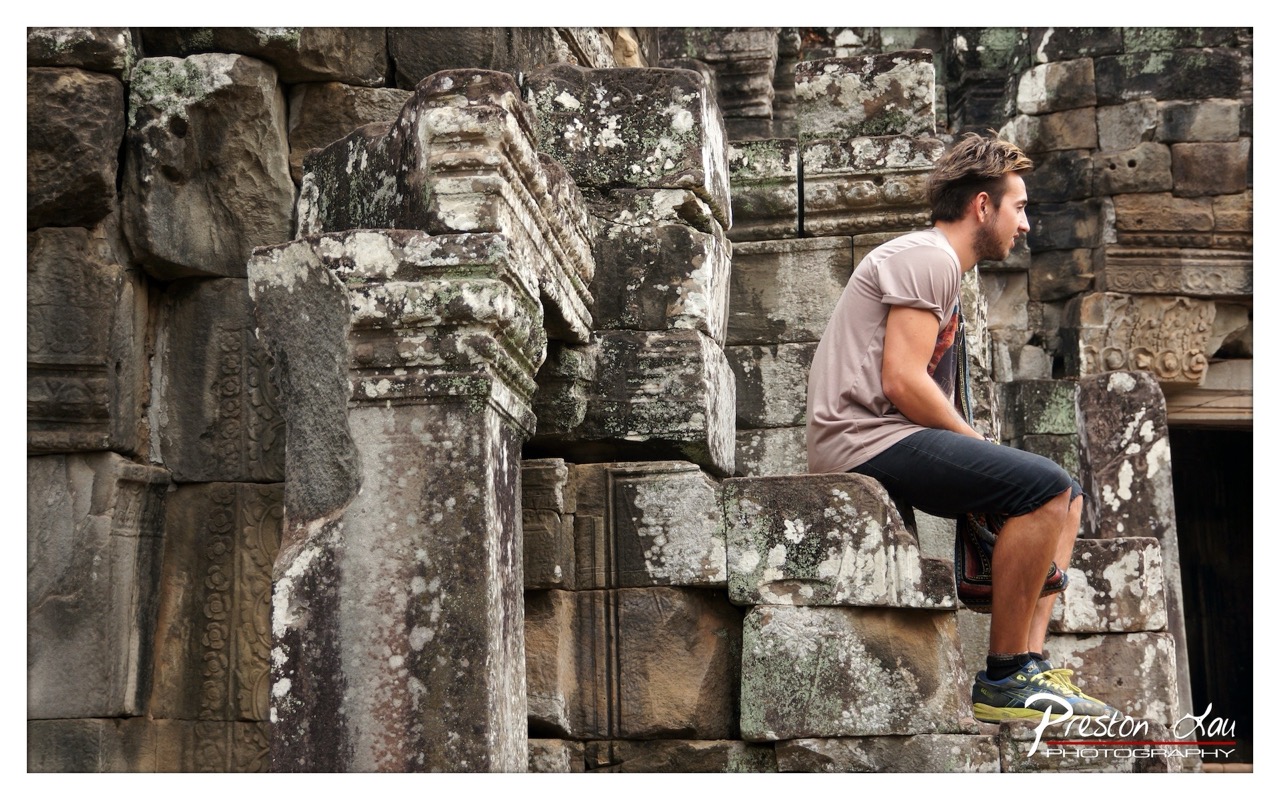

1. Overall Rating (0–10) — 7.5
This photograph captures a contemplative moment at an ancient temple, where the weight of history meets the quiet presence of a modern traveler. The interplay between the weathered stone and the man’s thoughtful gaze creates a sense of timelessness and introspection. While the composition is strong and the subject matter evocative, the image’s emotional depth is slightly restrained by a lack of dramatic lighting and a somewhat conventional framing.
2. Composition (0–10) — 7.0
The subject is placed off-center, creating a balanced yet dynamic composition that draws the eye across the frame. The verticality of the stone column and the layered textures of the temple walls provide visual interest, though the tight framing slightly compresses the sense of scale.
3. Lighting (0–10) — 6.5
Natural daylight illuminates the scene evenly, preserving detail in both highlights and shadows. The light is soft and diffused, which enhances the texture of the stone but lacks the warmth or contrast that would heighten the mood.
4. Color & Tone (0–10) — 7.0
The palette is grounded in earthy tones—browns, grays, and muted greens—that reflect the age and environment of the temple. The subtle contrast between the man’s lighter shirt and the dark stone adds visual separation, while the slight color cast adds a natural, almost nostalgic quality.
5. Creativity (0–10) — 7.5
The image successfully blends human presence with ancient architecture, evoking a narrative of exploration and reflection. The choice to focus on a quiet, introspective moment rather than a grand vista lends the photograph a personal and thoughtful quality.
6. Technical Quality (0–10) — 8.0
The image is sharp and well-focused, with clear detail in the stone textures and the subject’s features. The exposure is balanced, and the depth of field effectively isolates the man from the background while maintaining context.
7. Emotional Impact (0–10) — 7.0
The photograph conveys a sense of solitude and reverence, inviting the viewer to reflect on the passage of time and the human connection to history. While the emotion is subtle, it resonates through the subject’s posture and the quiet dignity of the setting.
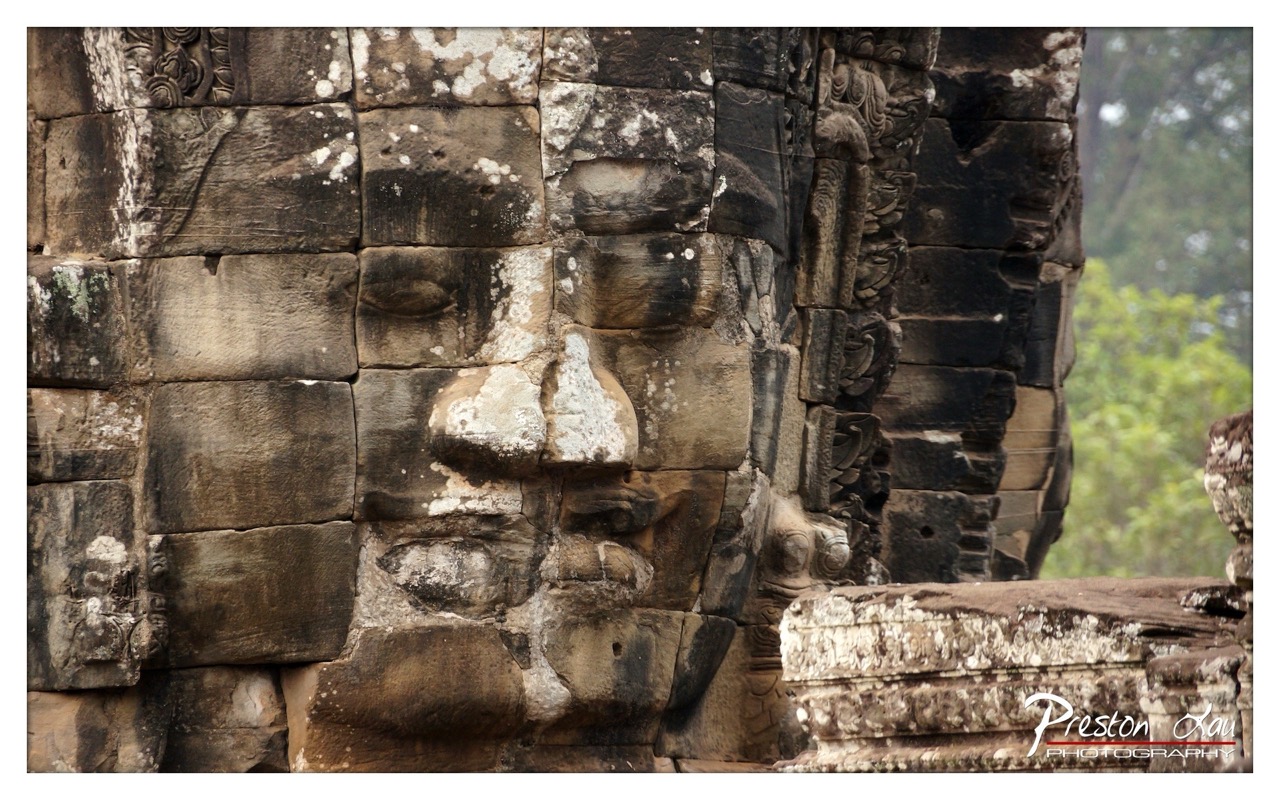

1. Overall Rating (0–10) — 7.5
This photograph captures the solemn grandeur of ancient Khmer stonework, where time and nature have etched their quiet presence into the stone. The weathered face, partially obscured by lichen and erosion, conveys a sense of enduring serenity, while the surrounding carvings add depth and cultural weight. The image balances historical gravity with visual texture, though the slightly overcast lighting tempers its emotional resonance, leaving the viewer with a sense of reverence rather than awe.
2. Composition (0–10) — 7.0
The face is centered slightly off-center, drawing the eye naturally, while the vertical lines of the stonework guide the viewer upward. The inclusion of the carved column and the soft green foliage on the right provides balance and context without distracting from the main subject.
3. Lighting (0–10) — 6.5
Diffused, overcast light softens the scene, minimizing harsh shadows and allowing the textures of the stone to emerge. While the lighting is even and clear, it lacks dramatic contrast, muting the depth and three-dimensionality of the sculpted features.
4. Color & Tone (0–10) — 7.0
The palette is grounded in earthy browns, grays, and muted greens, creating a cohesive and historically resonant atmosphere. The subtle white patches of lichen add visual contrast without disrupting the natural tone, enhancing the sense of age and weathering.
5. Creativity (0–10) — 7.5
The photographer captures a moment of quiet contemplation, emphasizing the spiritual and historical weight of the site. The framing highlights the interplay between man-made artistry and natural decay, offering a narrative of time’s passage.
6. Technical Quality (0–10) — 8.0
The image is sharp and detailed, with excellent focus on the textured surface of the stone. The clarity of the carvings and the fine grain of the weathered blocks are well-rendered, showcasing strong technical execution.
7. Emotional Impact (0–10) — 7.0
There is a meditative stillness to the image, evoking a sense of peace and introspection. The viewer is invited to reflect on the legacy of a civilization, and while the emotional pull is subtle, it lingers in the quiet dignity of the face.
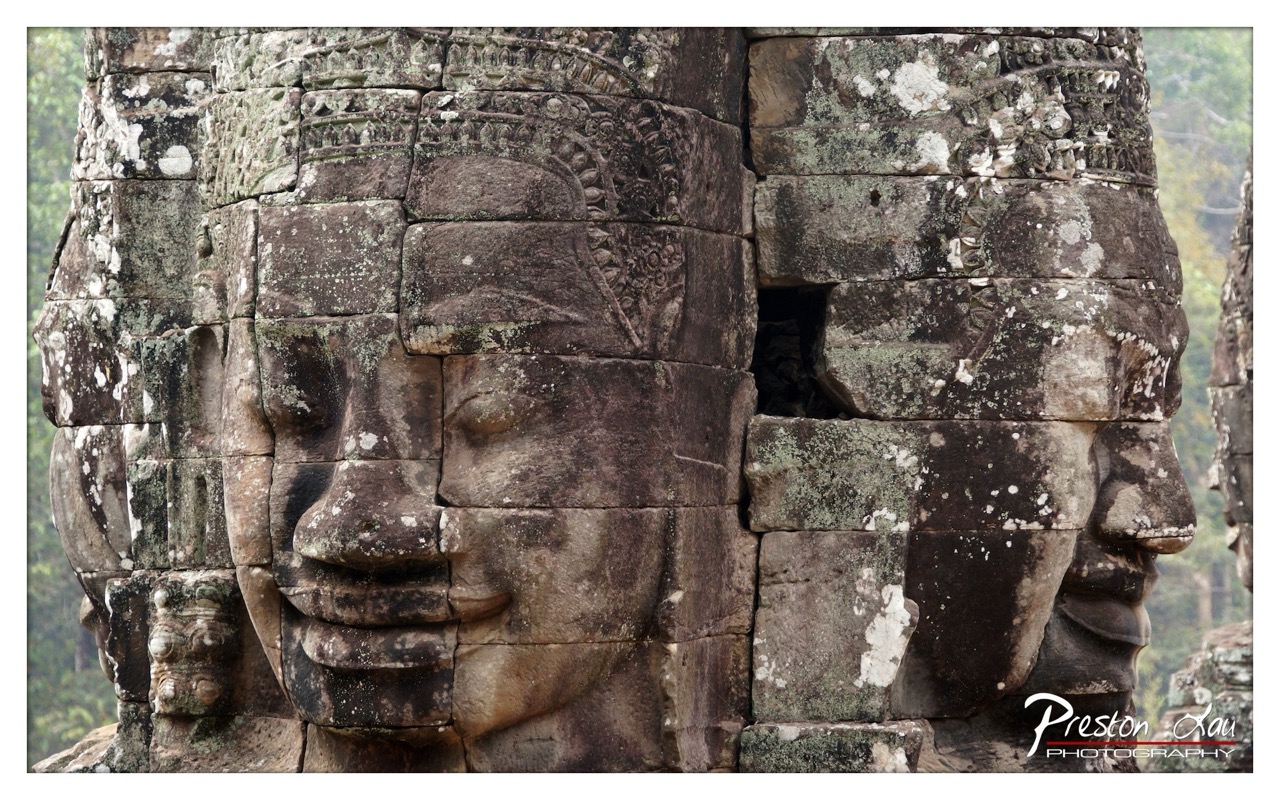

1. Overall Rating (0–10) — 8.0
This photograph captures the solemn grandeur of the Bayon Temple’s stone faces with a quiet reverence that honors their historical weight. The weathered textures and mossy patina speak to centuries of endurance, while the close-up framing draws the viewer into an intimate encounter with ancient craftsmanship. Though the composition is straightforward, the image succeeds in conveying both the awe-inspiring scale and the subtle humanity embedded in the carvings.
2. Composition (0–10) — 7.5
The tight framing centers the primary face, emphasizing its serene expression, while the partial inclusion of adjacent faces creates a sense of continuity and depth. The balance between the central subject and the surrounding stonework guides the eye naturally, though the right side feels slightly more crowded.
3. Lighting (0–10) — 7.0
Soft, diffused light enhances the texture of the stone without creating harsh shadows, allowing the intricate details of the carvings to emerge gently. The overcast conditions lend a contemplative mood, though the lack of strong directional light slightly flattens the three-dimensional quality.
4. Color & Tone (0–10) — 7.5
The muted palette of weathered gray, earthy brown, and greenish lichen creates a natural, aged tone that feels authentic and cohesive. The contrast between the dark stone and the lighter lichen highlights texture and depth without overpowering the scene.
5. Creativity (0–10) — 7.0
While the subject is iconic and well-documented, the photographer’s choice to focus on the interplay of texture and weathering offers a fresh perspective. The image feels less like a tourist snapshot and more like a meditative study of time and decay.
6. Technical Quality (0–10) — 8.5
Sharp focus across the face reveals fine details in the stone carvings, and the image is free from noticeable noise or blur. The clean white border and subtle watermark add a professional finish.
7. Emotional Impact (0–10) — 8.0
The stillness of the carved faces, combined with the sense of age and mystery, evokes a deep sense of contemplation and connection to the past. The viewer is invited to reflect on the enduring presence of human creation, even in the face of time and ruin.
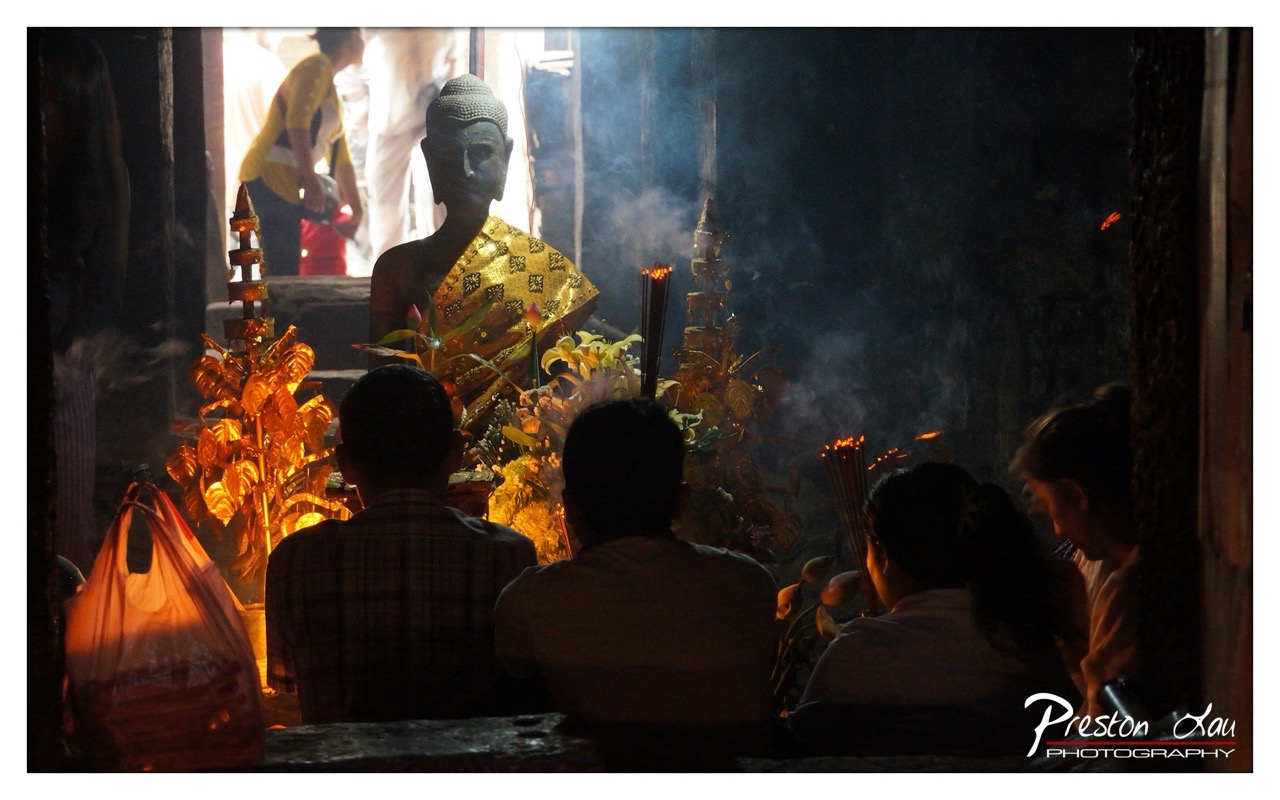

1. Overall Rating (0–10) — 7.5
This photograph captures a deeply reverent moment within a dimly lit temple, where the interplay of light, smoke, and silhouette evokes a profound sense of spiritual stillness. The warm glow of incense and offerings contrasts with the darkened space, drawing the viewer into a quiet act of devotion. While the composition leans slightly toward chaos due to the clutter of offerings, the image succeeds in conveying the intimacy and solemnity of a ritual in progress.
2. Composition (0–10) — 6.5
The silhouetted figures in the foreground create a strong sense of depth, leading the eye toward the Buddha statue and the glowing altar. However, the arrangement of incense sticks and offerings on the right feels slightly overcrowded, and the plastic bag in the lower left disrupts the visual harmony.
3. Lighting (0–10) — 8.0
The use of directional backlighting from the doorway creates dramatic silhouettes and highlights the golden robe of the Buddha and the rising smoke. The warm, flickering light from the incense adds a dynamic, almost sacred glow, enhancing the mood without overexposing the scene.
4. Color & Tone (0–10) — 7.5
The dominant warm tones of gold, amber, and orange create a cohesive and spiritual atmosphere, while the deep shadows add contrast and gravitas. The subtle coolness of the smoke and background provides a gentle balance, allowing the warm elements to stand out with emotional resonance.
5. Creativity (0–10) — 7.0
The photographer captures a candid, unposed moment of worship, using light and shadow to elevate a common ritual into something transcendent. The inclusion of both the worshippers and the sacred space within a single frame tells a story of devotion and cultural continuity.
6. Technical Quality (0–10) — 8.0
The image is sharp where it matters—particularly on the Buddha statue and the glowing elements—while the silhouettes remain well-defined. The long exposure manages the motion of the smoke and flames effectively, though some fine details in the shadows are lost.
7. Emotional Impact (0–10) — 8.0
There is a palpable sense of peace and reverence that resonates through the image. The viewer is drawn into the quiet intimacy of the moment, feeling the weight of tradition and the quiet devotion of those present. The smoke and light evoke a spiritual transcendence that lingers after viewing.
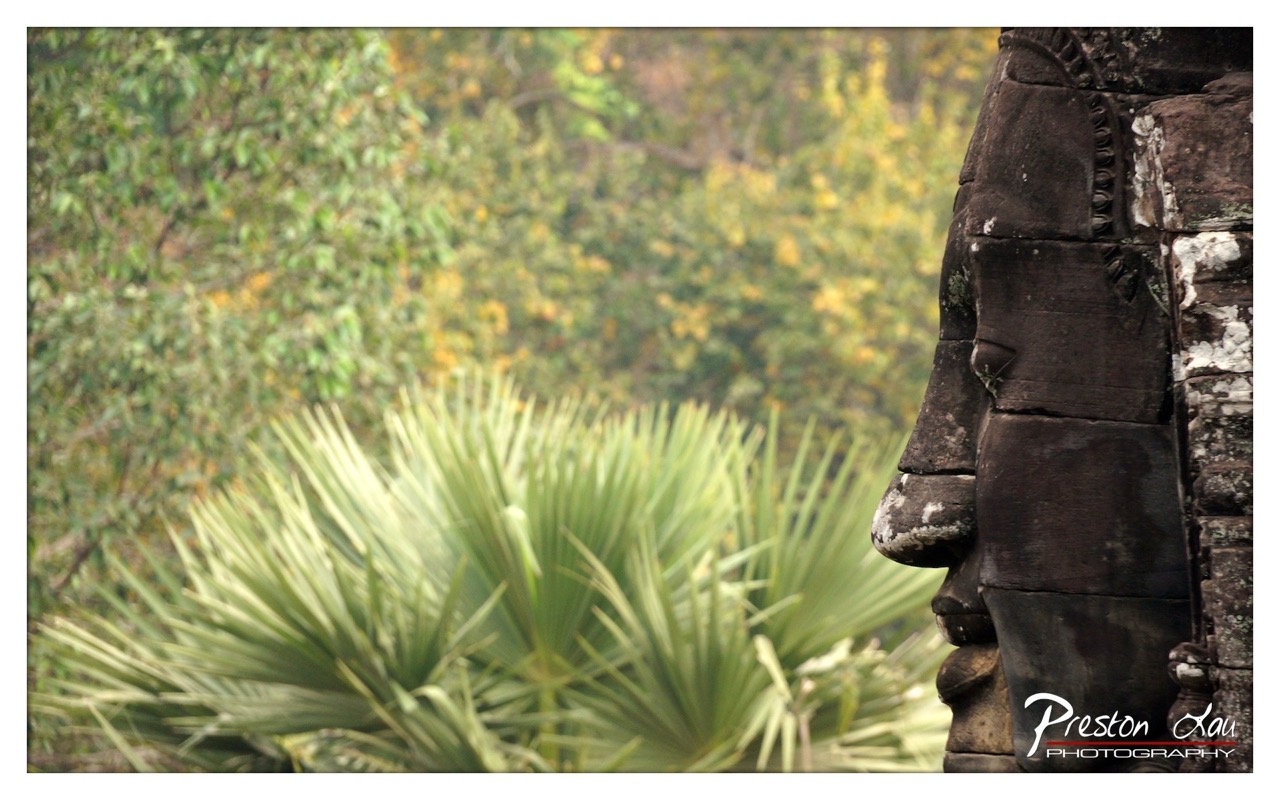

1. Overall Rating (0–10) — 7.5
This photograph captures a serene and contemplative moment at an ancient temple, where the weathered stone face merges with the surrounding jungle. The soft focus on the background and the deliberate framing create a sense of timelessness and quiet reverence. While the image successfully evokes a mood of mystery and historical depth, its visual impact is slightly restrained by the flat lighting and a lack of dynamic contrast in the foreground foliage.
2. Composition (0–10) — 8.0
The subject is placed along the right third of the frame, allowing space for the lush foliage to breathe and guide the eye toward the stone face. The diagonal line of the face and the palm fronds create a subtle visual rhythm, enhancing the image’s compositional balance.
3. Lighting (0–10) — 6.0
The light is diffused and even, likely from an overcast sky, which softens shadows and lends a muted tone to the scene. While this suits the contemplative mood, it also reduces the depth and texture of the stone carving, leaving the image feeling somewhat flat.
4. Color & Tone (0–10) — 7.0
The palette is dominated by earthy greens and grays, creating a natural and harmonious tone. The subtle yellow tones in the background foliage add a gentle warmth, while the overall desaturation enhances the ancient, weathered feel of the subject.
5. Creativity (0–10) — 8.0
The choice to frame the face partially, with the natural environment as a foreground element, adds narrative depth. It invites interpretation—suggesting the temple as a living part of the landscape—demonstrating a thoughtful and evocative approach to travel photography.
6. Technical Quality (0–10) — 7.5
The focus is sharp on the stone face, with a shallow depth of field that elegantly blurs the background. The image is clear and well-exposed, with no visible noise or distortion, showcasing solid technical execution.
7. Emotional Impact (0–10) — 8.0
The image stirs a sense of awe and quiet reflection, drawing the viewer into a meditative space between nature and ancient human creation. The stillness of the face, juxtaposed with the organic movement of the plants, evokes a powerful emotional resonance with time and memory.
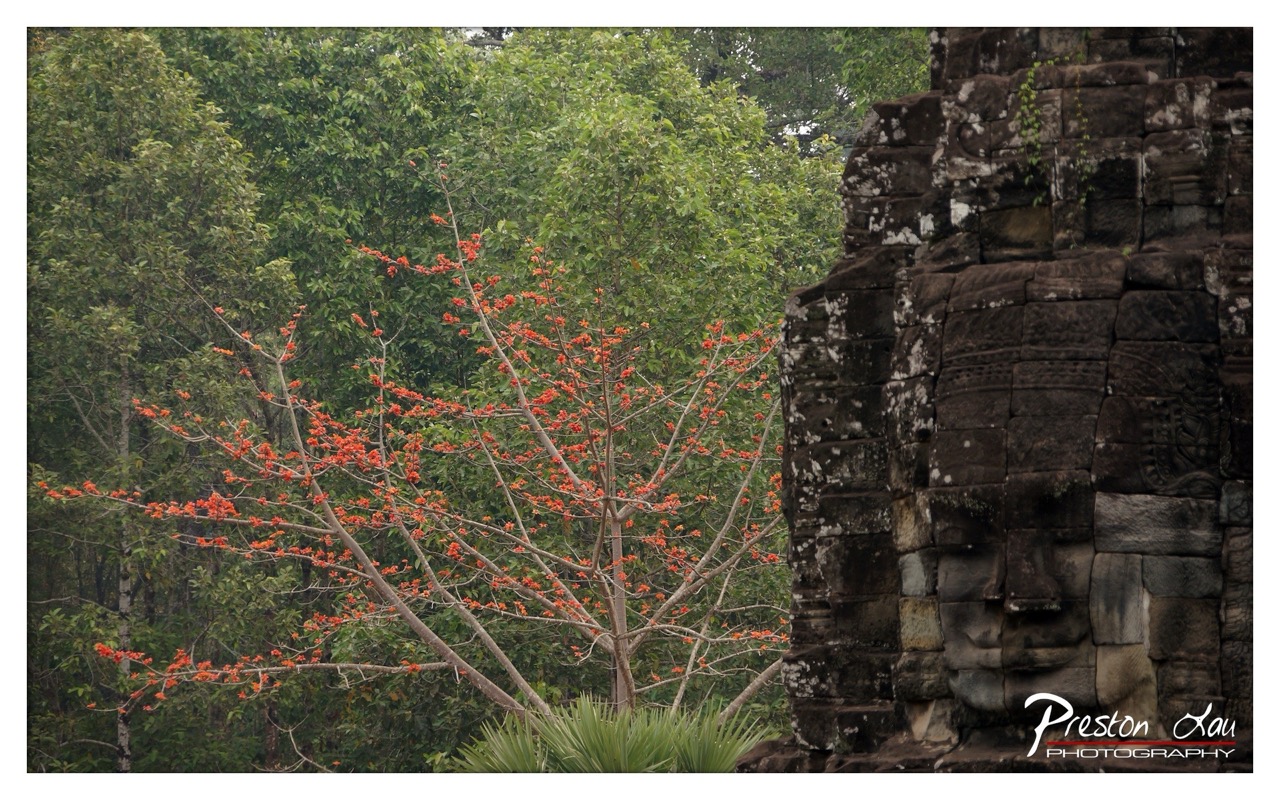

1. Overall Rating (0–10) — 7.5
This photograph captures a striking juxtaposition between the enduring stillness of ancient stone and the vibrant pulse of life in a flowering tree. The contrast between the weathered temple wall and the bright orange blossoms creates a powerful visual narrative of nature reclaiming history. While the image is rich in symbolic depth, its muted lighting and slightly overcast atmosphere temper its emotional intensity, preventing it from achieving full visual resonance.
2. Composition (0–10) — 7.0
The framing balances the organic spread of the flowering tree against the rigid geometry of the stone structure, creating a dynamic tension. The diagonal placement of the tree draws the eye through the frame, while the inclusion of the temple wall grounds the image in historical context. A tighter crop might enhance focus, but the current composition effectively conveys the relationship between nature and ruin.
3. Lighting (0–10) — 6.0
Soft, diffused light from an overcast sky evenly illuminates the scene but lacks the dramatic highlights and shadows that could deepen the texture of the stonework and enhance the vibrancy of the blossoms. The lighting is functional and naturalistic, though it slightly flattens the image’s atmospheric potential.
4. Color & Tone (0–10) — 7.5
The rich, saturated orange of the flowers stands out vividly against the cool, earthy tones of the stone and the deep greens of the forest backdrop. This contrast creates a compelling visual anchor. The overall tonal range is balanced, with the darker tones of the ruins providing a dramatic base for the bright floral accents.
5. Creativity (0–10) — 8.0
The image demonstrates strong conceptual intent, using the contrast between life and decay as a metaphor for time and resilience. The choice of subject—flourishing flora against ancient ruins—elevates the photograph beyond mere documentation into a poetic reflection on history and renewal.
6. Technical Quality (0–10) — 8.0
The image is sharp and well-focused, particularly in the midground where the tree and stonework meet. The detail in the texture of the weathered blocks and the delicate blossoms is clear and crisp. The exposure is balanced, with no blown highlights or lost shadows.
7. Emotional Impact (0–10) — 7.0
There’s a quiet melancholy and reverence in the image, evoking a sense of time’s passage and the quiet persistence of life. While the subdued lighting keeps the emotional tone contemplative rather than overwhelming, the visual harmony between the elements creates a lingering sense of beauty and poignancy.
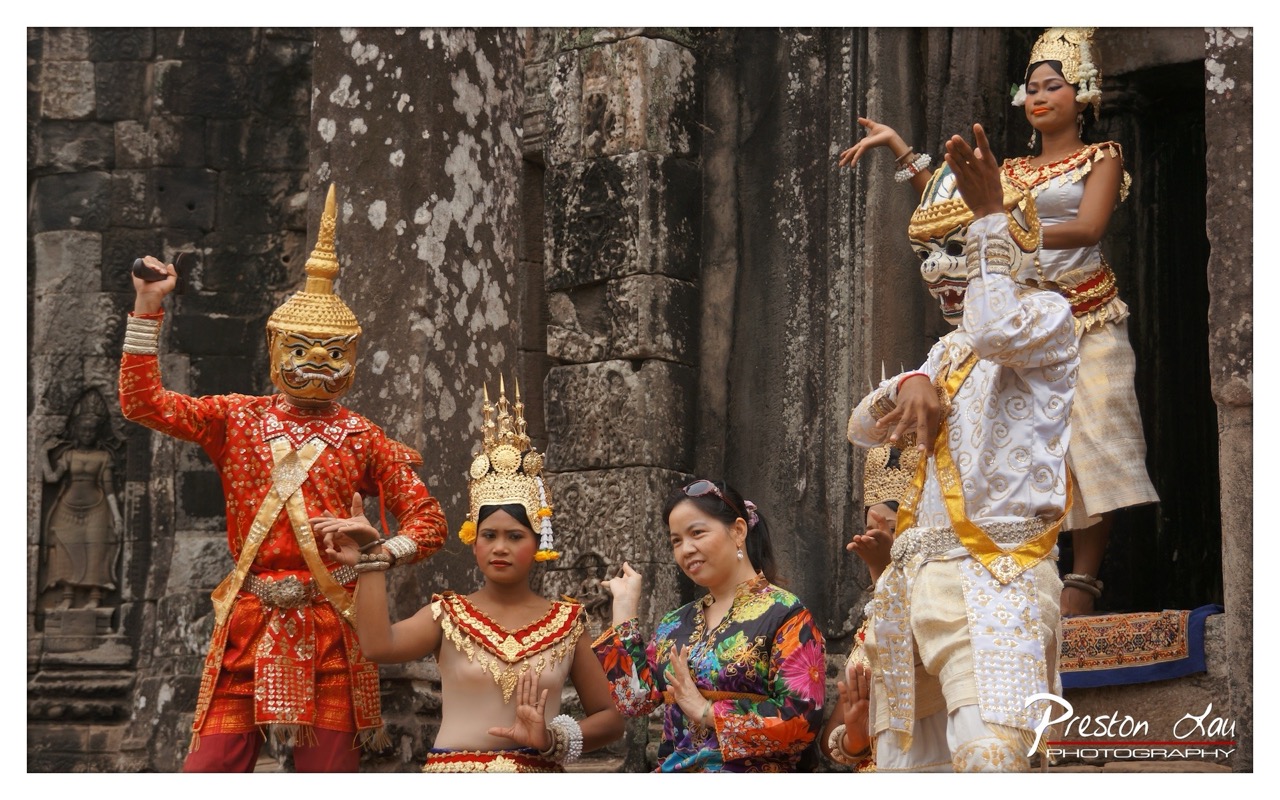

1. Overall Rating (0–10) — 7.5
This photograph captures a vibrant moment of traditional Cambodian dance, rich with cultural depth and visual energy. The contrast between the ornate costumes and the ancient stone backdrop creates a compelling dialogue between past and present. While the composition is dynamic and the colors vivid, the slightly cluttered arrangement of figures reduces the clarity of the central narrative, keeping the image from achieving full artistic cohesion.
2. Composition (0–10) — 6.5
The framing includes multiple figures, resulting in a crowded foreground that divides attention. The central dancer in gold is well-placed, but the inclusion of the woman in the colorful blouse disrupts the traditional aesthetic and creates visual imbalance.
3. Lighting (0–10) — 7.0
Natural daylight illuminates the scene evenly, highlighting the textures of the costumes and the weathered stonework. The light is soft enough to avoid harsh shadows, enhancing the details of the intricate headdresses and fabric.
4. Color & Tone (0–10) — 8.0
The warm golds, deep reds, and rich whites of the costumes create a striking contrast against the muted grays of the temple. The color palette is harmonious and expressive, enhancing the ceremonial atmosphere of the performance.
5. Creativity (0–10) — 8.0
The juxtaposition of traditional performance against the ancient temple setting is both powerful and original. The inclusion of the woman in modern clothing adds an intriguing layer, suggesting a bridge between tradition and contemporary life.
6. Technical Quality (0–10) — 8.5
Sharp focus and high detail are evident throughout, particularly in the facial expressions and costume textures. The image is well-exposed, with no significant loss of detail in highlights or shadows.
7. Emotional Impact (0–10) — 7.5
The image evokes a sense of cultural pride and continuity, capturing both the solemnity and joy of the performance. The viewer is drawn into the moment, feeling the rhythm and reverence of the dance, though the cluttered composition slightly dampens the emotional resonance.
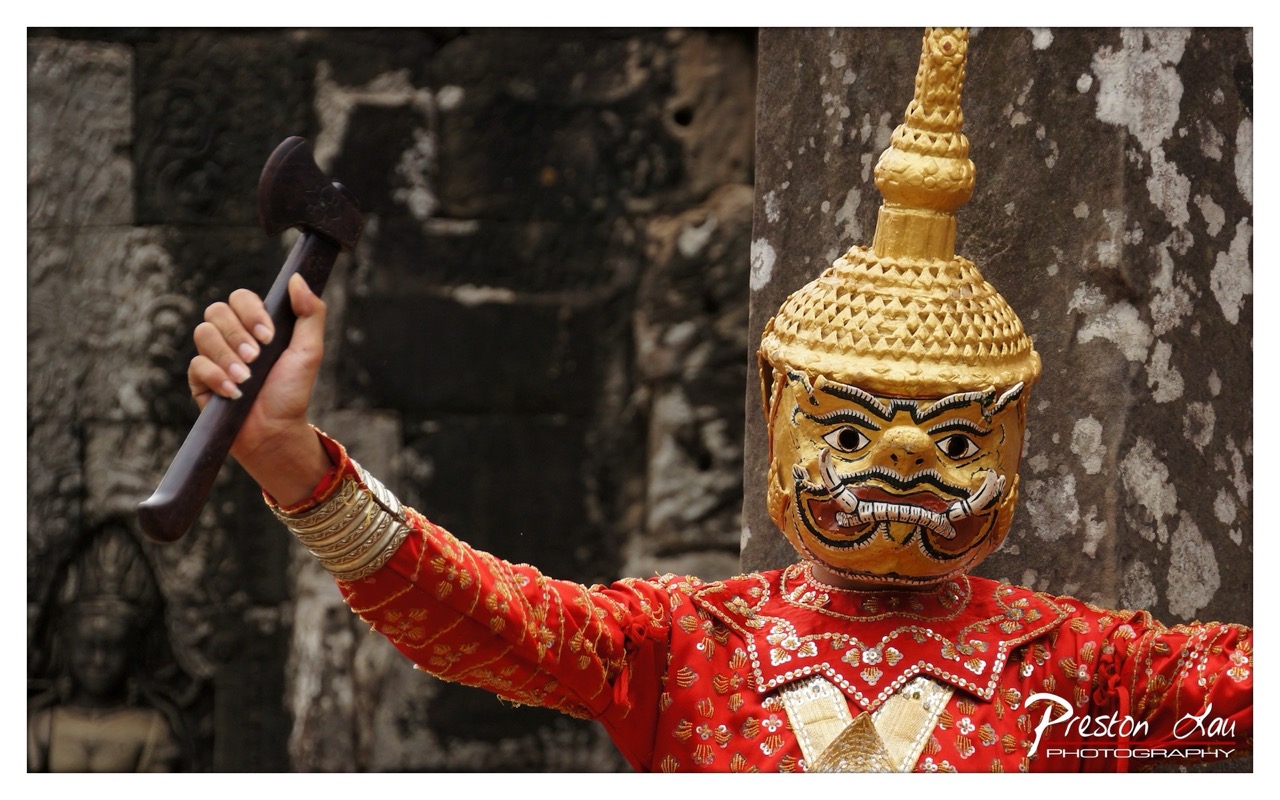

1. Overall Rating (0–10) — 8.0
This photograph captures the dramatic intensity of a traditional Cambodian performance, where mythic power is embodied in the ornate mask and ceremonial axe. The vibrant red and gold costume contrasts strikingly with the weathered stone background, creating a compelling visual dialogue between ancient ritual and enduring architecture. While the composition is strong, a slightly tighter crop could further emphasize the performer’s commanding presence and the symbolic weight of the moment.
2. Composition (0–10) — 8.0
The subject is well-placed with the mask and raised axe drawing immediate attention, while the textured stone wall provides depth and cultural context. The framing balances the figure and background effectively, though a slight shift in angle might enhance the sense of movement.
3. Lighting (0–10) — 7.5
Natural light illuminates the subject evenly, highlighting the rich textures of the costume and mask without harsh shadows. The soft, directional light enhances the three-dimensionality of the mask and gives the gold a warm glow.
4. Color & Tone (0–10) — 8.5
The bold red and golden tones of the costume pop against the muted grays of the stone, creating a dynamic and culturally resonant palette. The color harmony is strong, with the warm tones evoking a sense of tradition and reverence.
5. Creativity (0–10) — 8.0
The image successfully merges performance art with historical architecture, suggesting a living tradition rooted in a sacred space. The choice to capture the moment mid-gesture adds narrative tension and cultural authenticity.
6. Technical Quality (0–10) — 8.5
Sharp focus on the mask and costume ensures clarity, while the shallow depth of field effectively blurs the background, drawing attention to the subject. The image is well-exposed and free of technical flaws.
7. Emotional Impact (0–10) — 8.0
The image conveys a sense of power, devotion, and cultural continuity. The intensity of the mask’s expression and the performer’s raised weapon evoke awe and mystery, inviting the viewer to reflect on the stories embedded in the ritual.
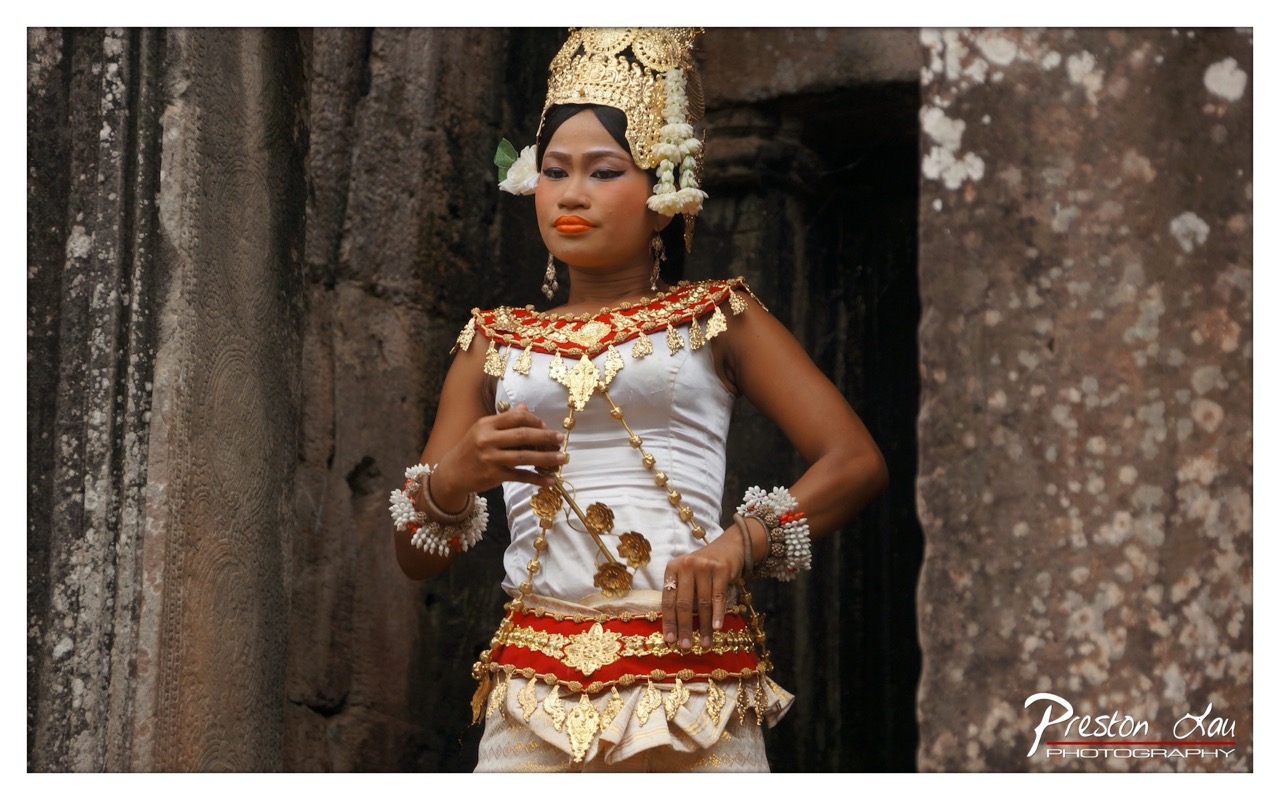

1. Overall Rating (0–10) — 8.0
This photograph captures the regal elegance of a traditional Cambodian dancer poised within the ancient stones of Angkor Wat, where history and artistry converge. The subject’s elaborate costume and serene expression radiate cultural richness, while the weathered temple backdrop adds depth and authenticity. The image is visually striking and emotionally resonant, though the slightly heavy-handed color saturation tempers its subtlety.
2. Composition (0–10) — 8.0
The dancer is centered and framed by the temple’s stone pillars, creating a balanced, portrait-like composition that draws focus to her ornate attire. The depth provided by the textured background enhances the sense of place and scale.
3. Lighting (0–10) — 7.0
Soft, diffused light illuminates the subject evenly, highlighting the gold details of her costume without harsh shadows. The lighting complements the mood, creating a dignified and timeless atmosphere.
4. Color & Tone (0–10) — 7.5
The warm tones of gold and red in the costume contrast beautifully with the cool, earthy hues of the stone. While the colors are vibrant, the saturation is slightly pushed, giving the image a stylized rather than natural feel.
5. Creativity (0–10) — 8.5
The fusion of traditional performance with an iconic historical setting demonstrates strong conceptual intent. The image transcends mere documentation, telling a story of cultural endurance and artistic grace.
6. Technical Quality (0–10) — 8.5
Sharp focus on the dancer’s face and costume ensures clarity, while the depth of field effectively isolates her from the background. The image is technically sound and well-executed.
7. Emotional Impact (0–10) — 8.0
There is a quiet dignity and reverence in the dancer’s expression and posture, evoking a deep sense of respect for tradition. The viewer is invited to reflect on the enduring beauty of cultural heritage.
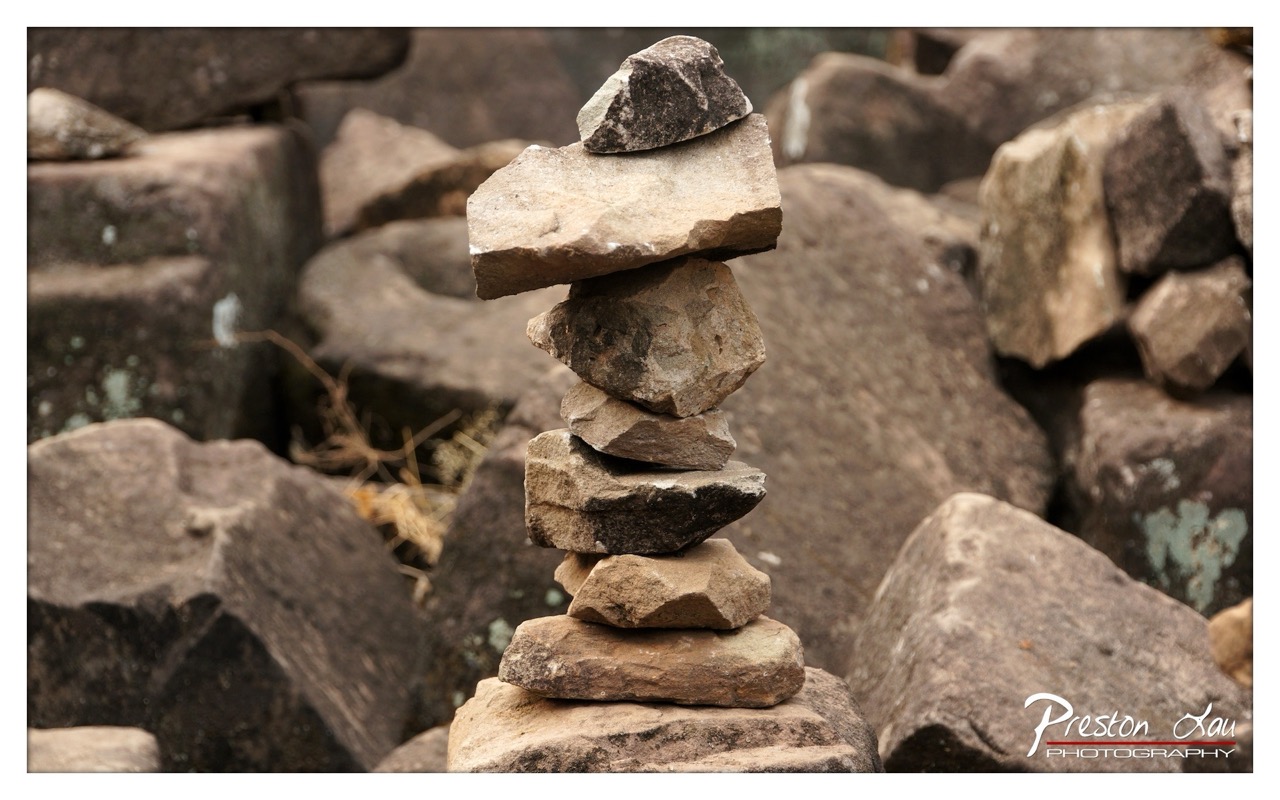

1. Overall Rating (0–10) — 7.0
This photograph captures a delicate balance of nature and intention, with a carefully stacked stone cairn standing as a quiet focal point amidst a rugged, untamed landscape. The composition draws the eye upward along the tower, emphasizing both the fragility and strength of the arrangement. While the muted tones and soft focus lend a contemplative mood, the image’s power lies in its subtle tension between order and chaos—though a more deliberate use of contrast and depth could elevate its emotional resonance.
2. Composition (0–10) — 7.5
The cairn is centered with strong vertical emphasis, creating a natural focal point. The surrounding rocks form a textured, layered background that adds depth without distracting from the subject.
3. Lighting (0–10) — 6.5
Soft, diffused light evenly illuminates the scene, preserving texture without harsh shadows. While the lighting is even, it lacks directional warmth, slightly flattening the mood.
4. Color & Tone (0–10) — 6.0
The palette is restrained—earthy browns, grays, and muted ochres—conveying a natural, grounded atmosphere. However, the lack of vibrancy reduces visual impact, giving the image a slightly muted quality.
5. Creativity (0–10) — 7.0
The cairn as a subject offers a strong metaphor for balance and patience. The photographer’s choice to isolate it within a chaotic landscape adds narrative depth, though the execution remains conventional.
6. Technical Quality (0–10) — 8.0
Sharp focus on the cairn ensures clarity, with a shallow depth of field that blurs the background effectively. The image is clean, well-exposed, and free of technical flaws.
7. Emotional Impact (0–10) — 6.5
The image evokes quiet contemplation and stillness, inviting reflection on impermanence and human presence in nature. The emotional pull is subtle, resting on the viewer’s interpretation of the cairn’s meaning.
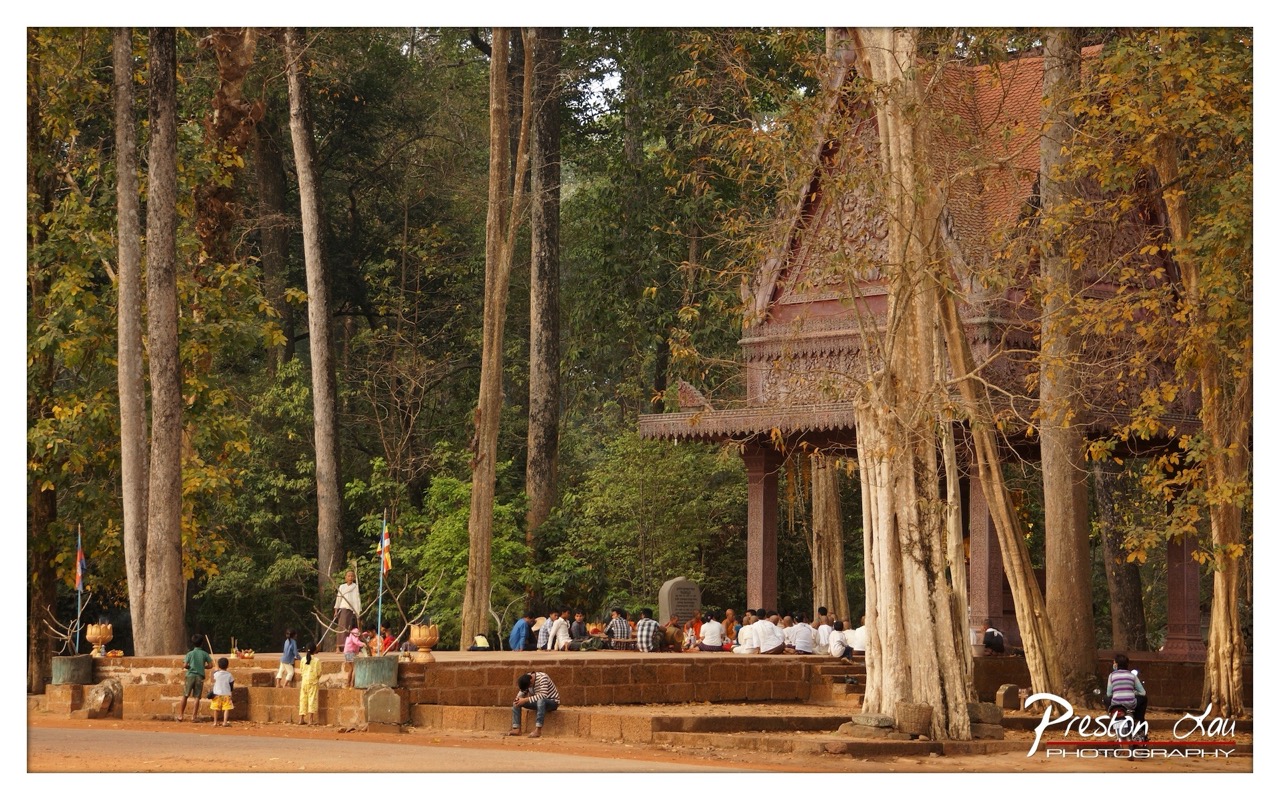

1. Overall Rating (0–10) — 7.5
This photograph captures a serene moment of communal gathering at a temple nestled within a forested landscape, evoking a sense of cultural continuity and spiritual calm. The warm, golden light enhances the rich textures of the wooden architecture and surrounding trees, while the presence of people—some seated, some in motion—adds a quiet vitality to the scene. While the composition is strong and the atmosphere deeply resonant, the slightly cluttered foreground and minor distractions in the frame prevent it from achieving complete visual harmony.
2. Composition (0–10) — 7.0
The image is framed with a natural balance, using the trees as leading lines toward the temple and the gathering. The placement of figures on the steps creates a layered depth, though the scattered elements in the lower-left corner slightly disrupt the visual flow.
3. Lighting (0–10) — 8.5
The soft, golden-hour light bathes the scene in warmth, enhancing the textures of the temple and foliage while casting gentle shadows that add dimension. The direction of the light enhances the mood, suggesting a tranquil morning or late afternoon.
4. Color & Tone (0–10) — 8.0
The palette is rich with earthy tones—ochre, deep green, and warm brown—creating a cohesive and harmonious visual experience. The contrast between the bright orange roof and the surrounding foliage adds subtle vibrancy without overwhelming the natural aesthetic.
5. Creativity (0–10) — 7.5
The photograph successfully blends cultural documentation with artistic sensitivity, capturing both the environment and the human element in a way that feels authentic and evocative. The choice to include everyday life within a sacred space adds narrative depth.
6. Technical Quality (0–10) — 8.5
The image is sharp and clear, with fine detail visible in the temple’s carvings and the surrounding trees. The exposure is well-managed, preserving detail in both highlights and shadows, and the focus is consistent throughout the frame.
7. Emotional Impact (0–10) — 8.0
The scene elicits a sense of peace and reverence, drawing the viewer into a moment of quiet reflection. The presence of people engaged in ritual or community fosters a connection to tradition and shared humanity, making the image emotionally resonant.
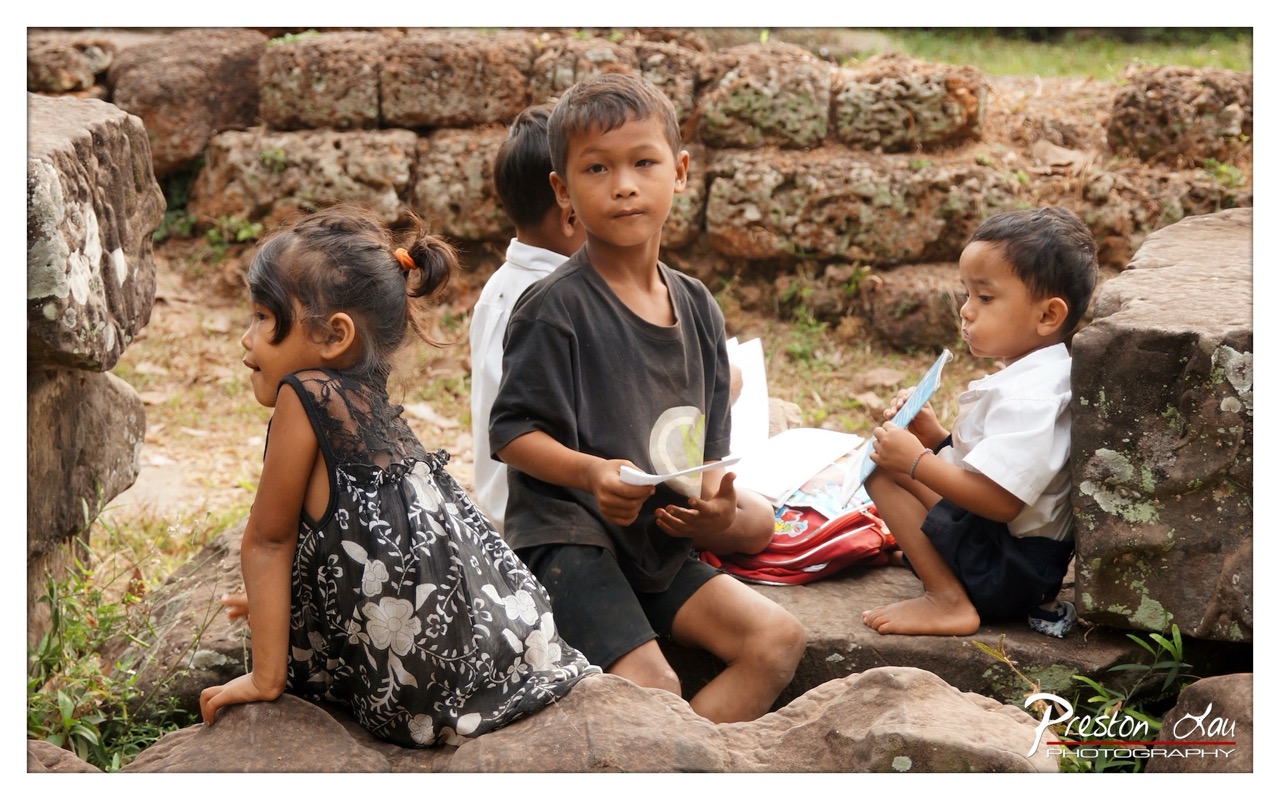

1. Overall Rating (0–10) — 7.0
This photograph captures a quiet, candid moment of three children amidst ancient stone ruins, evoking a sense of timelessness and youthful curiosity. The natural interaction—between the girl in lace, the boy with the paper, and the youngest absorbed in his book—feels authentic and unposed, grounding the image in a narrative of everyday life. While the composition and lighting are strong, a slightly more intentional framing could elevate the emotional resonance, but as it stands, the image is a compelling blend of culture, childhood, and place.
2. Composition (0–10) — 7.0
The subjects are well-placed along a diagonal axis, leading the eye from the girl on the left to the boy on the right, creating visual flow. The ruins provide a textured, layered backdrop that adds depth without overwhelming the children. The slight asymmetry and the use of negative space around the edges help frame the scene naturally.
3. Lighting (0–10) — 7.0
Soft, diffused daylight illuminates the scene evenly, preserving detail in both the children’s faces and the stone textures. The light enhances the mood without creating harsh shadows, allowing the natural expressions and colors to come through with clarity and warmth.
4. Color & Tone (0–10) — 6.5
The palette is earthy and grounded, with muted browns and greens from the stone and foliage complementing the children’s clothing. The contrast between the black-and-white dress and the bright red backpack adds a subtle pop of color, though the overall tonal range could be slightly more vibrant to enhance visual engagement.
5. Creativity (0–10) — 7.5
The juxtaposition of modern children engaged in simple activities against ancient, moss-covered ruins creates a compelling narrative. The photographer captures a moment that feels both intimate and culturally rich, blending the present with the past in a way that feels authentic and thoughtfully observed.
6. Technical Quality (0–10) — 8.0
The image is sharp and well-focused, particularly on the central boy’s face, with clear detail in the fabric textures and stone surfaces. The depth of field is well-controlled, keeping the children in focus while softly blurring the background, which helps separate the subjects from the environment.
7. Emotional Impact (0–10) — 7.0
There’s a gentle, reflective quality to the image—the children’s quiet focus, the stillness of the ruins, and the sense of a moment suspended in time. It evokes a sense of nostalgia and connection, inviting the viewer to consider the continuity of life across generations in a place of enduring history.
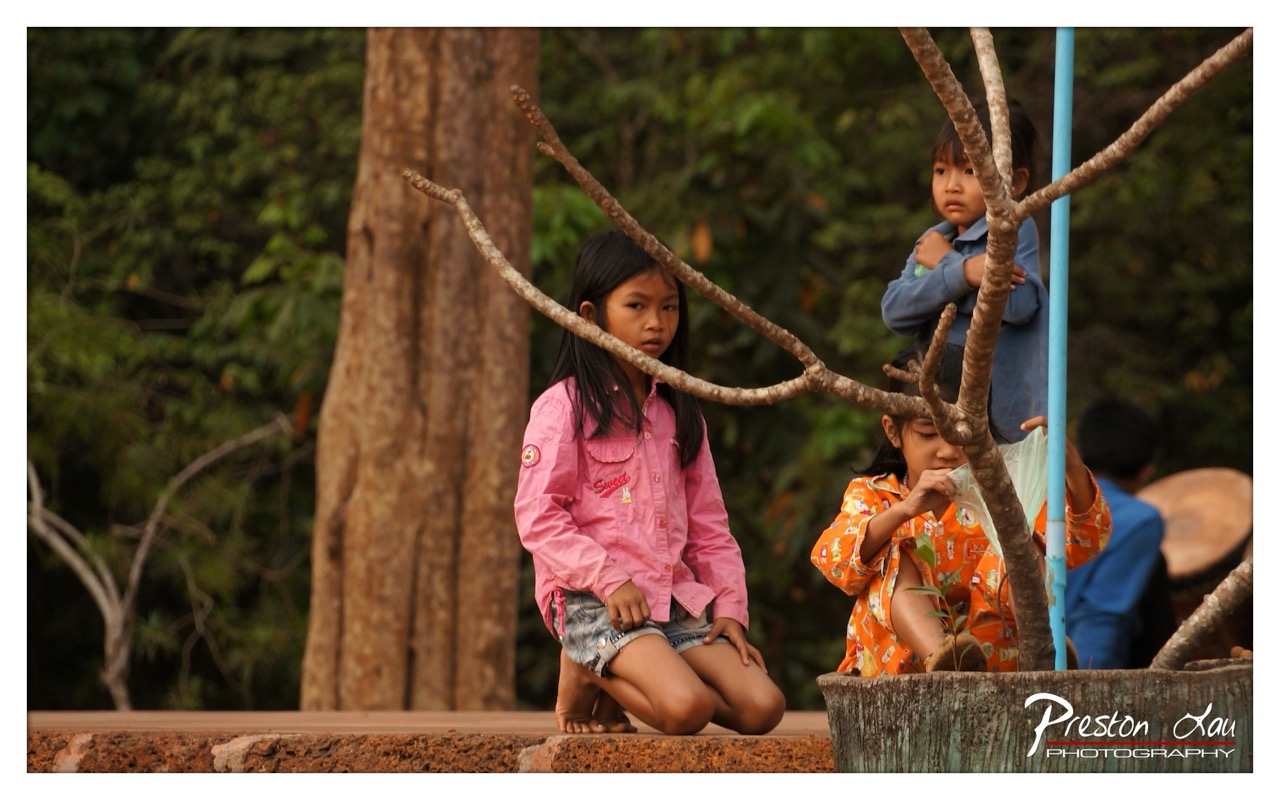

Error: HTTP 400 — {
"error": {
"message": "Failed to load model \\"qwen/qwen3-vl-30b\\". Error: Operation canceled.",
"type": "invalid_request_error",
"param": "model",
"code": null
}
}
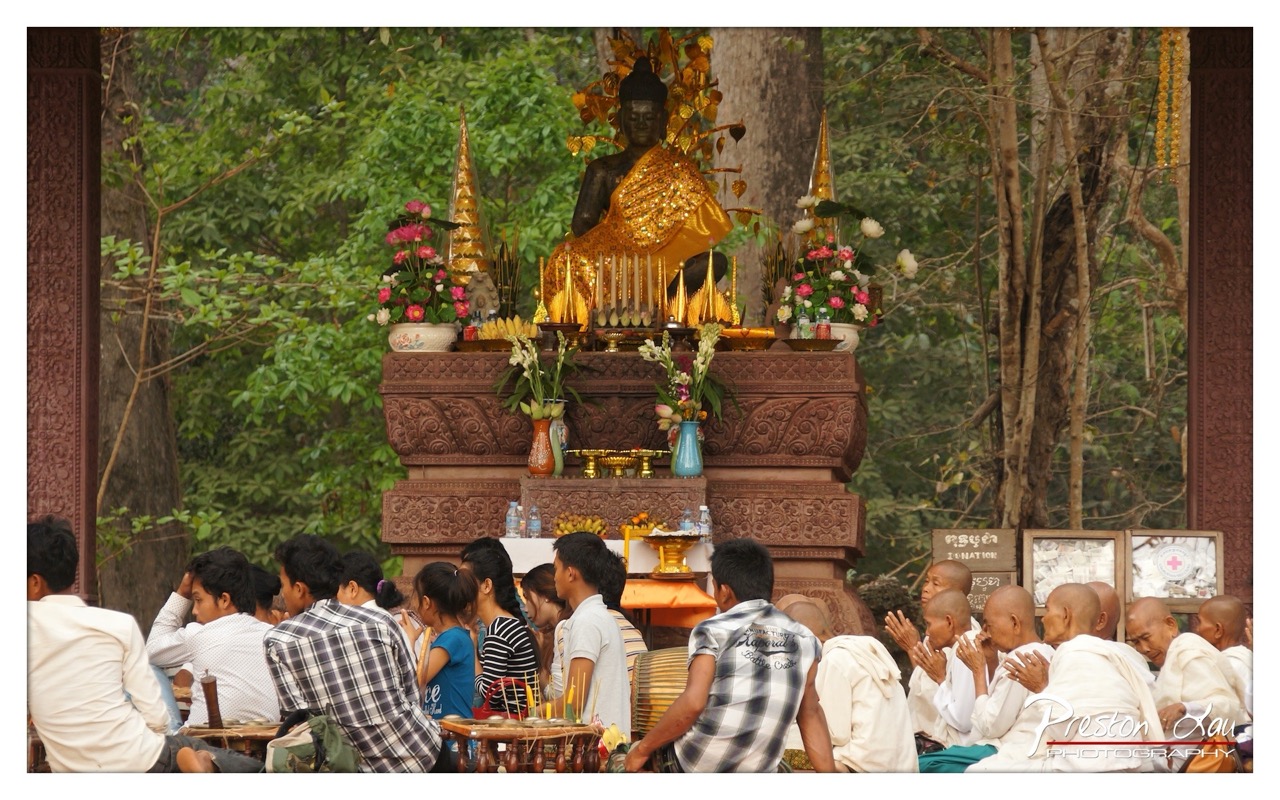

Error: HTTP 400 — {
"error": {
"message": "Failed to load model \\"qwen/qwen3-vl-30b\\". Error: Operation canceled.",
"type": "invalid_request_error",
"param": "model",
"code": null
}
}
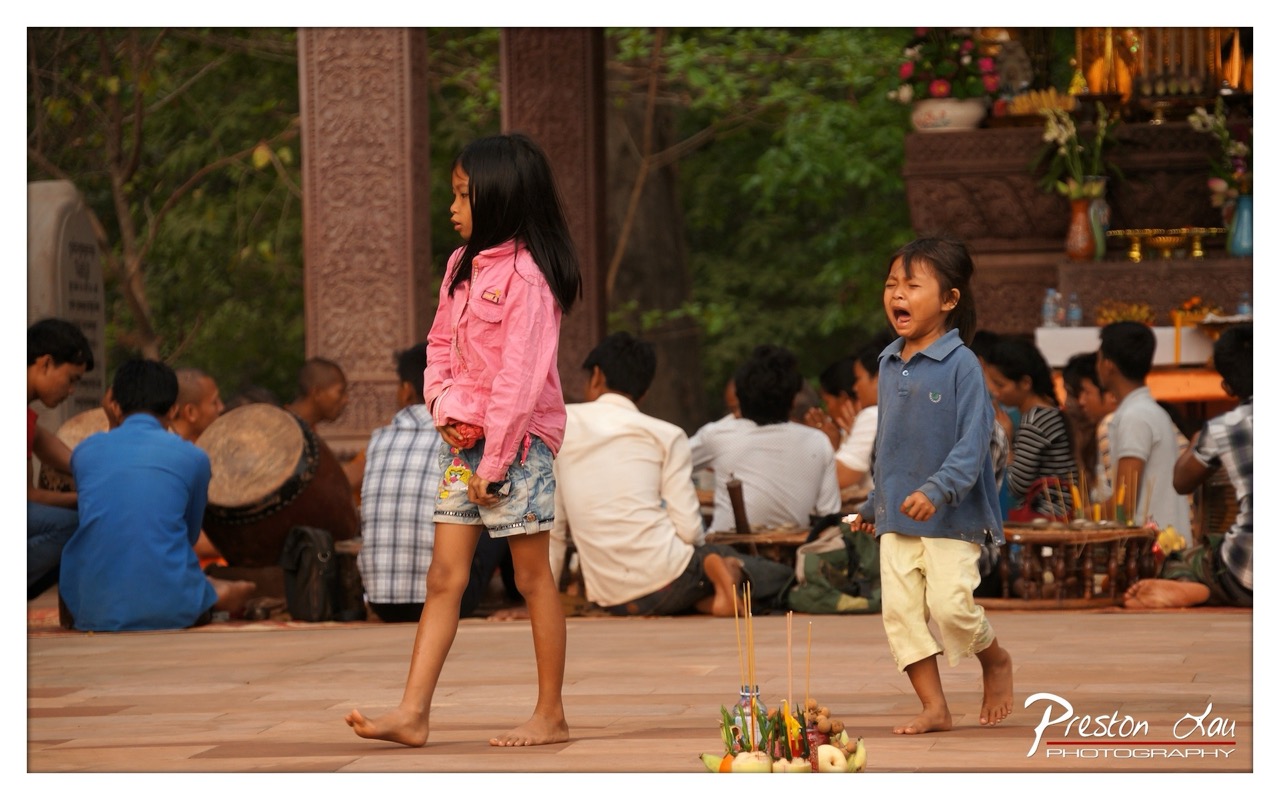

Error: HTTP 400 — {
"error": {
"message": "Failed to load model \\"qwen/qwen3-vl-30b\\". Error: Operation canceled.",
"type": "invalid_request_error",
"param": "model",
"code": null
}
}
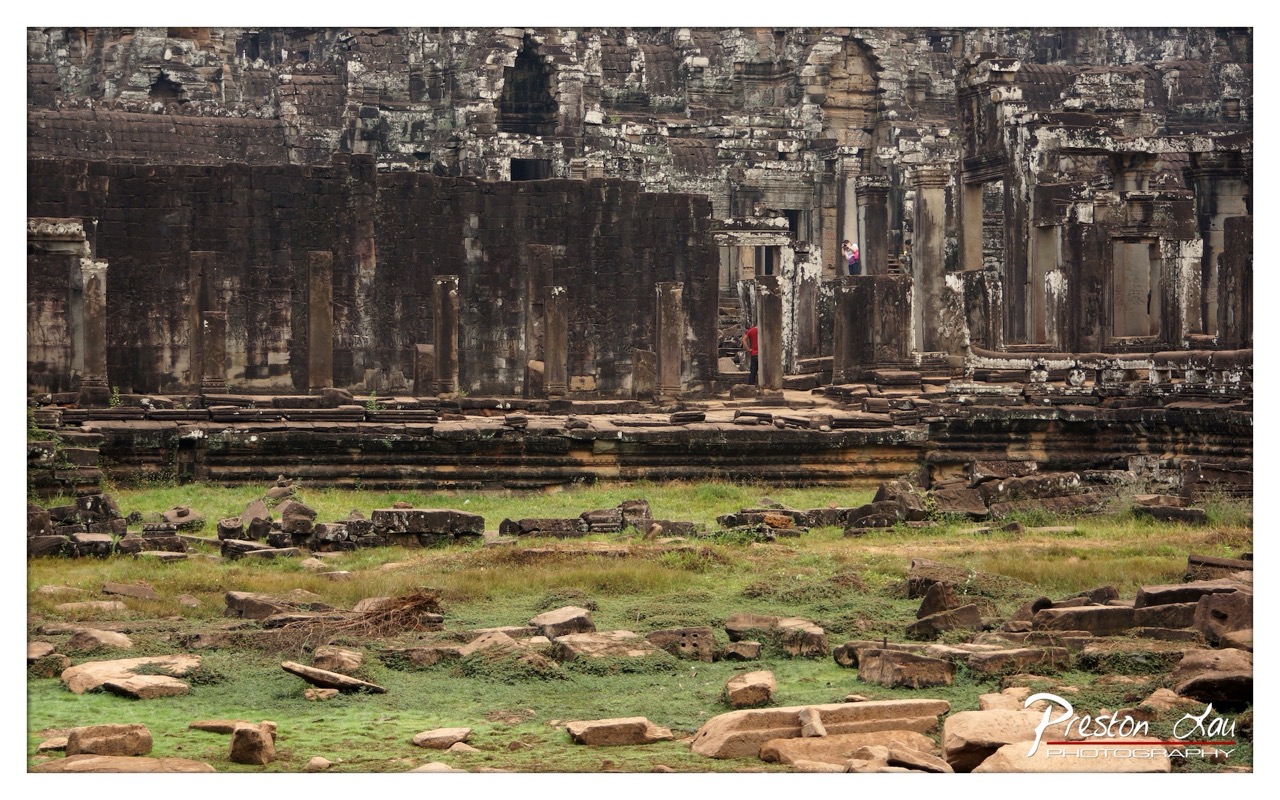

Error: HTTP 400 — {
"error": {
"message": "Failed to load model \\"qwen/qwen3-vl-30b\\". Error: Operation canceled.",
"type": "invalid_request_error",
"param": "model",
"code": null
}
}
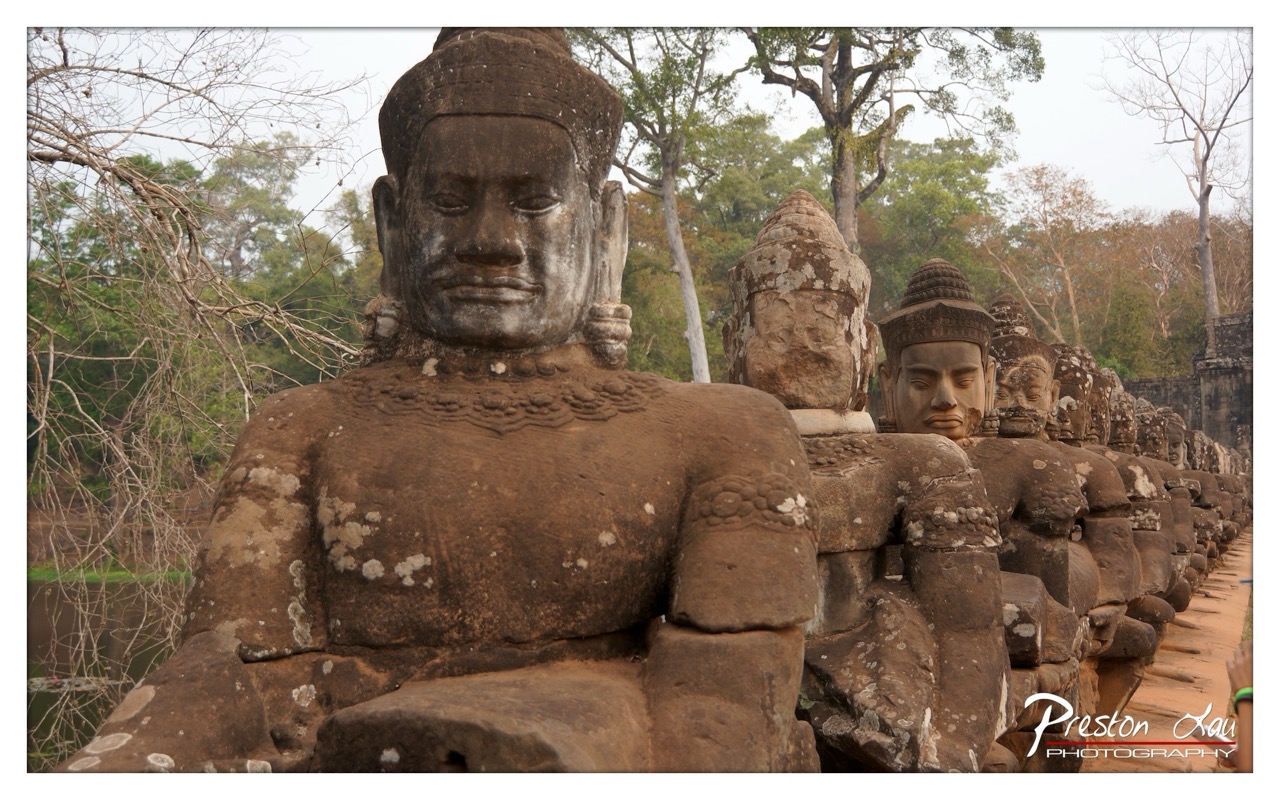

Error: HTTP 400 — {
"error": {
"message": "Failed to load model \\"qwen/qwen3-vl-30b\\". Error: Operation canceled.",
"type": "invalid_request_error",
"param": "model",
"code": null
}
}
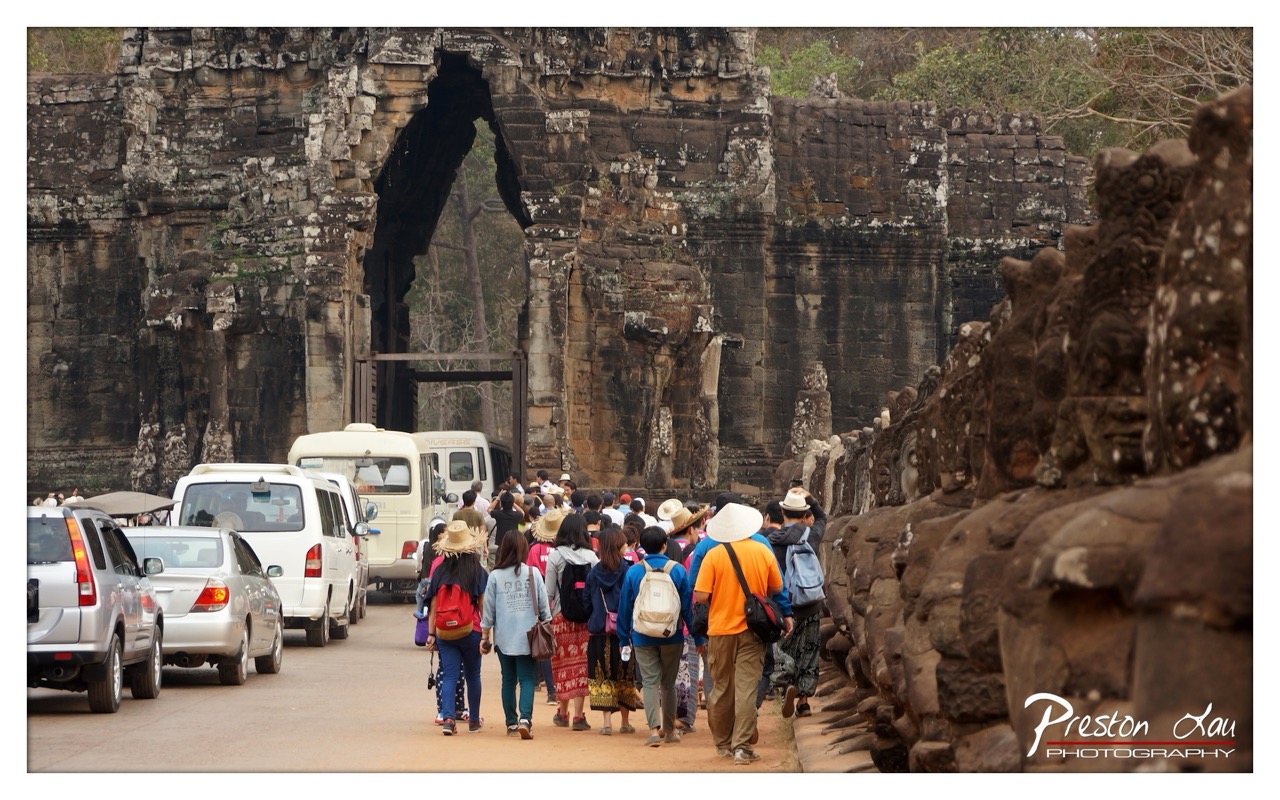

Error: HTTP 400 — {
"error": {
"message": "Failed to load model \\"qwen/qwen3-vl-30b\\". Error: Operation canceled.",
"type": "invalid_request_error",
"param": "model",
"code": null
}
}
Loading map...